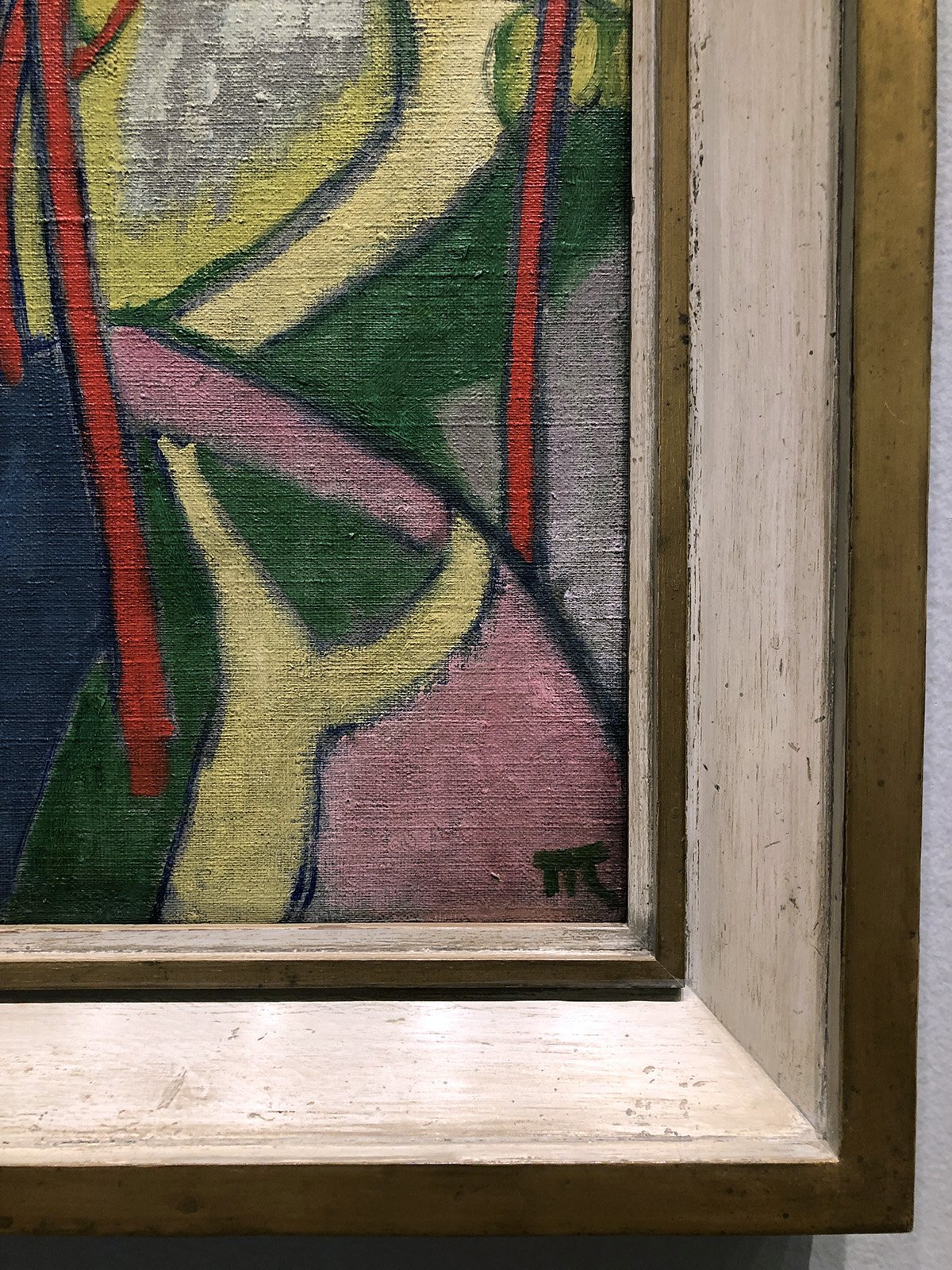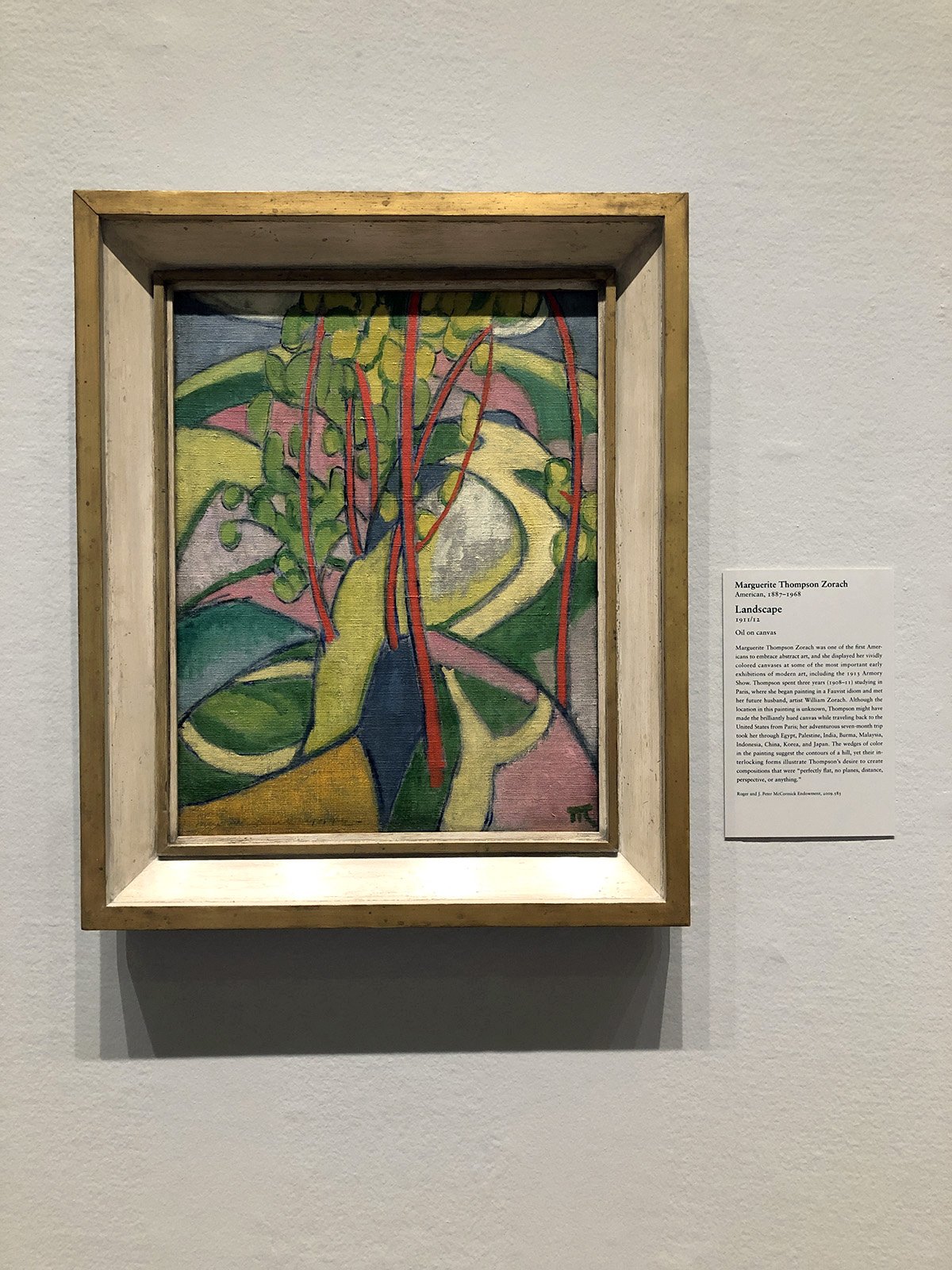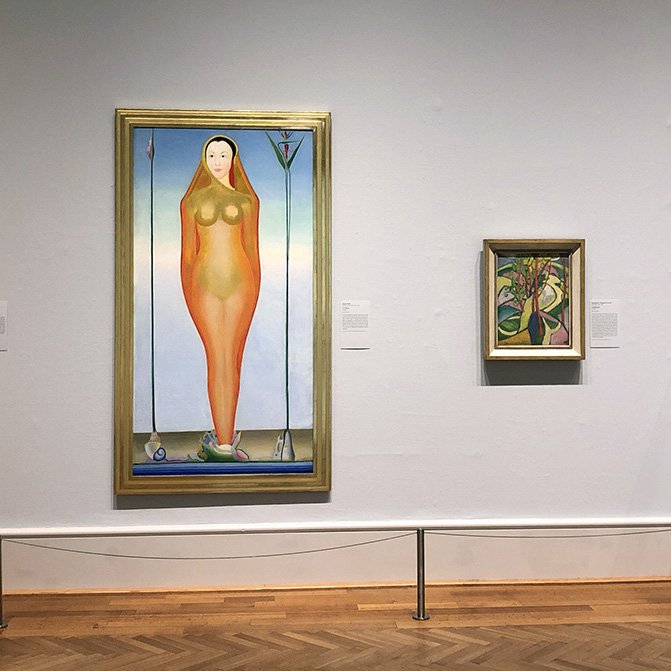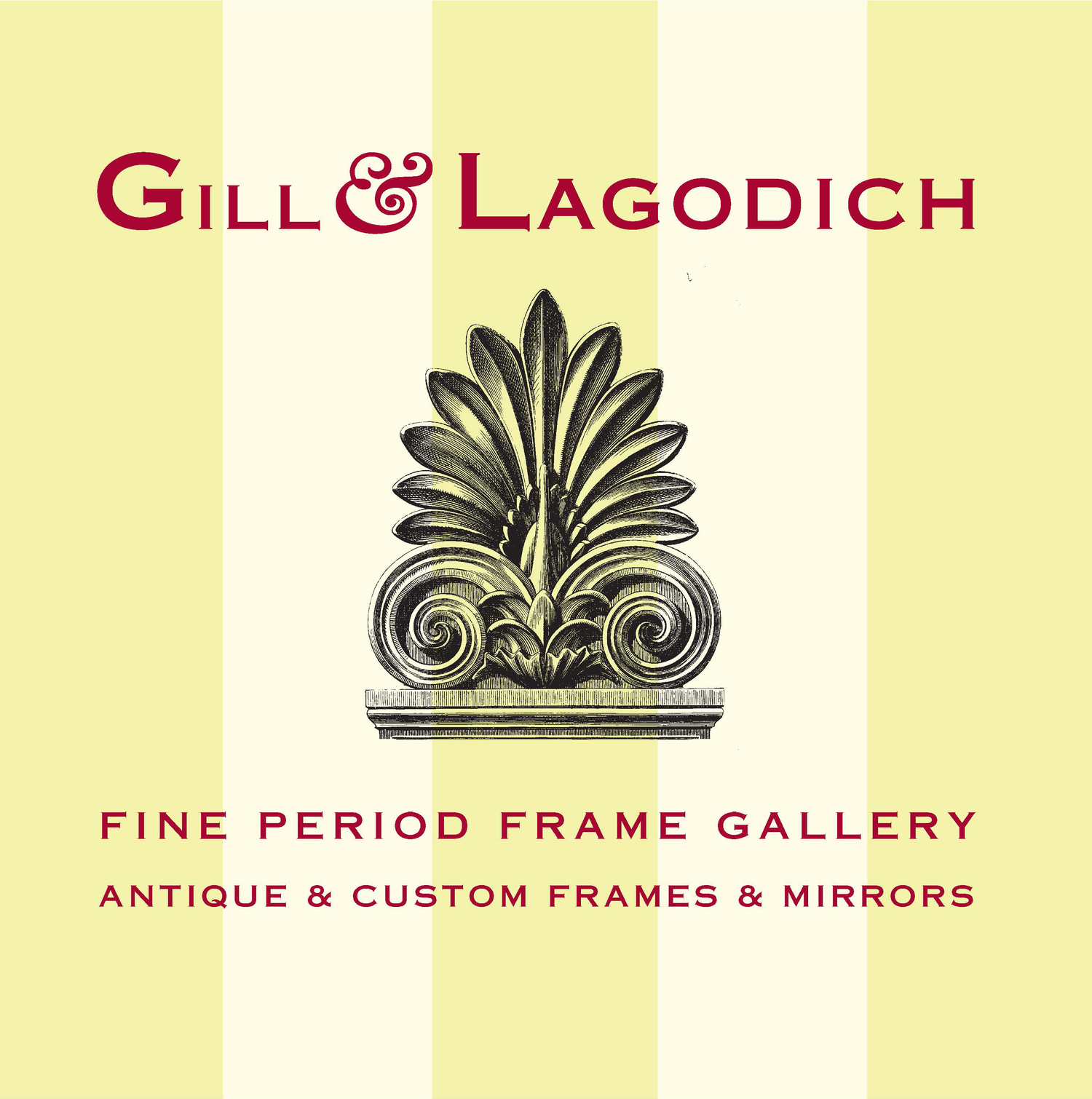THE ART INSTITUTE OF CHICAGO
Gill & Lagodich studios hand-crafted one-hundred-and-fifty-one replica frames, painstakingly made of poplar with inlaid mahogany striping, finished in tinted hand-polished gesso, designed to match original Whistler etching and lithograph frames from the collection of The Hunterian Art Collection, University of Glasgow. WhenSongs on Stone: James McNeill Whistler and the Art of Lithography opened in June 1998 at the Art Institute, our frames were an integral part of the exhibition design, which, with brown paper on the walls and yellow silk draped across the ceiling, recreated the ambience of an original exhibition designed and produced by Whistler during his lifetime.
Since then, Gill & Lagodich has framed a number of Chicago's most beloved paintings, including the iconicNighthawks, by Edward Hopper, Paris Street, Rainy Day, by Gustave Caillebotte, and The Song of The Lark, by Jules Breton.
Other exhibition frames fabricated by Gill & Lagodich include 65 custom-designed, hand-carved and patinated cherry wood frames for photographic portraits in Julia Margaret Cameron's Women, Sept. 1998 – Jan. 1999 (also at MoMA Jan–May, 1999, and SFOMoMA Aug-Nov 30, 1999); twenty custom antiqued gesso and mahogany print frames for Mary Cassatt: Modern Woman; and more.
Over 50 EUROPEAN and AMERICAN paintings framed by Gill & Lagodich include (in alphabetical order): Milton Avery, Conversation in Studio, 1943; Thomas Hart Benton, Cottonpickers, 1945; Teresa F. Bernstein, The Milliners, 1921; Jules Adolphe Breton, The Song of the Lark, 1884; Elbridge Ayer Burbank, six Native American portraits, Kah-Kap-Tee/Moqui, Wick-Ah-Te-Wah/Moqui, Ko-Pe-Ley/Moqui, Pah-Puh/Moqui, Shu-Pe-La/Moqui, Ho-Mo-Vi/Moqui, 1898; Gustave Caillebotte, Paris Street; Rainy Day, 1877; William Merritt Chase, North River Shad, c. 1910; Thomas Cole, New England Scenery, 1839; Jasper Cropsey, Blasted Tree, c. 1850; Gustave Courbet, Reverie (Portrait of Gabrielle Borreau), 1862; Thomas Doughty, Coming Squall (Nahant Beach with a Summer Shower), 1835; Thomas Eakins, Study for "William Rush Carving His Allegorical Statue of the Schuylkill River", c. 1876-77; Thomas Eakins, The Swimming Hole, (photograph), 1884–85; DeScott Evans, The Irish Question, 1880s, Marsden Hartley, The Last of New England—The Beginning of New Mexico, 1918/19; George Hitchcock, Flower Girl in Holland, c. 1887; Winslow Homer, Peach Blossoms, c. 1878; Edward Hopper, Nighthawks, 1942; George Inness, Crossing The Ford, 1848; George Inness, Summer in the Catskills, 1867, George Inness, Catskill Mountains, 1870; George Inness, A Marine, c. 1874-75, George Inness, The Mill Pond, 1889, George Inness, Early Morning, Tarpon Springs, 1892; George Inness, The Home of the Heron, 1893; George Inness, After A Summer Shower, 1894, Joshua Johnson, Mrs. Andrew Bedford Bankson and Son, Gunning Bedford Bankson, 1803/05; Otis Kaye, Heart of the Matter, 1963; Kandinsky watercolor; Fernand Leger, Reclining Woman, 1922; Fernand Leger, Still Life, 1926; Edouard Manet, Still-Life with Carp, 1864; Edouard Manet, Bullfight, 1865/66; Julius Gari Melchers, Mother and Child, c. 1906; Jean-Francois Millet, In the Auvergne, 1866/69; Jean-Francois Millet, Peasants Bringing Home a Calf Born in the Fields; Jean-Francois Millet, The Little Shepherdess; William Sidney Mount, Bar-Room Scene, 1835; Horace Pippin, Cabin in the Cotton, c. 1931–37; Camille Pissarro, The Place du Havre, Paris, 1893; Ellen Emmet Rand, Woman Before the Mirror, 1925: Frederic Remington, The Advance-Guard, 1890; Severin Roesen, An Abundance of Fruit, 1860; Albert Pinkham Ryder, The Essex Canal, 1896; John Singer Sargent,Venetian Glass Workers, 1880/82; John Singer Sargent, Thistles, 1883/89; John Singer Sargent, The Fountain, Villa Torlonia, Frascati, Italy, 1907; Helen Torr, Extemporaneous, 1927; Elihu Vedder, The Fates Gathering in the Stars, 1887; Charles Wilbert White, This, My Brother, 1942; Hale Woodruff, Twilight,1926; Marguerite Thompson Zorach, Landscape (recto), 1911-12; and more...
Please check back soon for additional paintings listed along with images.
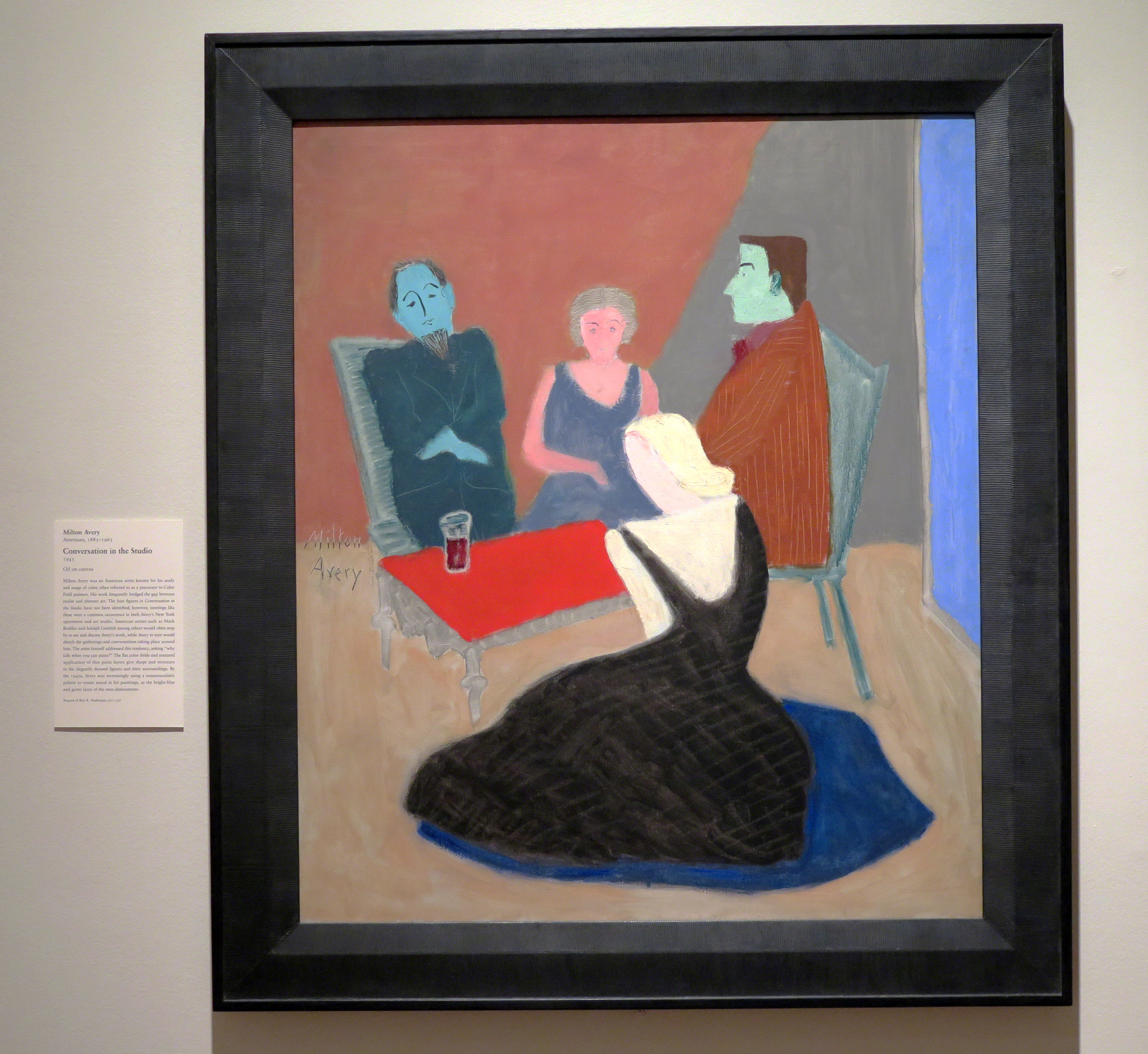
MILTON AVERY (1885–1965)
Conservation in Studio, 1943, oil on canvas, 42 x 36 inches. Custom-made replica of mid-20th century American Modernist painting frame; ebonized combed gesso on carved wood, molding width: 4-1/2” Painting bequest of Roy R. Neuberger, 2011.07 © 2018 Milton Avery Trust / Artists Rights Society (ARS), New York “Milton Avery was an American artist known for his study and usage of color, often referred to as a precursor to Color Field painters. His work frequently bridged the gap between realist and abstract art. The four figures in Conversation in the Studio have not been identified; however, meetings like these were a common occurrence in both Avery’s New York apartment and art studio. American artists such as Mark Rothko and Adolph Gottlieb among others would often stop by to see and discuss Avery’s work, while Avery in turn would sketch the gatherings and conversations taking place around him. The artist himself addressed this tendency, asking “why talk when you can paint?” The flat color fields and textured application of thin paint layers give shape and structure to the elegantly dressed figures and their surroundings. By the 1940s, Avery was increasingly using a nonnaturalistic palette to create mood in his paintings, as the bright-blue and green faces of the men demonstrate.” — AIC, permanent collection label.

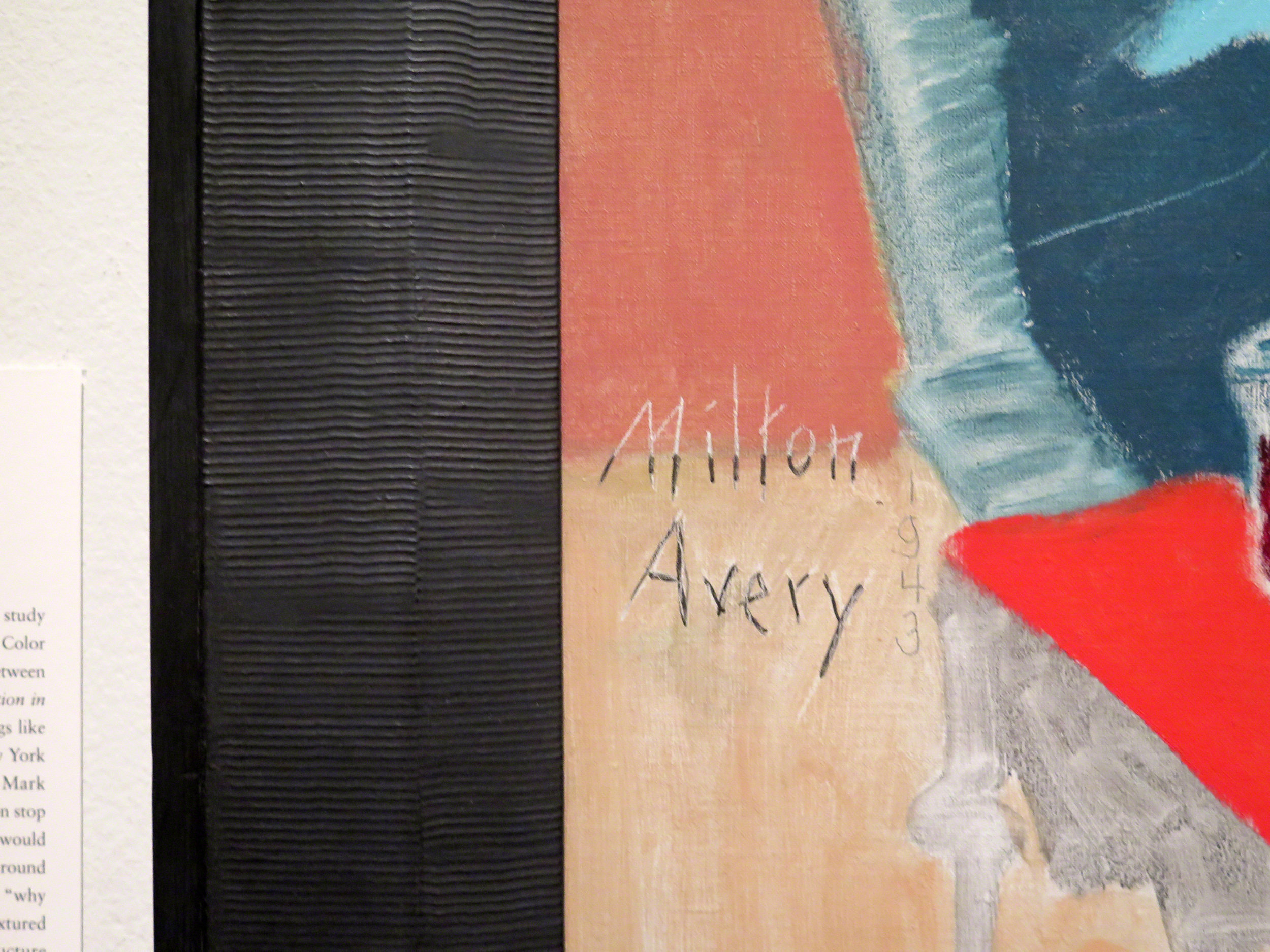

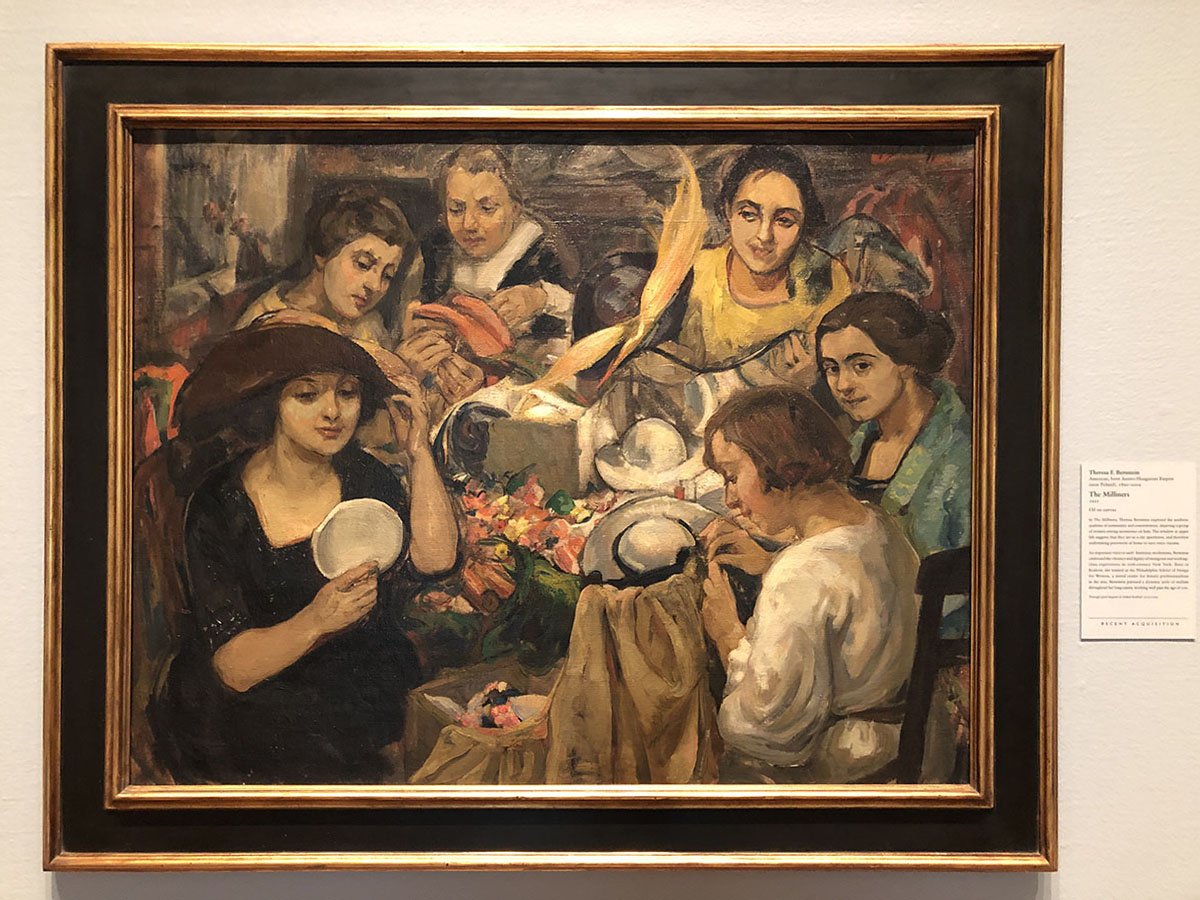
THERESA F. BERNSTEIN (1890–2002)
The Milliners, 1921, oil on canvas, 40- 1/4 × 50-1/4 in. Framed by Gill & Lagodich for the Art Institute of Chicago. Custom-made replica c. 1920s American Arts and Crafts frame, Newcomb-Macklin New York/ Chicago makers, metal-gilded hand-carved wood with ebonized frieze, molding width: 5-3/8 in. “In The Milliners, Theresa Bernstein explored the aesthetic qualities of community and concentration, depicting a group of women sewing accessories on hats. The window at upper left suggests that they are in a city apartment, and therefore undertaking piecework at home to earn extra income. An important voice in early American modernism, Bernstein celebrated the vibrancy and dignity of immigrant and working-class experiences in 20th-century New York. Born in Krakow, she trained at the Philadelphia School of Design for Women, a noted center for female professionalism in the arts. Bernstein pursued a dynamic style of realism throughout her long career, working well past the age of 100.”—Art Institute label. Painting through prior bequest of Arthur Rubloff.
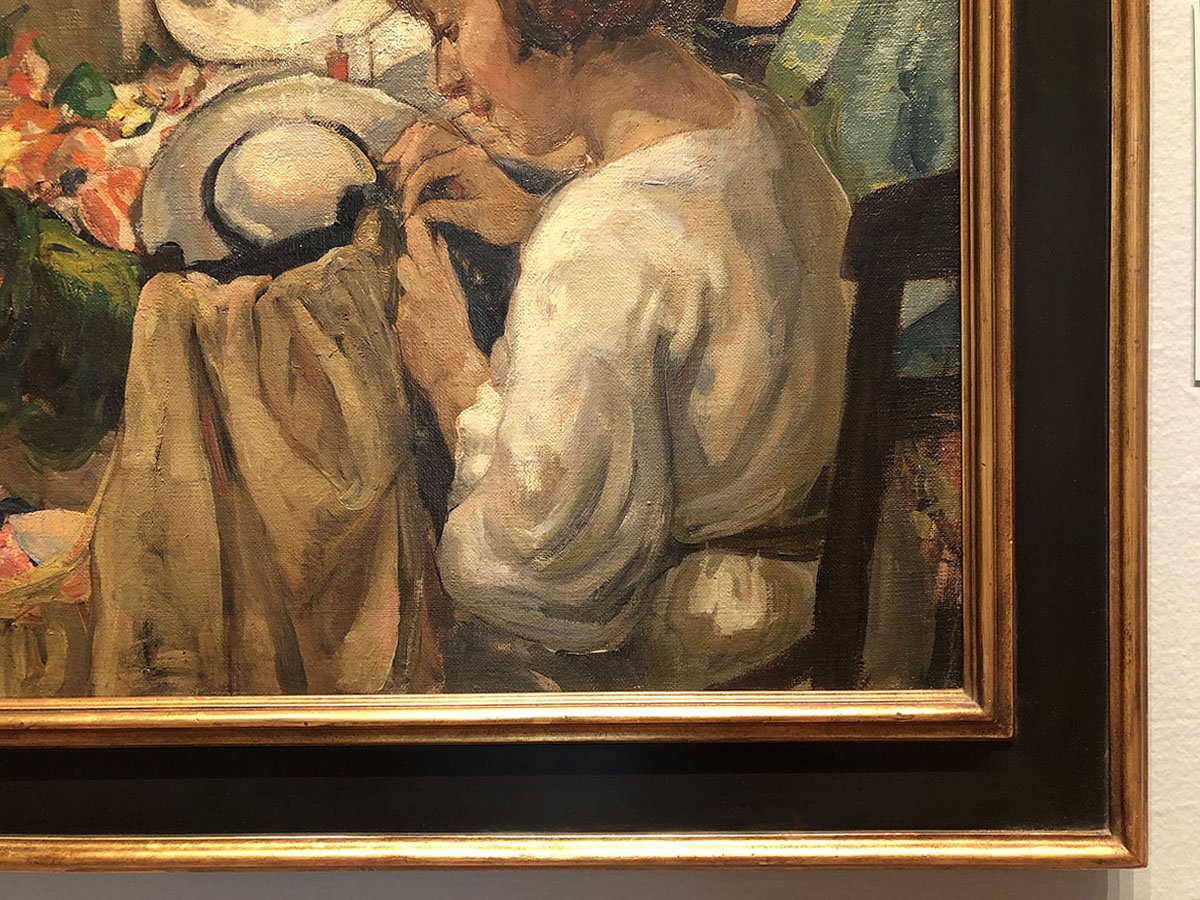

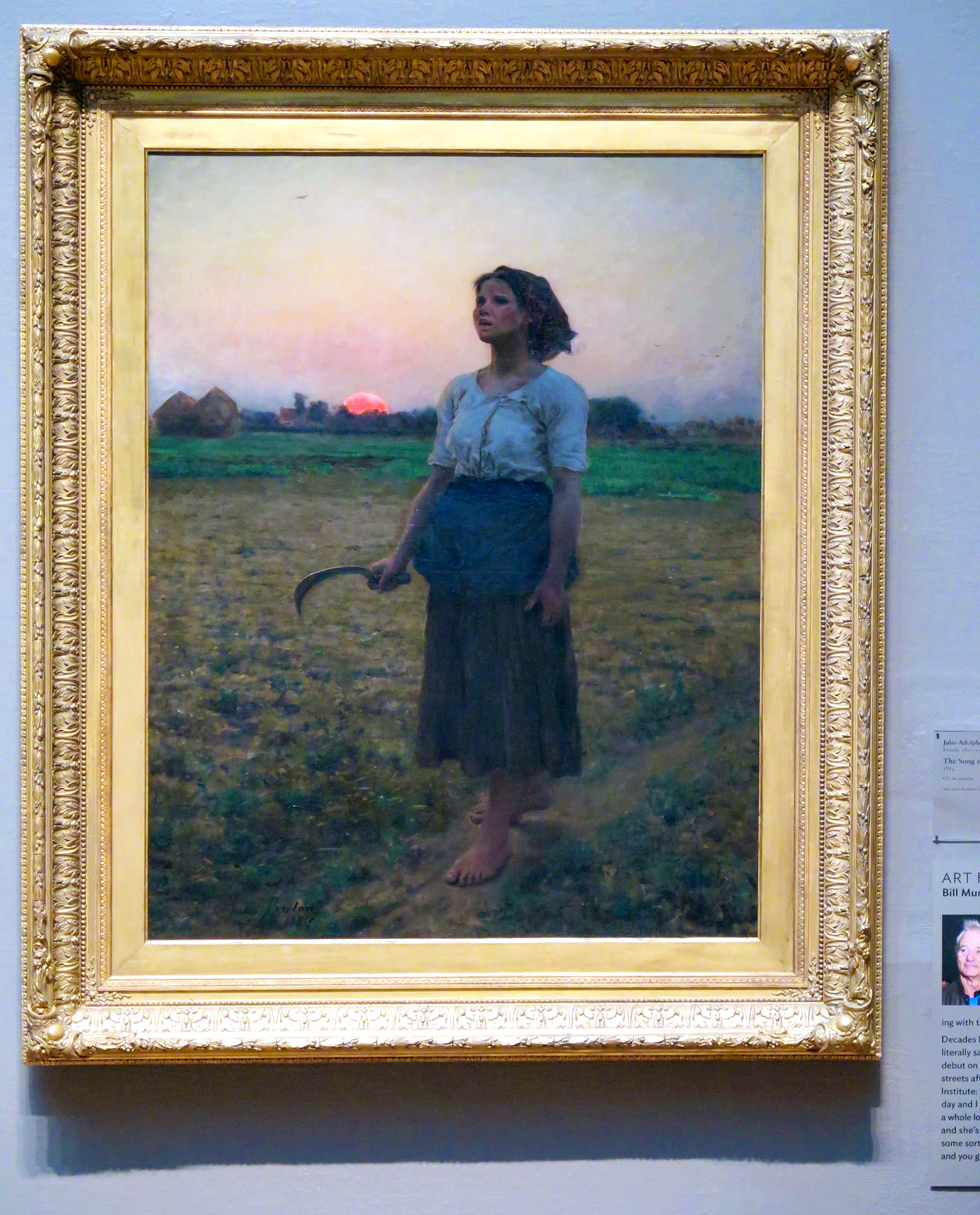
JULES ADOLPHE BRETON (1827–1906)
The Song of the Lark, 1884, oil on canvas, 43-1/2” x 33-3/4”, period 19th-century Barbizon-style frame; molding width 6-7/8".

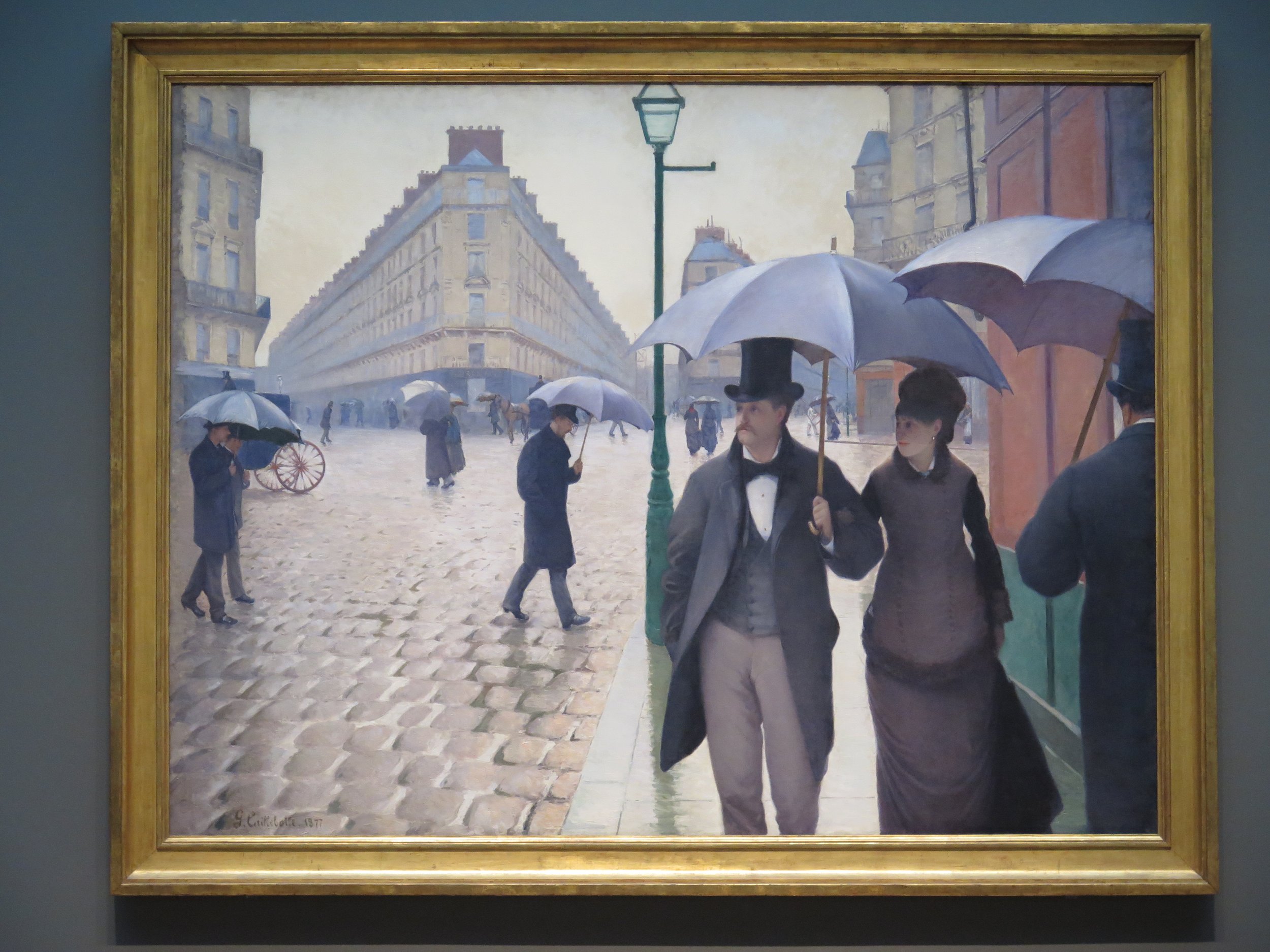
GUSTAVE CAILLEBOTTE (1848 – 1894)
Paris Street; Rainy Day, 1877, oil on canvas, 83-1/2 x 108-3/4 in. Framed by Gill & Lagodich for the Art Institute of Chicago, May 2000, in period 19th-century French gilded wood molding frame, molding width 6.5 in. . This iconic Impressionist painting was recently cleaned and restored to its original appearance. Commentary and interactive images of the recent dramatic restoration are documented here in the Wall Street Journal . "In his masterpiece, "Paris Street; Rainy Day", Gustave Caillebotte brought an unusual monumentality and compositional control to a typical Impressionist subject, the new boulevards that were changing the Paris cityscape. The result is at once real and contrived, casual and choreographed. With its curiously detached figures, the canvas depicts the anonymity that the boulevards seemed to create. By the time it appeared in the third Impressionist exhibition, held in April 1877, the artist was 29 years old, a man of considerable wealth, and not only the youngest but also the most active member of the Impressionist group. He contributed six of his own canvasses to the exhibition; played a leading part in its funding, organization, promotion, and installation; and lent a number of paintings by his colleagues that he owned." —AIC wall label. “This complex intersection, just minutes away from the Saint-Lazare train station, represents in microcosm the changing urban milieu of late nineteenth-century Paris. Gustave Caillebotte grew up near this district when it was a relatively unsettled hill with narrow, crooked streets. As part of a new city plan designed by Baron Georges-Eugène Haussmann, these streets were relaid and their buildings razed during the artist’s lifetime. In this monumental urban view, which measures almost seven by ten feet and is considered the artist’s masterpiece, Caillebotte strikingly captured a vast, stark modernity, complete with life-size figures strolling in the foreground and wearing the latest fashions. The painting’s highly crafted surface, rigorous perspective, and grand scale pleased Parisian audiences accustomed to the academic aesthetic of the official Salon. On the other hand, its asymmetrical composition, unusually cropped forms, rain-washed mood, and candidly contemporary subject stimulated a more radical sensibility. For these reasons, the painting dominated the celebrated Impressionist exhibition of 1877, largely organized by the artist himself. In many ways, Caillebotte’s frozen poetry of the Parisian bourgeoisie prefigures Georges Seurat’s luminous Sunday on La Grande Jatte—1884, painted less than a decade later.” —AIC permanent collection label. Painting: Charles H. and Mary F. S. Worcester Collection
In 2011, the painting was taken off view for conservation, and the empty frame was left as a placeholder in the gallery — an invitation to visitors to pose for their own masterpieces.
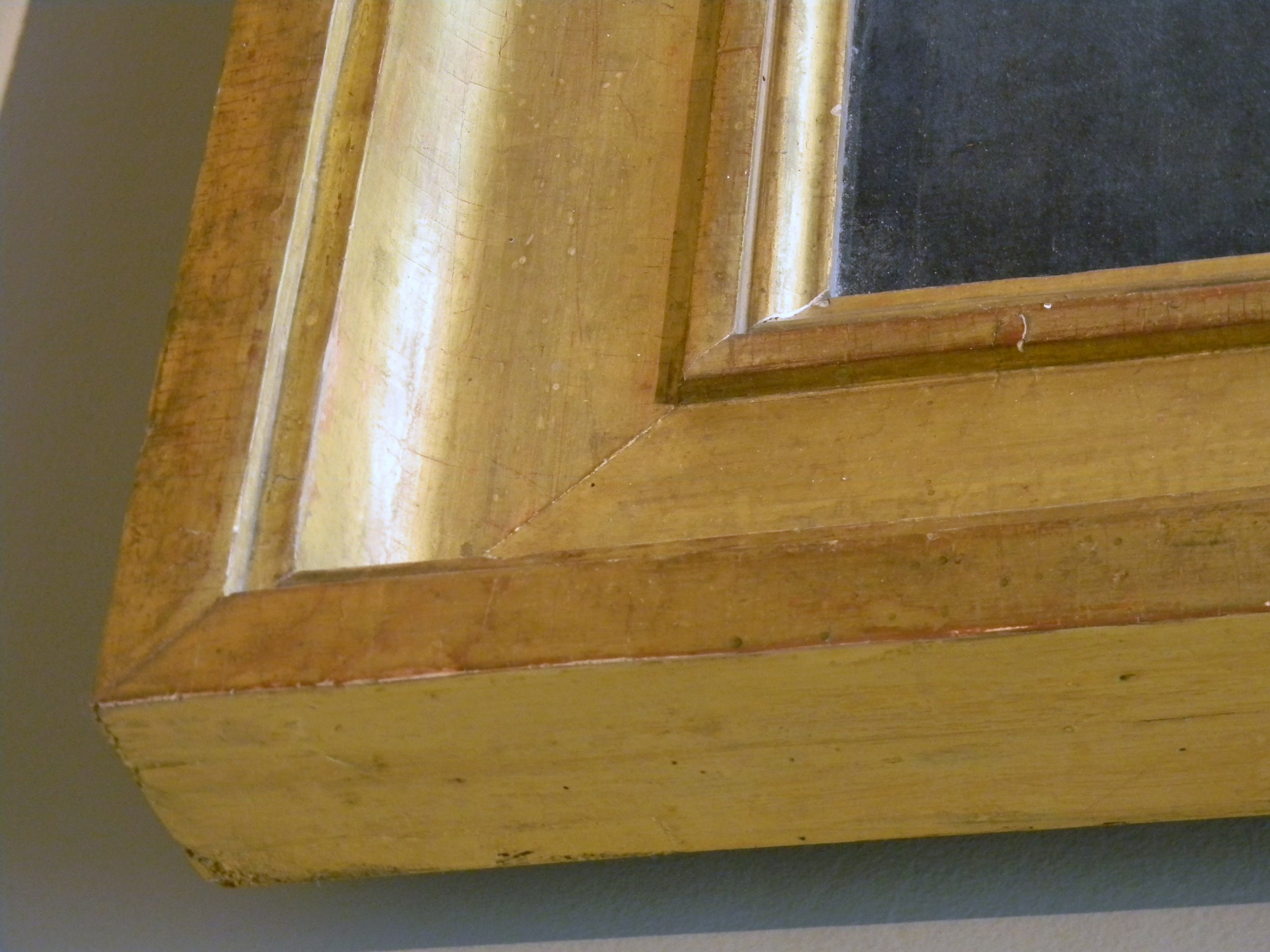
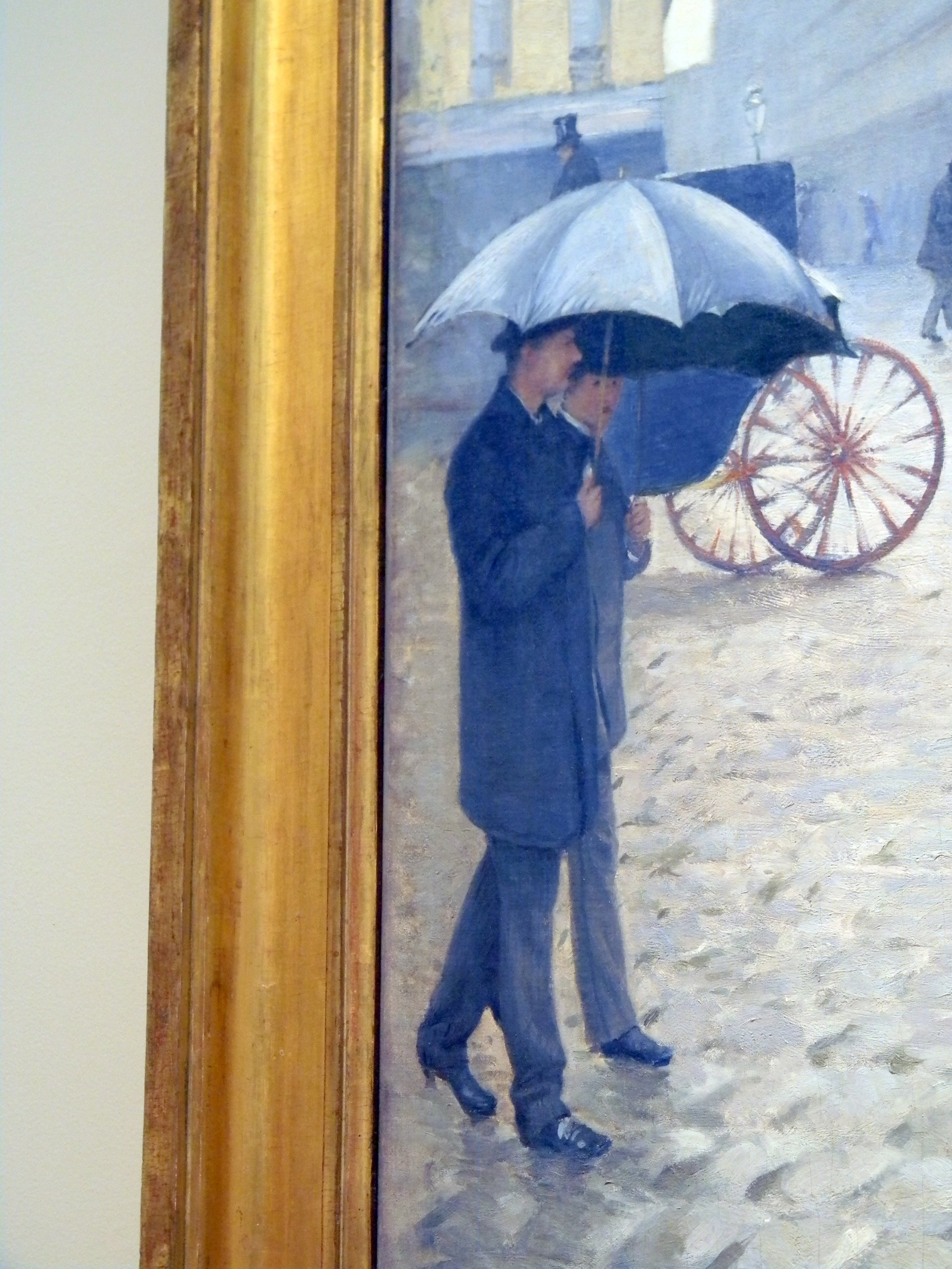

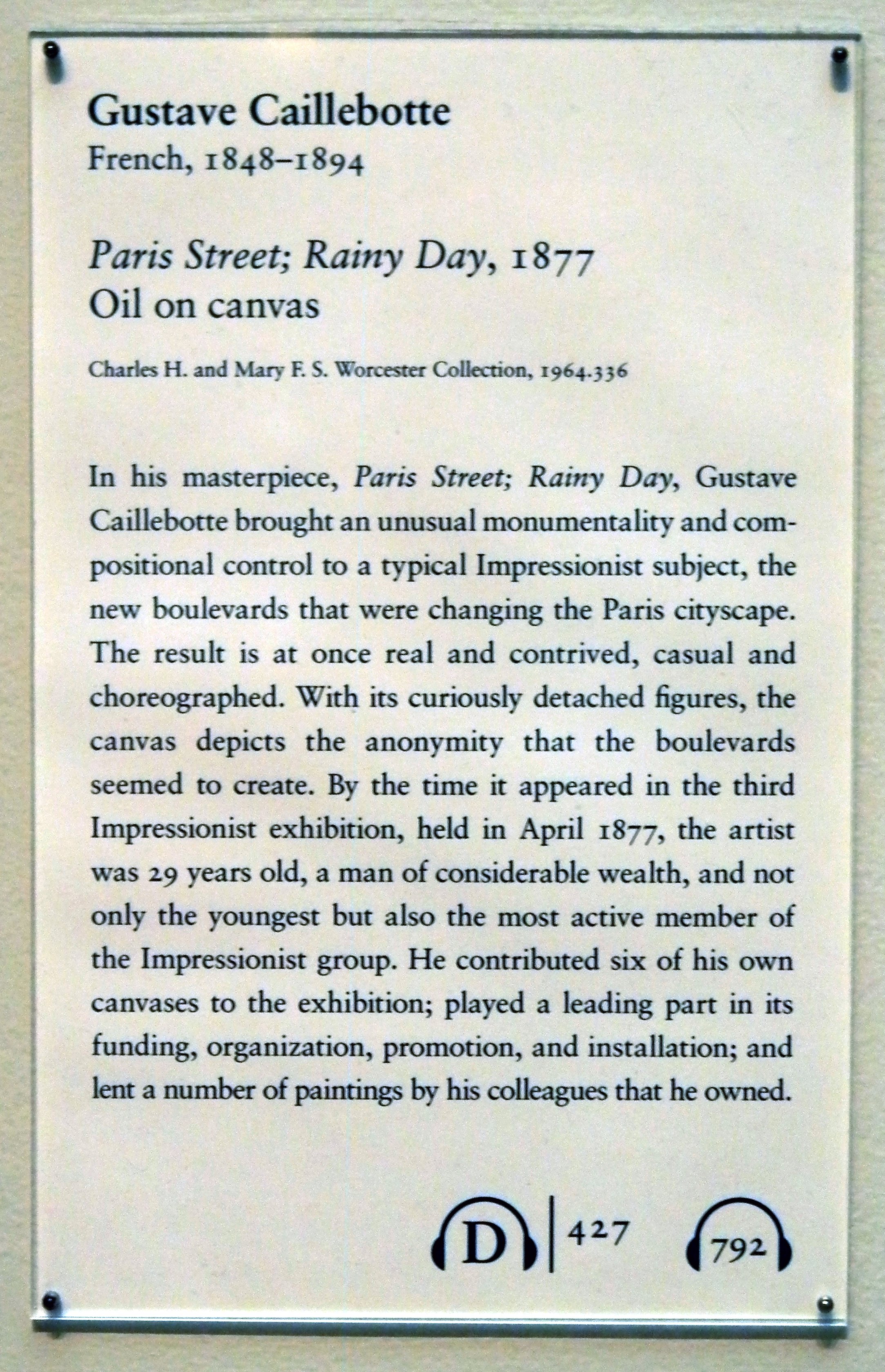
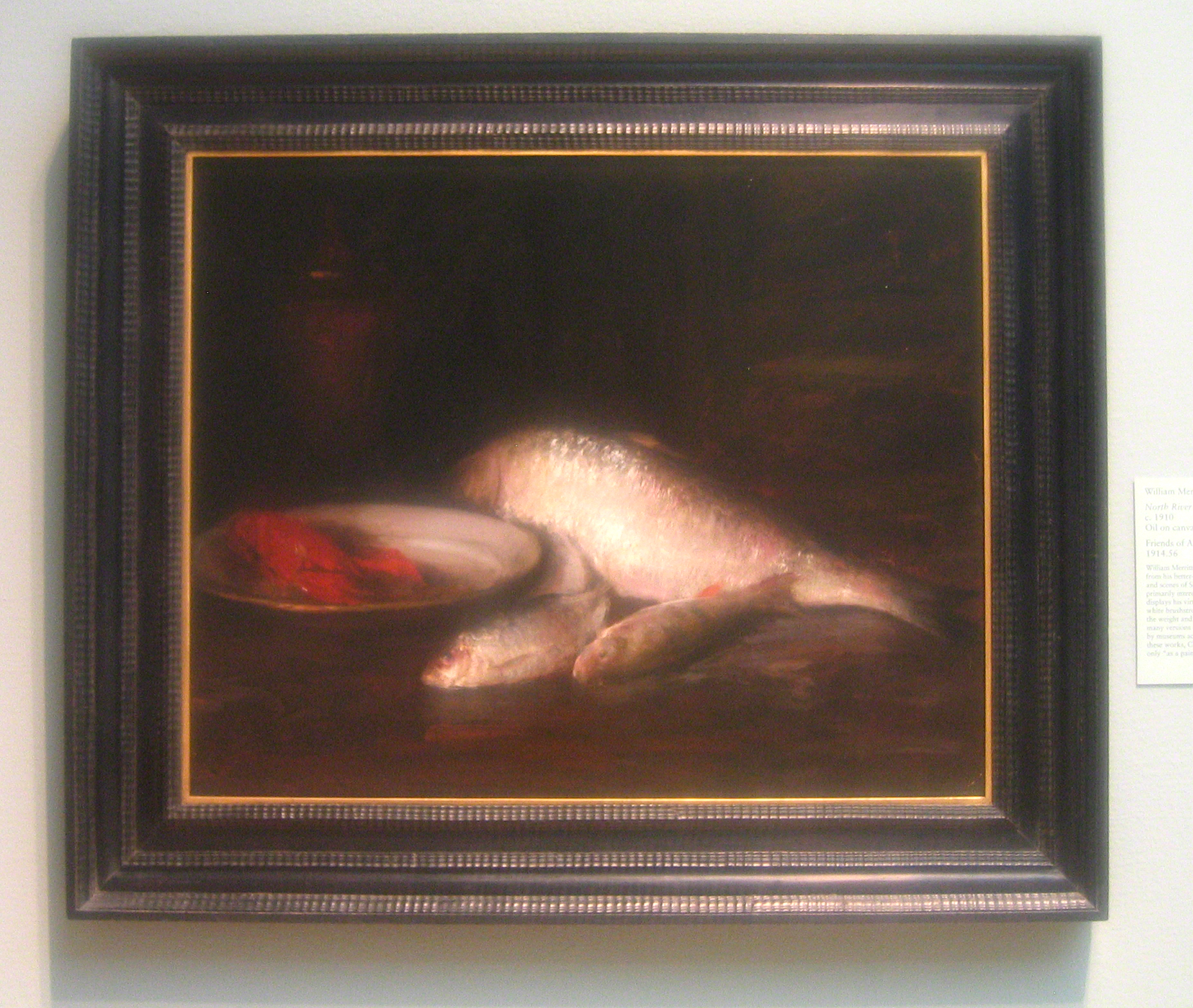
WILLIAM MERRITT CHASE (1849 – 1916)
North River Shad, c. 1910, oil on canvas, 29" x 37", custom-made replica frame, late 18th-century European, Dutch-style, ebonized carved wood with applied ornament, molding width 5-1/2" "William Merritt Chase's "North River Shad" is a striking departure from his better-known Impressionist renderings of city parks and scenes in Shinnecock, New York. Here he was primarily interested in depicting surface texture; the fish displays the artist's virtuosity with pigment and brushwork. Brilliant white brushstrokes form its iridescent scales, accentuating the weight and density of the voluminous creature. Chase painted numerous versions of fish still lifes, many of which were quickly purchased by museums across the country. Because of the popularity of these works, Chase worried that he would be remembered only "as a painter of fish." — Art Institute of Chicago, permanent collection label, Friends of American Art Collection, 1914.56
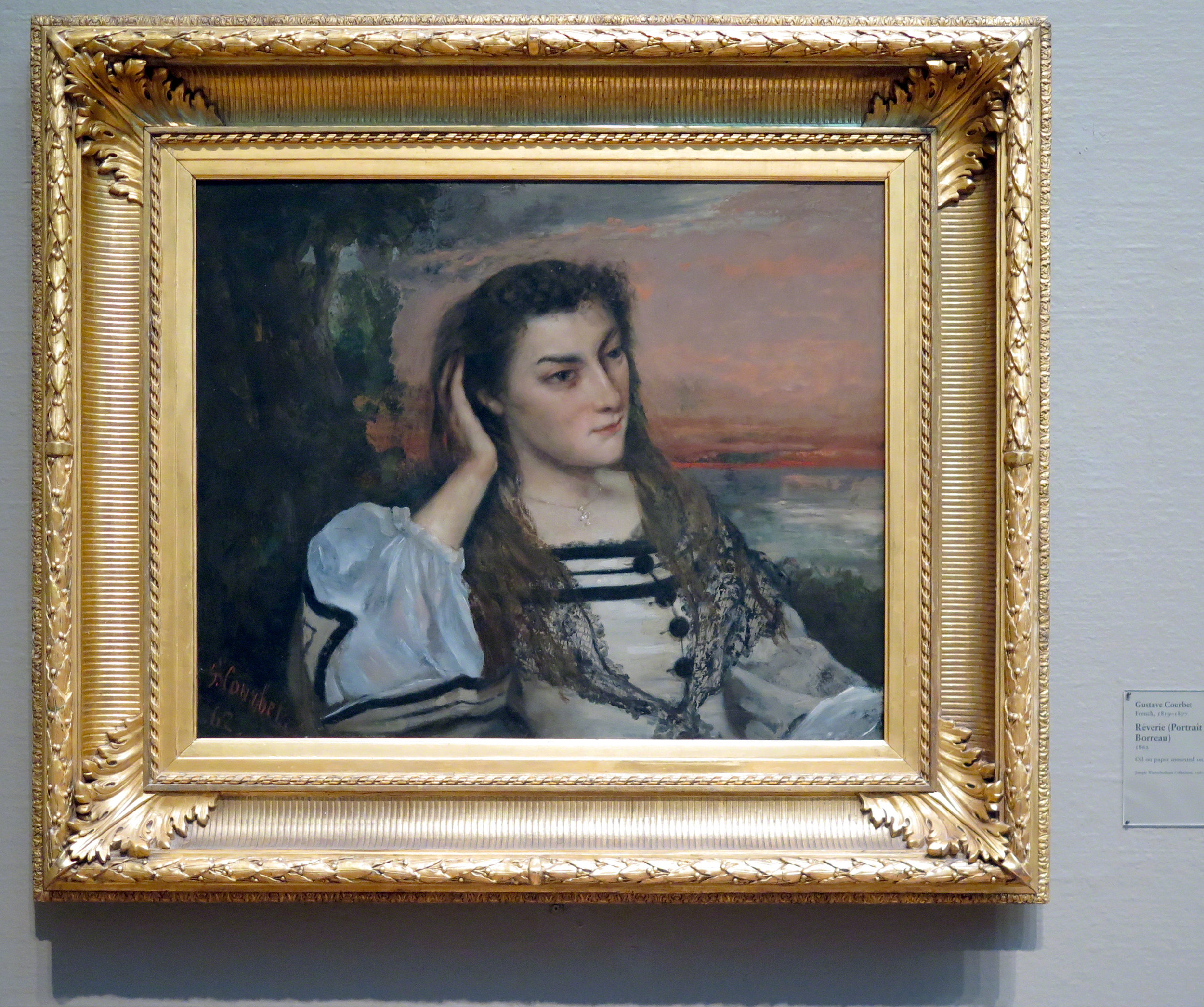
GUSTAVE COURBET (1819 – 1877)
Rêverie (Portrait of Gabrielle Borreau), 1862, oil on paper mounted on canvas, 25" x 30-5/16", period European Neo-classical frame, gilded applied composition ornament on wood, molding width 7-1/2"
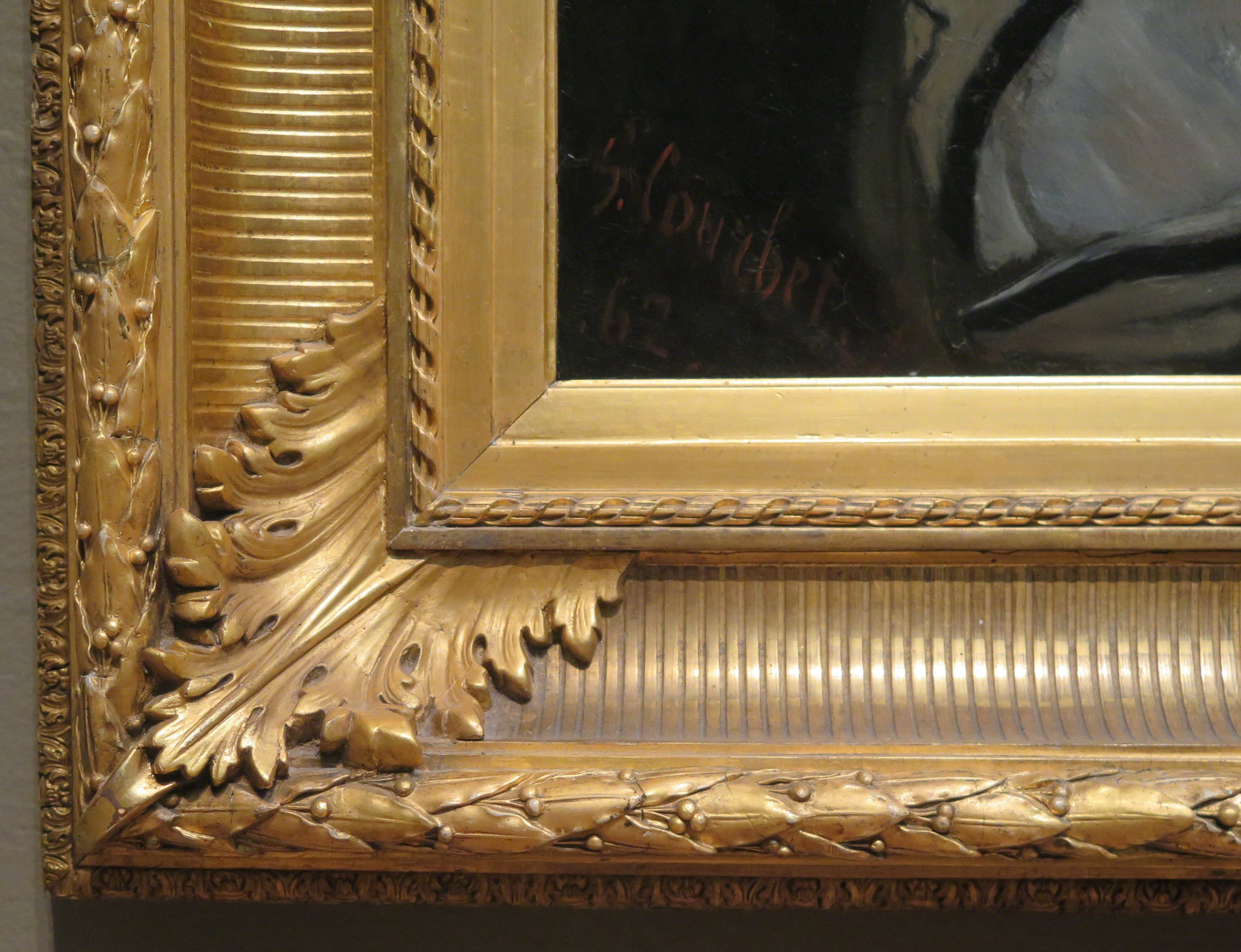
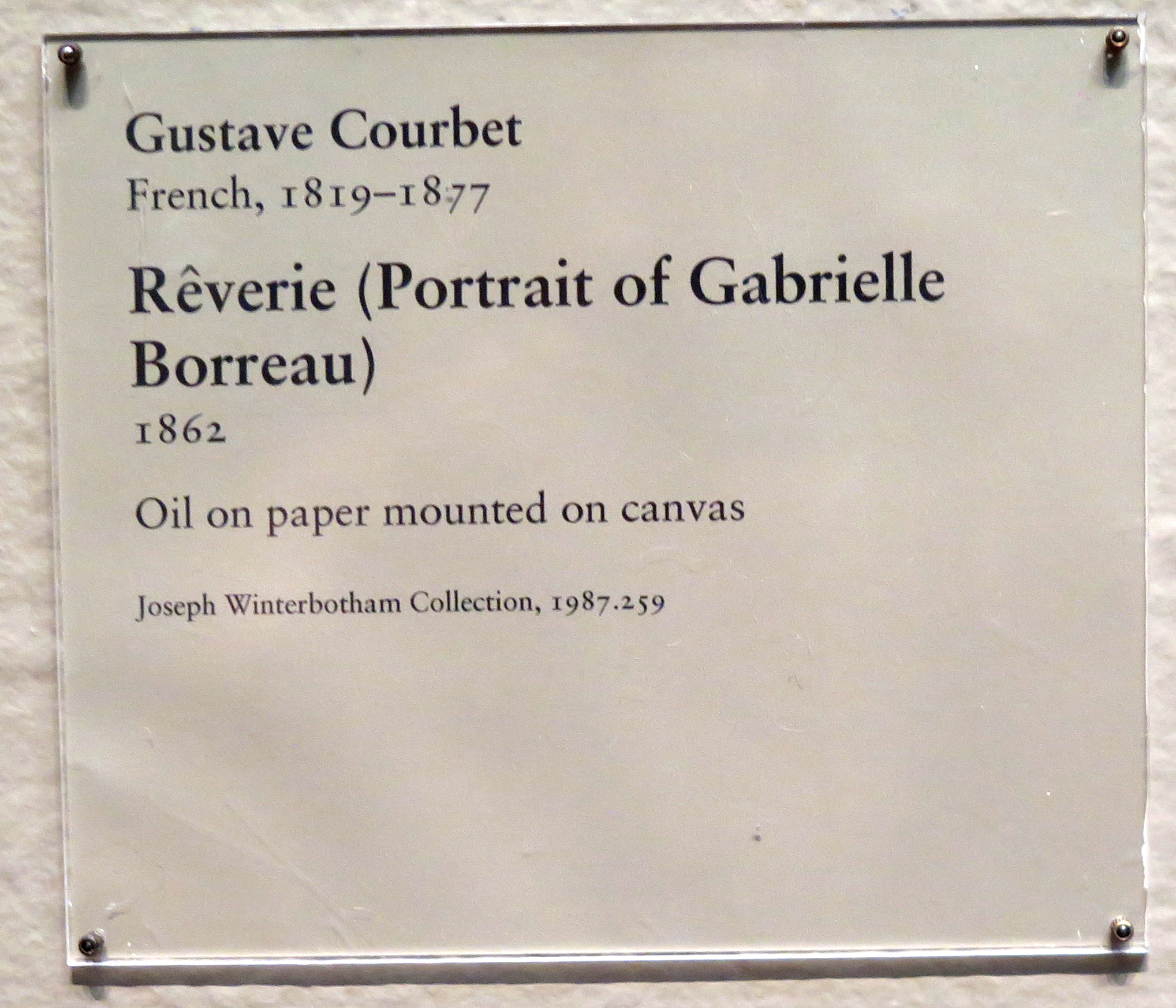

THOMAS COPPERTHWAITE EAKINS (1844 – 1916)
Study For William Rush Carving His Allegorical Statue Of The Schuylkill, c. 1875-76, oil on canvas, 14-1/8" x 11-1/4", period American 1870s frame, gilded applied composition ornament on wood, molding width: 4-3/8" "Best known for his realist portraits and scenes of contemporary life, Thomas Eakins also spent considerable energy on history paintings. Here, he executed a study for a painting that celebrates an early American sculptor, William Rush. In the finished painting, Rush is depicted carving his Water Nymph and Bittern (1809), for which the model poses; the statue adorned a public square in Philadelphia, the hometown of both artists. Eakins, an ardent advocate of studying from life, highlights this artistic working method in his rendering of the female form. In 1870s America, artistic studies from the nude figure remained a rarity, a condition that Eakins worked hard to overturn in the following years as an instructor at the Pennsylvania Academy of the Fine Arts". — Art Insititute of Chicago, permanent collection label

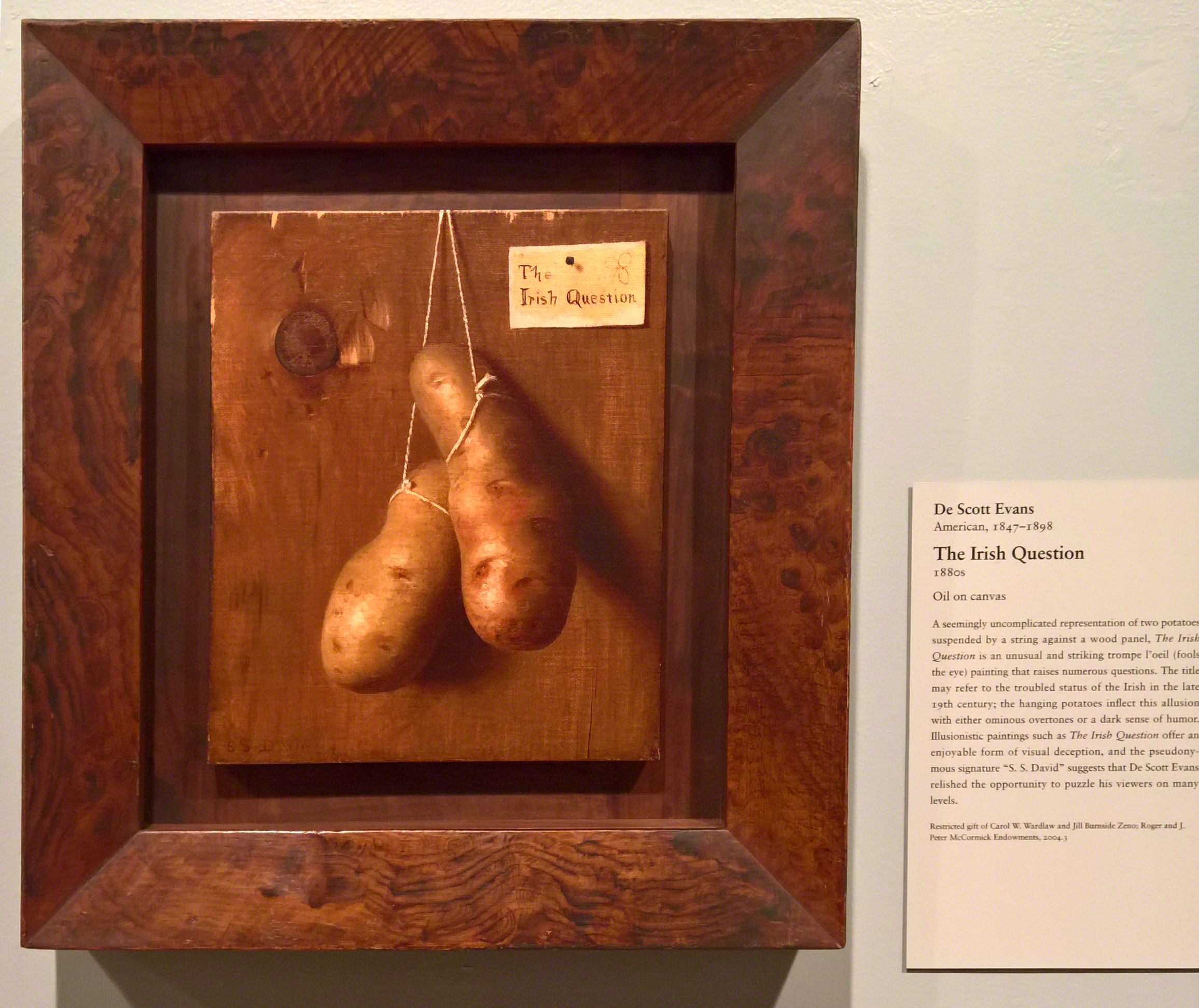
DE SCOTT EVANS (1847–1898)
The Irish Question, 1880s, oil on canvas, 12 x 10 inches. Period 19th-century American Folk Art frame, beautiful hand-painted faux bois burl pattern, beveled profile, original condition; molding width 2-1/2” Painting Restricted gift of Carol W. Wardlaw and Jill Burnside Zeno; Roger and J. Peter McCormick Endowments, 2004.3
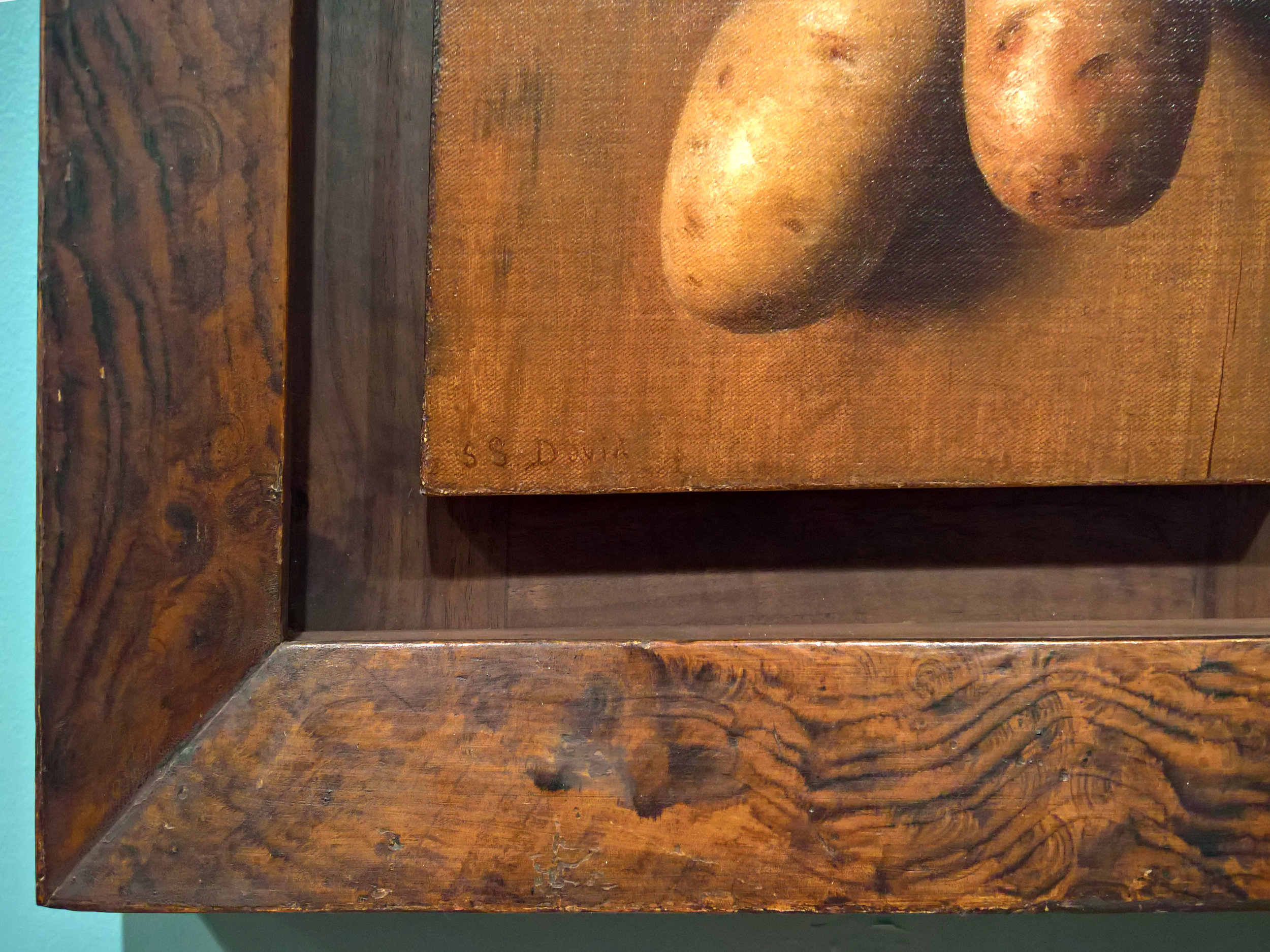
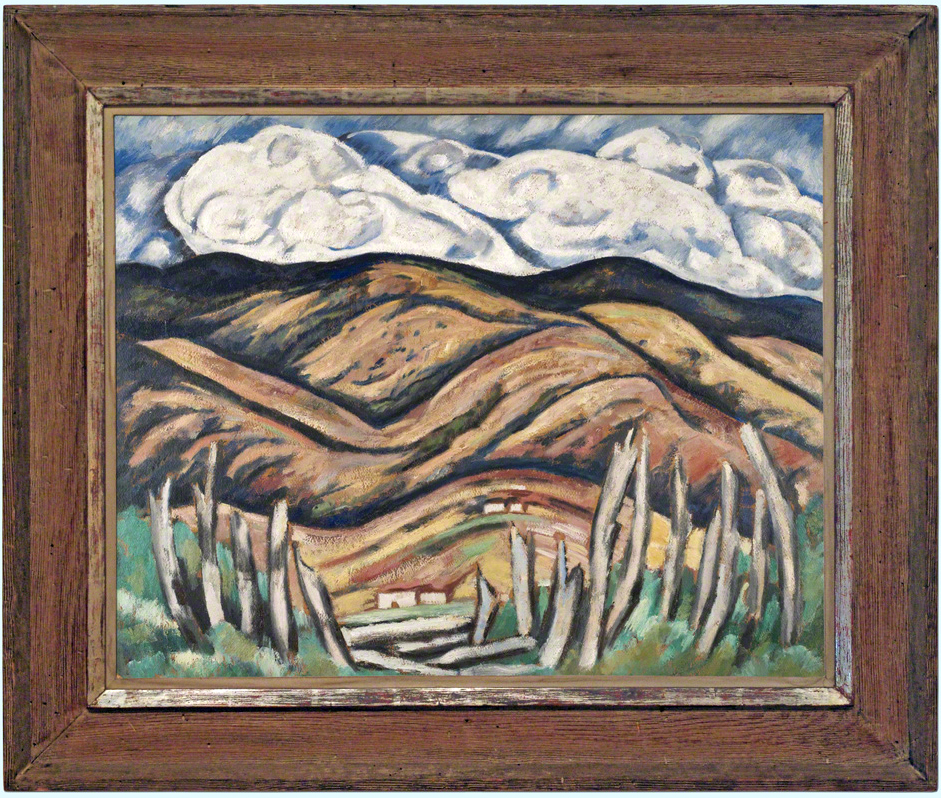
MARSDEN HARTLEY (1877 – 1943)
The Last of New England—The Beginning of New Mexico, 1918/19, oil on cardboard, 24 x 30 inches. Framed by Gill & Lagodich, period c. 1930s-40s American Modernist frame, House of Heydenryk, New York maker, wormy chestnut wood with polychrome patina; silver leaf with painted gesso flat liner. Label on Verso: a HEYDENRYK frame / HHJR / THE HOUSE OF HEYDENRYK / 141 WEST 54TH STREET / NEW YORK 19, N.Y. "In 1918 Marsden Hartley went to New Mexico in search of an appropriate subject for an authentic American modern art. In the artist’s 18 months there, the Southwest inspired him to reengage with nature and more realistic representational modes. Hartley described the scenery to his dealer, Alfred Stieglitz: “I like the country very well for it is big and clean and true, and there is nothing dirty standing between one and the sunlight, as there is in the east.” In The Last of New England—The Beginning of New Mexico, Hartley celebrated leaving the exhausted East for the unspoiled landscape of the Southwest, which he felt offered weary Americans an opportunity for rejuvenation in nature." — Art Institute of Chicago, Permanent collection label. Alfred Stieglitz Collection, 1949.546
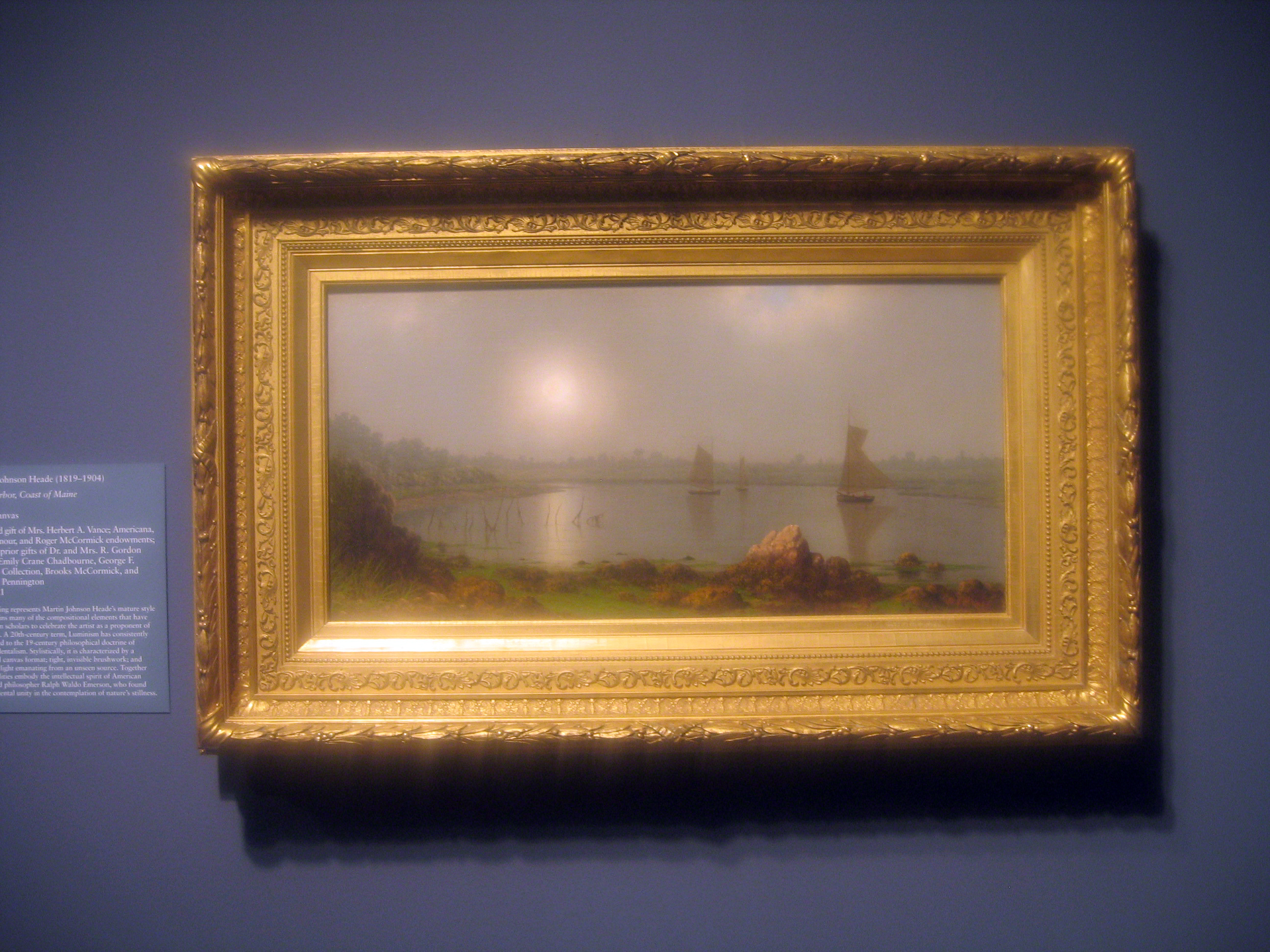
MARTIN JOHNSON HEADE (1819 – 1904)
York Harbor, Coast of Maine, 1877, oil on canvas, 15-1/4" x 30-1/4", period 1870s frame. "This painting represents Martin Johnson Heade’s mature style from the 1870s and contains many of the compositional elements that have led modern scholars to celebrate the artist as a proponent of Luminism. A 20th-century term, Luminism has consistently been linked to the 19th-century philosophical doctrine of transcendentalism. Stylistically, it is characterized by a horizontal format; tight, invisible brushwork; and pervasive light emanating from an unseen source. Together these qualities embody the intellectual spirit of the American writer and philosopher Ralph Waldo Emerson (1803–1882), who found transcendental unity in the contemplation of nature’s stillness." — Art Institute of Chicago, permanent collection label
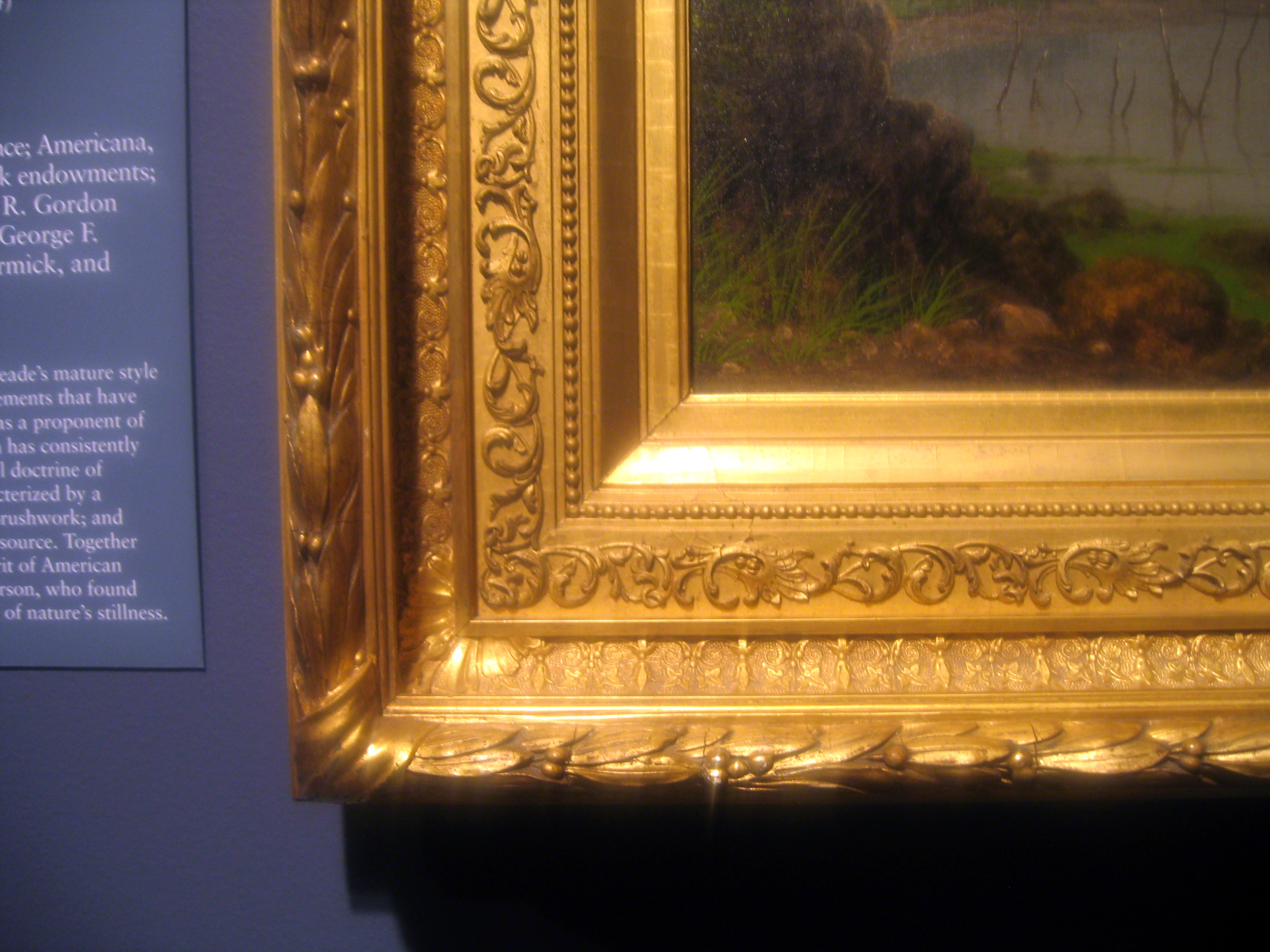
detail, above 1870s American frame
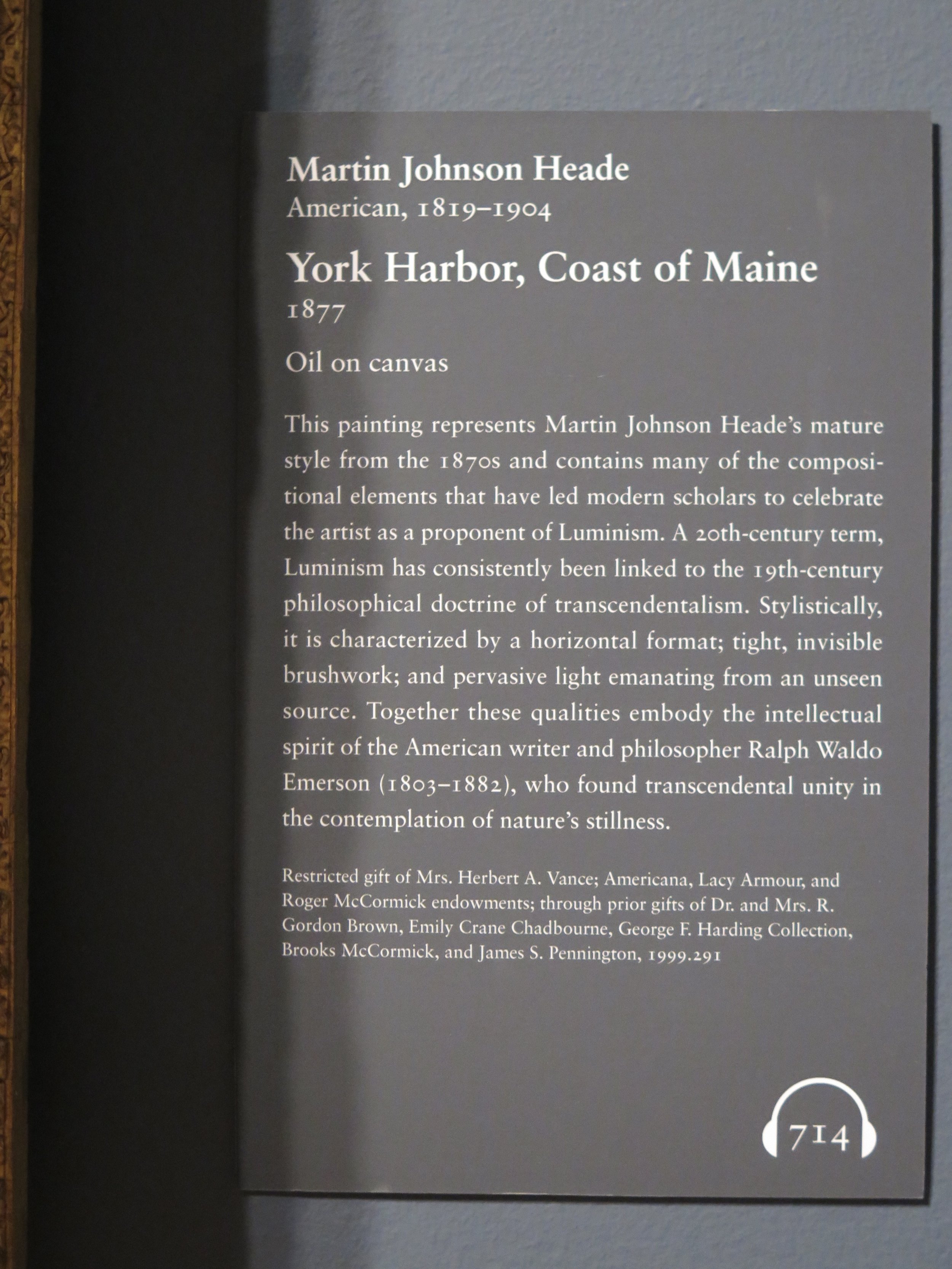
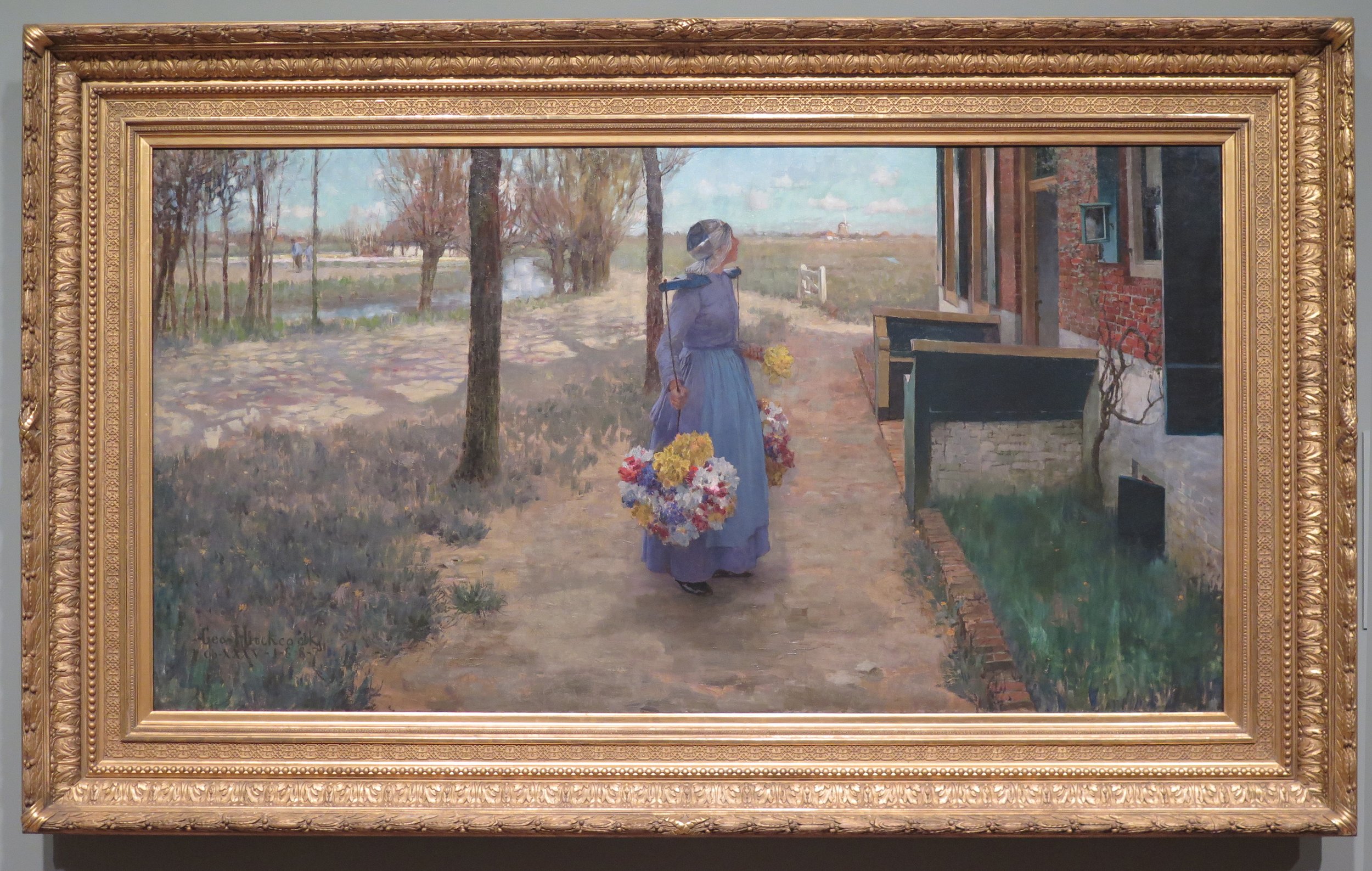
GEORGE HITCHCOCK (1850–1913)
Flower Girl in Holland, 1887, oil on canvas, 31-1/8 x 58 in. Period c. 1880s American Barbizon painting frame; gilded applied composition ornament on wood, molding width 6-1/2 inches. "An expatriate American who settled in Egmond, Holland around 1883, George Hitchcock was influenced by his Dutch surroundings as well as strains of late-nineteenth-century Continental painting. In this work, he combined an Impressionist palette with the pronounced perspective, hard-edged details, and rural subject matter that characterized academic Realist painting of the period, demonstrating his debt to both styles. Hitchcock painted many scenes of peasant women in tulip fields, often imbuing them with ethereal, Madonna-like qualities." “After studying in London, Paris, and at the Hague, George Hitchcock settled in 1884 in the Netherlands, living and working for twenty years in Egmond. Attracted to the region’s landscape and peasant communities, the artist specialized in scenes featuring women in traditional dress set among voluptuous, blooming flowers. Here, Hitchcock revised the environment behind the Dutch flower seller, editing out other houses nearby in favor of a bucolic vista. Although he employed academic techniques such as fine modeling of his figures, Hitchcock nevertheless earned a reputation as a daring colorist for the brilliant hues and open brushwork that likewise characterize his compositions. —AIC didactic texts. Potter Palmer Collection.
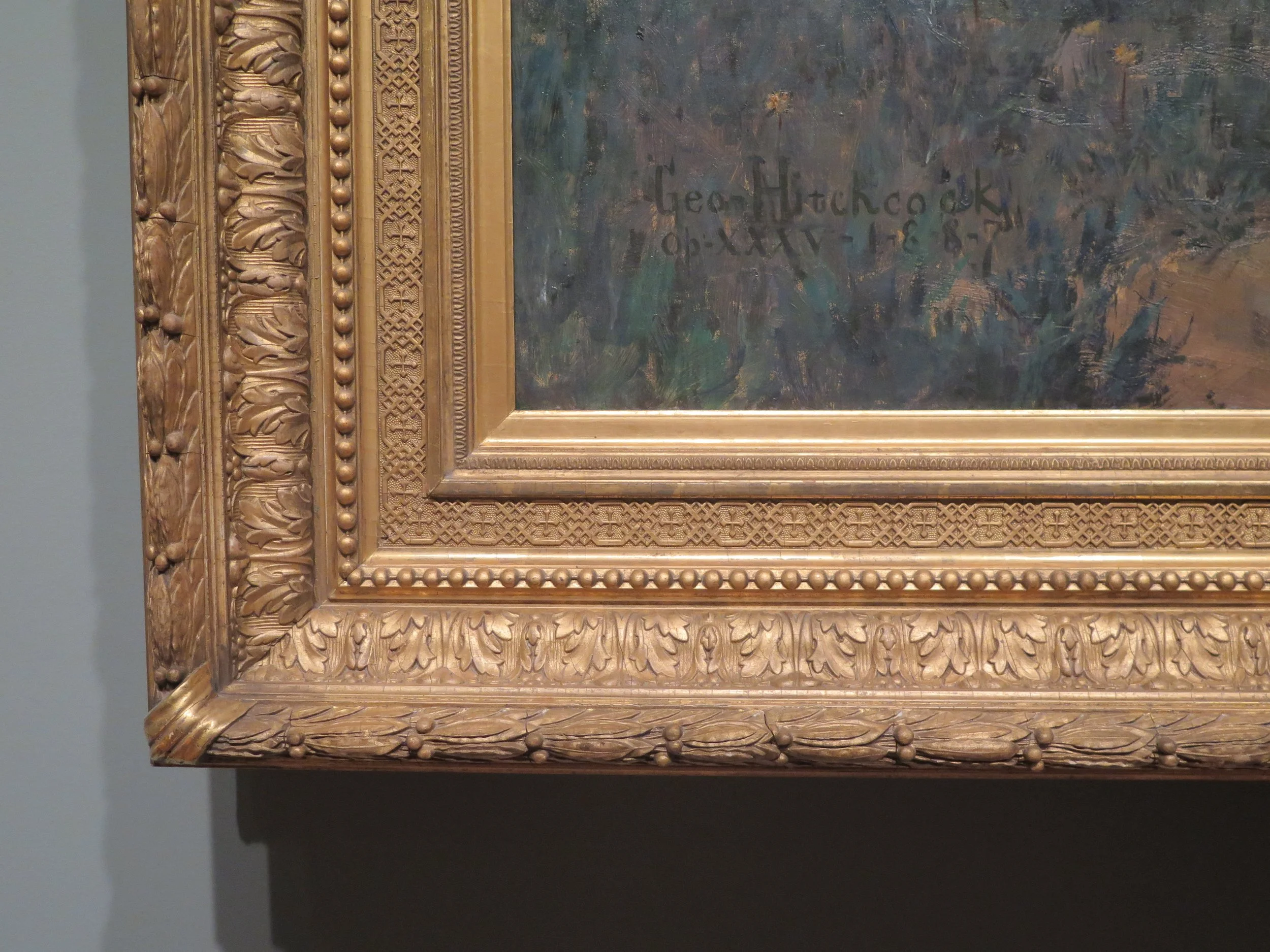
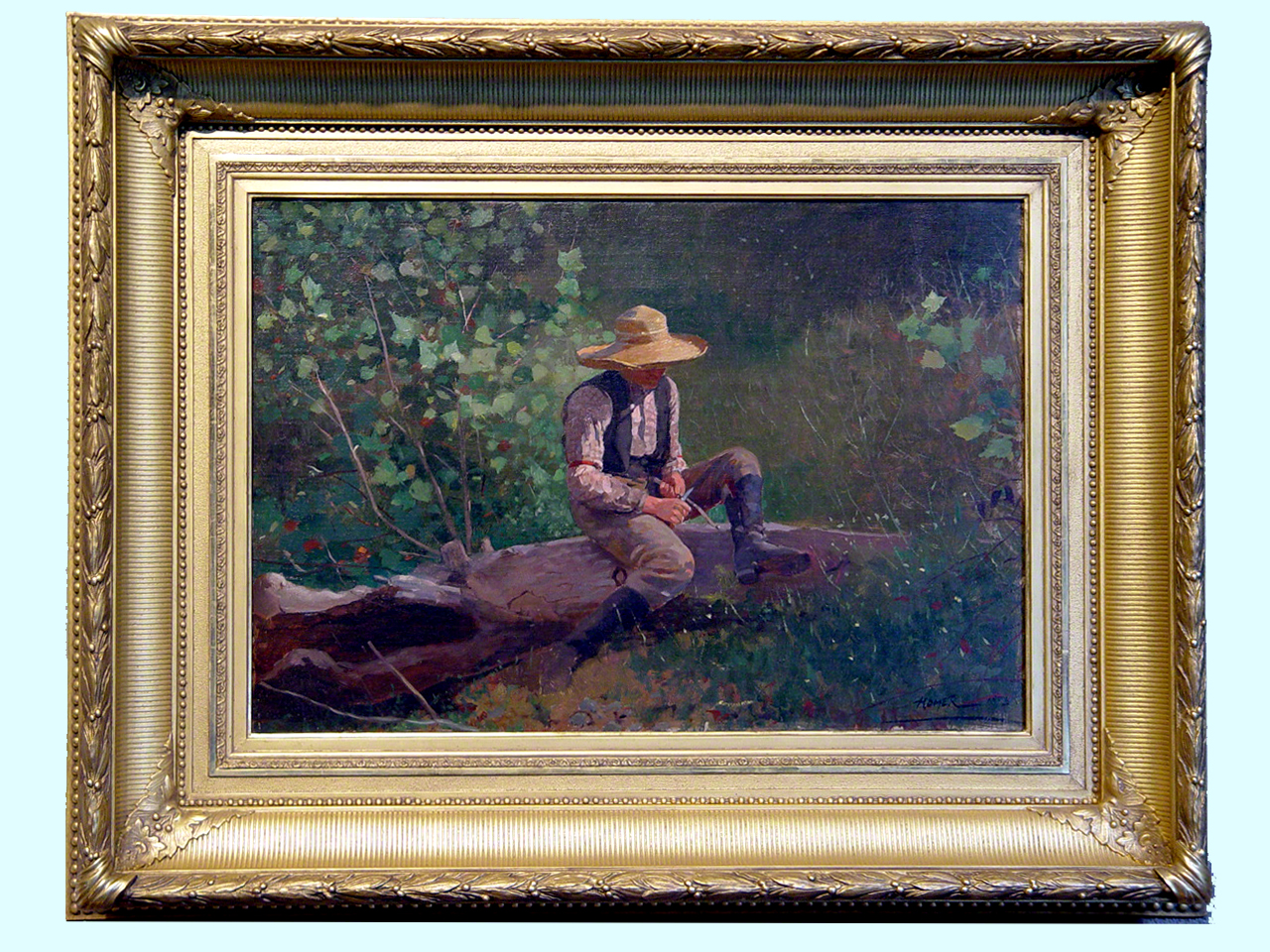
WINSLOW HOMER (1836 – 1910)
The Whittling Boy, 1873, oil on canvas, 15-3/4" x 22-11/16", period c. 1870s American painting frame, gilded applied composition ornament on wood; molding width: 5-1/4” . Terra Foundation for American Art, Daniel J. Terra Collection, 1994.12
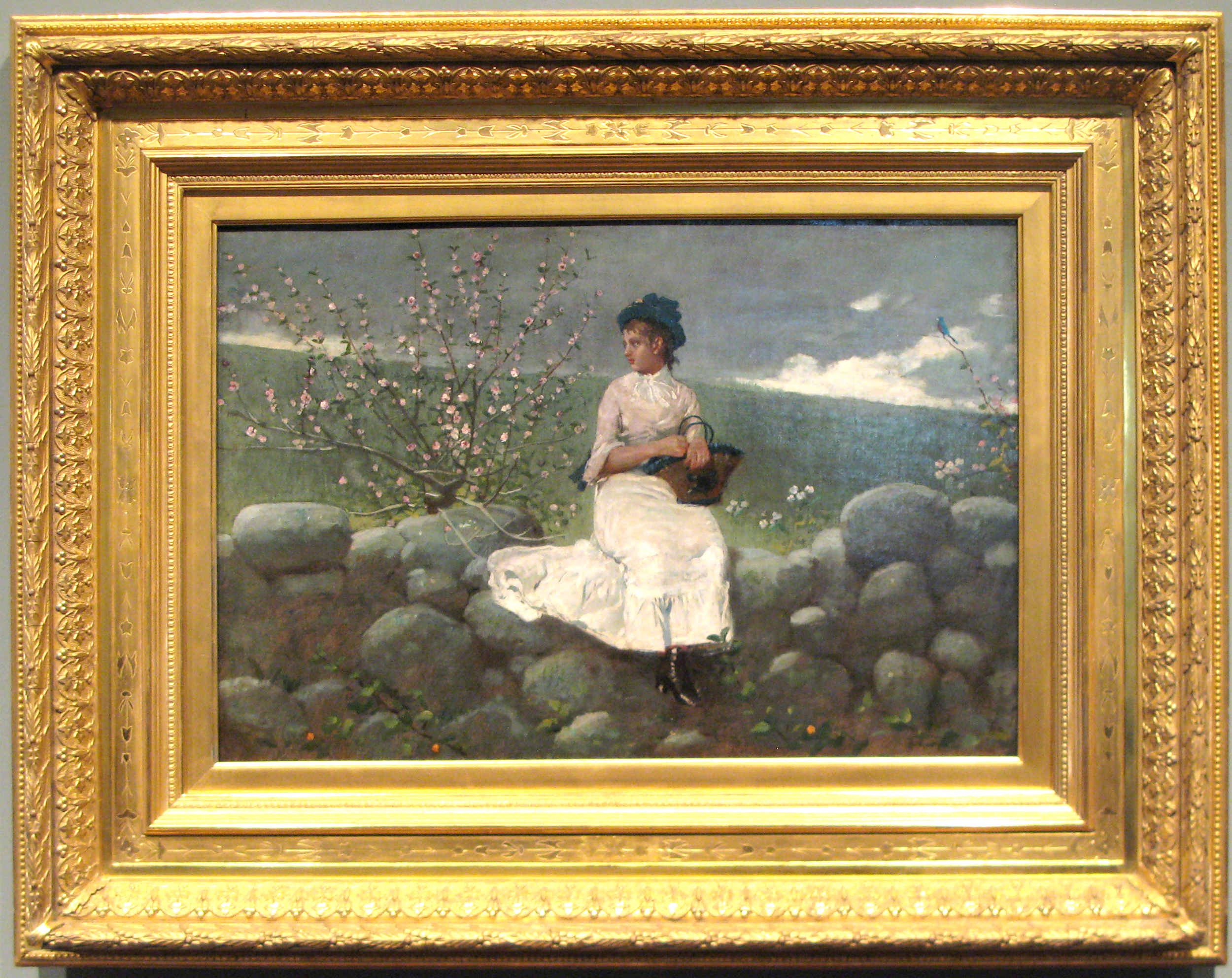
WINSLOW HOMER (1836 – 1910)
Peach Blossoms, 1878, Oil on canvas, 13-1/4" x 19-5/8", period c. 1870s American Doll & Richards frame, gilded applied composition ornament with incised matte and burnished frieze. "Winslow Homer often depicted scenes of leisure in his early career. This painting features a young woman looking at burgeoning peach blossoms, indicating both early spring and perhaps her youth. The setting, which often recurs in Homer's oeuvre, reflects nostalgia for a fading rural past. Contemporary critics referred to the artist's style at this time as independent of foreign influences, suggesting an inherently American quality. However, his stylistic decisions link this work to both French and Japanese art. Impressionism inspired Homer's use of a lighter palette, and the attention to linearity in the tree is reminiscent of Japanese calligraphy. The painting thus serves as visual evidence of the global artistic exchange of the late 19th century." — Art Institute of Chicago, permanent collection label

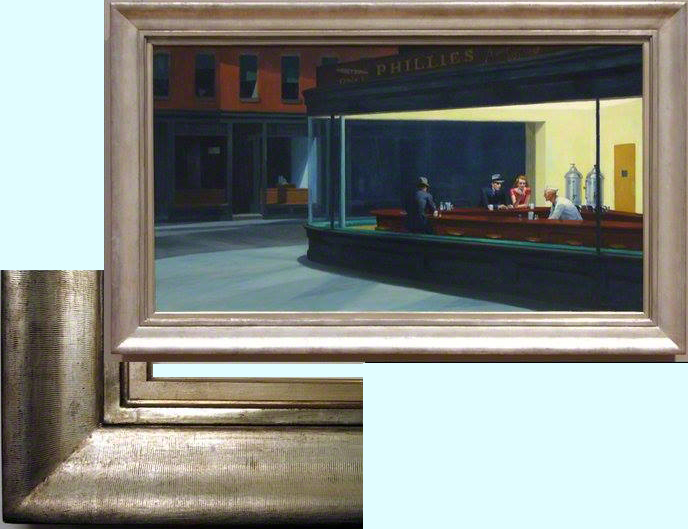
EDWARD HOPPER (1882 – 1967)
Nighthawks, 1942, oil on canvas, 33-1/8 x 60 inches, custom-designed, gilded, and patinated frame, 9-karat gray-gold leaf over fine-combed gesso and cast ornament on carved wood; custom-fabricated in the Gill & Lagodich New York studios; combed pattern, ogee profile, and gilded patina based on original Hopper frame models. "Edward Hopper said that Nighthawks was inspired by “a restaurant on New York’s Greenwich Avenue where two streets meet,” but the image—with its carefully constructed composition and lack of narrative—has a timeless, universal quality that transcends its particular locale. One of the best-known images of twentieth-century art, the painting depicts an all-night diner in which three customers, all lost in their own thoughts, have congregated. Hopper’s understanding of the expressive possibilities of light playing on simplified shapes gives the painting its beauty. Fluorescent lights had just come into use in the early 1940s, and the all-night diner emits an eerie glow, like a beacon on the dark street corner. Hopper eliminated any reference to an entrance, and the viewer, drawn to the light, is shut out from the scene by a seamless wedge of glass. The four anonymous and uncommunicative night owls seem as separate and remote from the viewer as they are from one another. (The red-haired woman was actually modeled by the artist’s wife, Jo.) Hopper denied that he purposefully infused this or any other of his paintings with symbols of human isolation and urban emptiness, but he acknowledged that in Nighthawks “unconsciously, probably, I was painting the loneliness of a large city.” — Art Institute of Chicago, Essential Guide, 2013, p. 58 Photo below: Nighthawks on view at l'exposition "Edward Hopper", Grand Palais, Paris, October 2012 – January 2013.
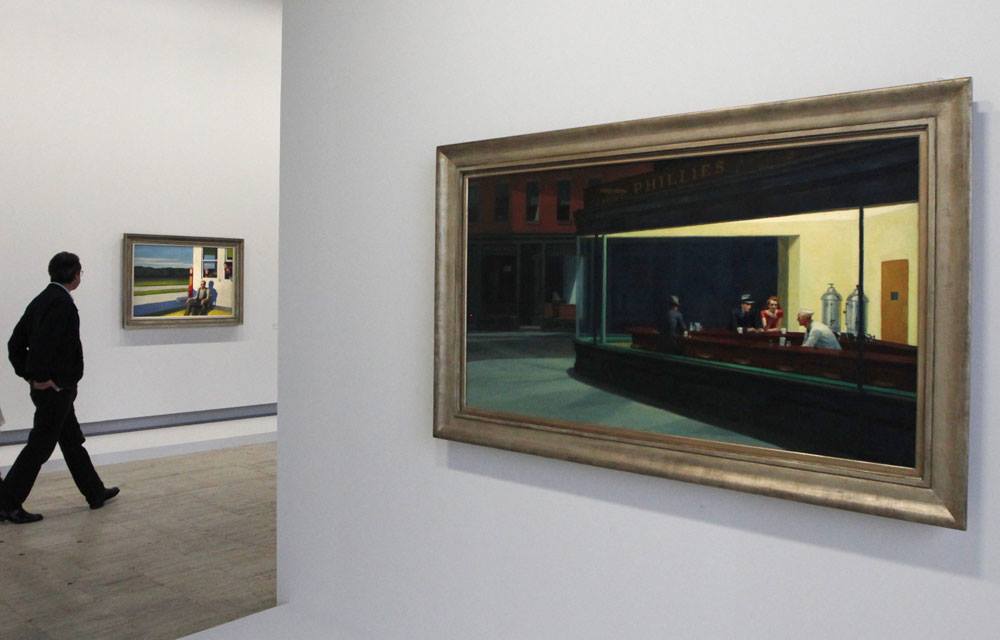
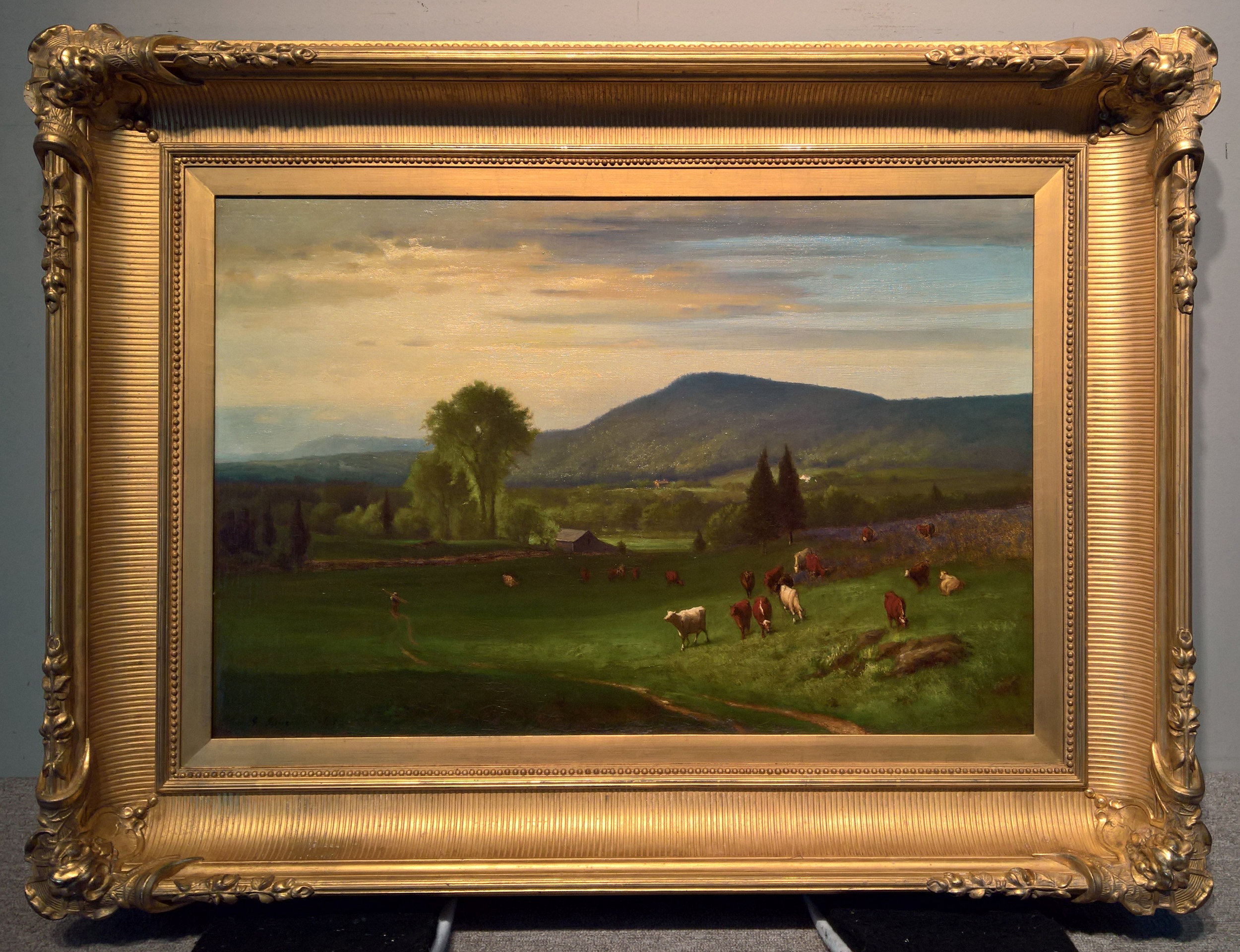
GEORGE INNESS (1825–1894)
Summer in The Catskills, 1867, oil on canvas, 20 x 30-1/2 inches, c. 1860s American painting frame; gilded applied composition ornament on wood, molding width 5-3/4 inches. Edward B. Butler Collection, 1912.1837
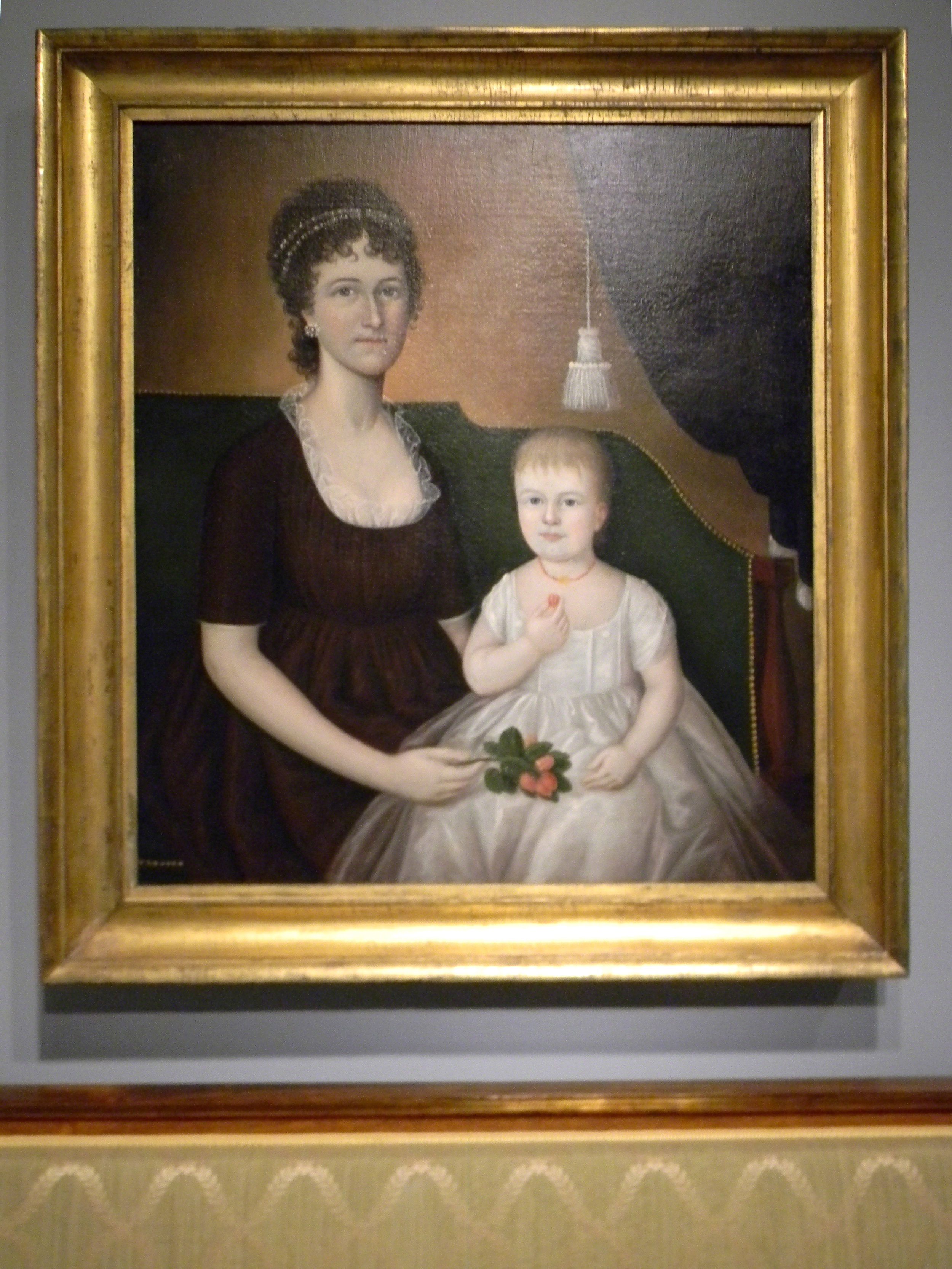
JOSHUA JOHNSON (active 1796–1824)
Mrs. Andrew Bedford Bankson and Son, Gunning Bedford Bankson, 1803/1805, oil on canvas 38 x 32 in. Framed by Gill & Lagodich for the Art Institute of Chicago, period early 19th century American gilded wood scoop molding frame, molding width 3-1/2 inches. "Joshua Johnson was the nation’s first professional African American painter of prominence. Listed in the 1816 Baltimore city directory as a “free householder of Colour,” he was born into slavery and freed by his owner (and father) shortly after 1782. Through his ties to abolitionists, Johnson attracted local patrons from the city’s artisan and middle-class families, such as the Banksons. The emphasis on fashion in this painting is characteristic of much of Johnson’s portraiture. When permitted, the artist preferred to bedeck his female sitters with jewelry. Mrs. Bankson’s hair is bound with a double circlet of light glass beads that accentuates her brown hair and gray eyes. The child’s clothes are equally elegant; he sports a high-waisted, white-muslin gown and holds a brightly colored strawberry, a delicacy that Johnson often included in his portraits.” — AIC permanent collection label.
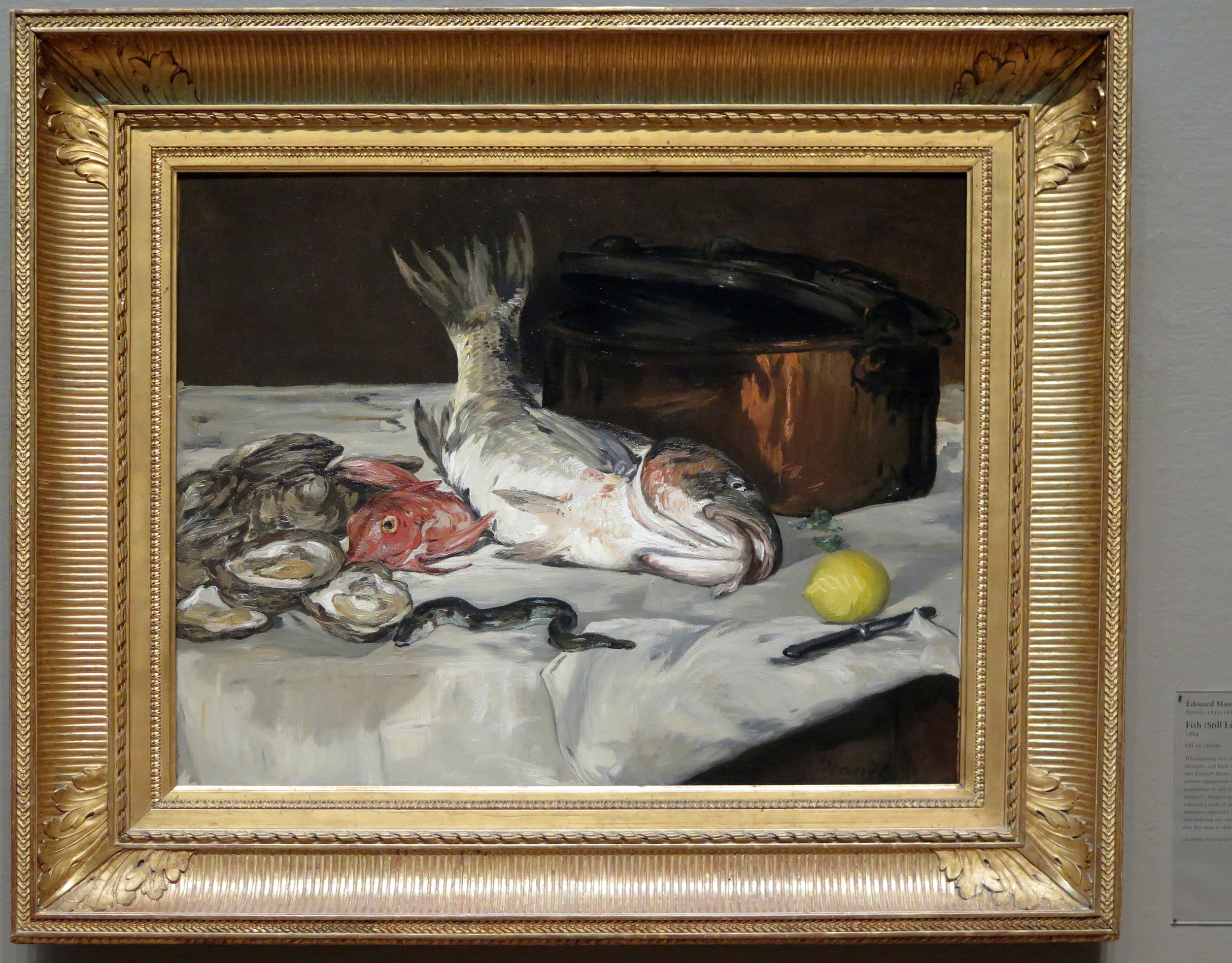
EDOUARD MANET (1832–1883)
Fish (Still Life), 1864, oil on canvas, 29” x 36-3/8”, period 19th-century French Neo-classical painting frame. “This imposing view of carp, red mullet, eel, oysters, lemon, stockpot, and knife is one of numerous still-life subjects that Edouard Manet painted in 1864, the year of his most intense engagement with the genre. Although the French translation of still life is nature morte (literally, “dead nature”), Manet’s painting seems very much alive. He achieved a sense of immediacy by strategically positioning elements—especially the precariously balanced knife and still-slithering eel—along the diagonal of the tablecloth, so that they seem to slide forward into the viewer’s space.” —Art Institute of Chicago, permanent collection label
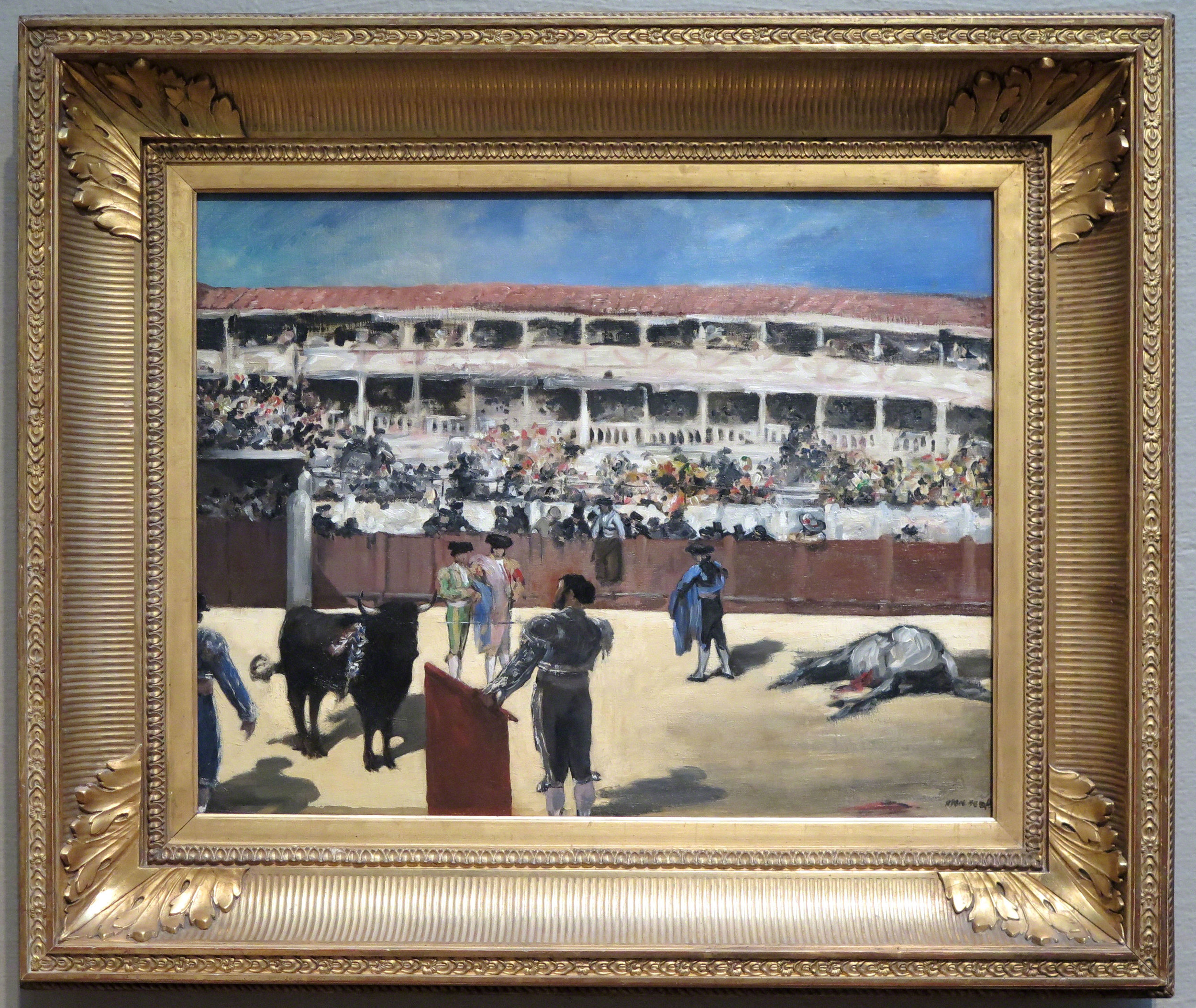
EDOUARD MANET (1832–1883)
Bullfight, 1865/66, oil on canvas, 19 x 23-3/4 inches, period 19th-century French Neo-classical painting frame, molding width 5-1/8 inches. “Edouard Manet’s trip to Spain in the fall of 1865 lasted only about 10 days, though it had a profound impact on him. In a letter to his friend the poet Charles Baudelaire, he described a bullfight he attended in Madrid as “one of the finest, most curious and most terrifying sights to be seen.” He made quick sketches there that informed several later canvases, including this one. Here he presented the moment of truth, as bullfighter and bull face one another, a gored horse lies dead or dying on the sand.” —Art Institute of Chicago, permanent collection label.
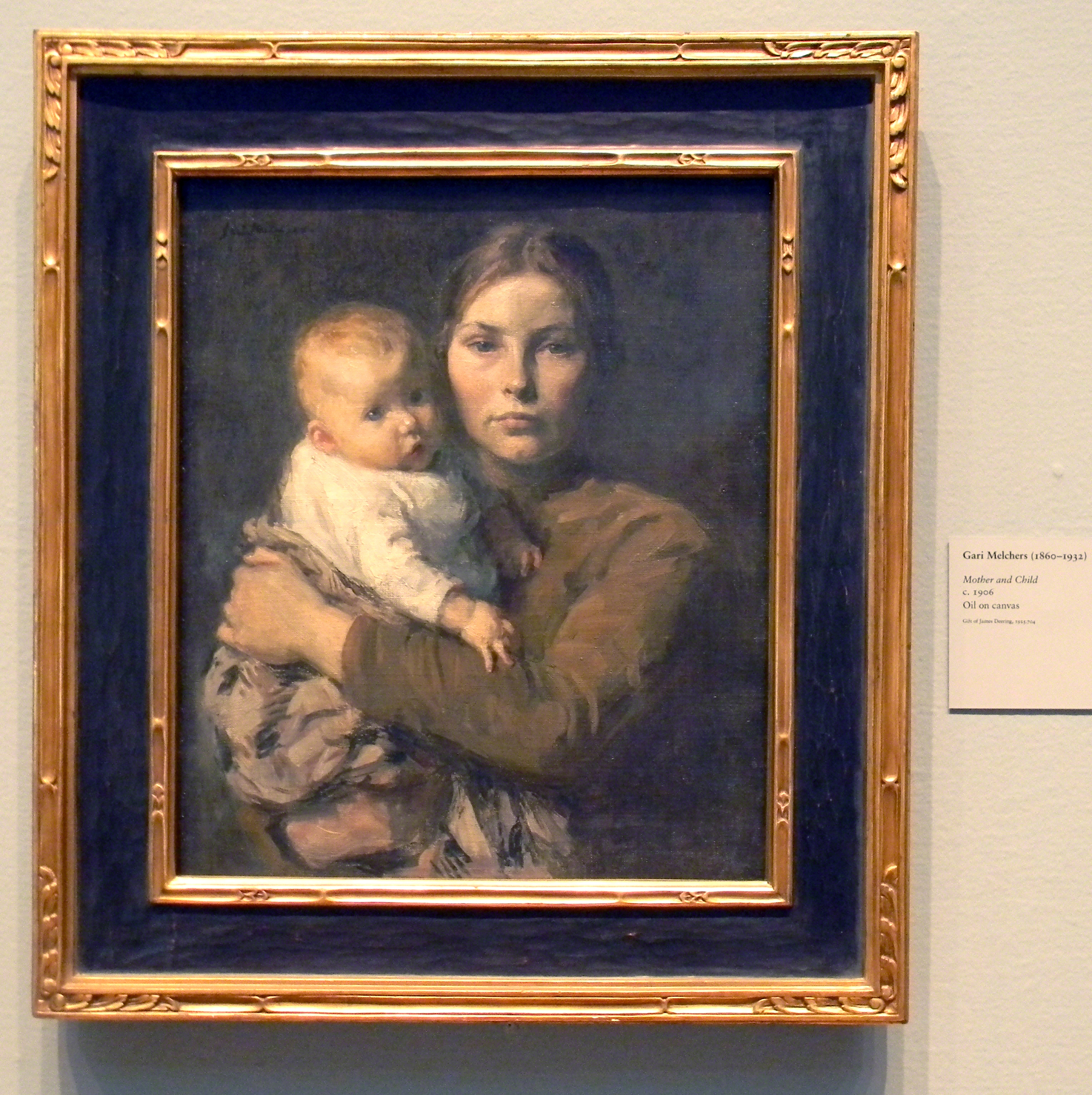
JULIUS GARI MELCHERS (1860 – 1932)
Mother and Child, oil on canvas, 25" x 21-3/8", c 1915 American George Of black cassetta frame; gilded and polychrome hand-carved wood, molding width: 4-3/4”
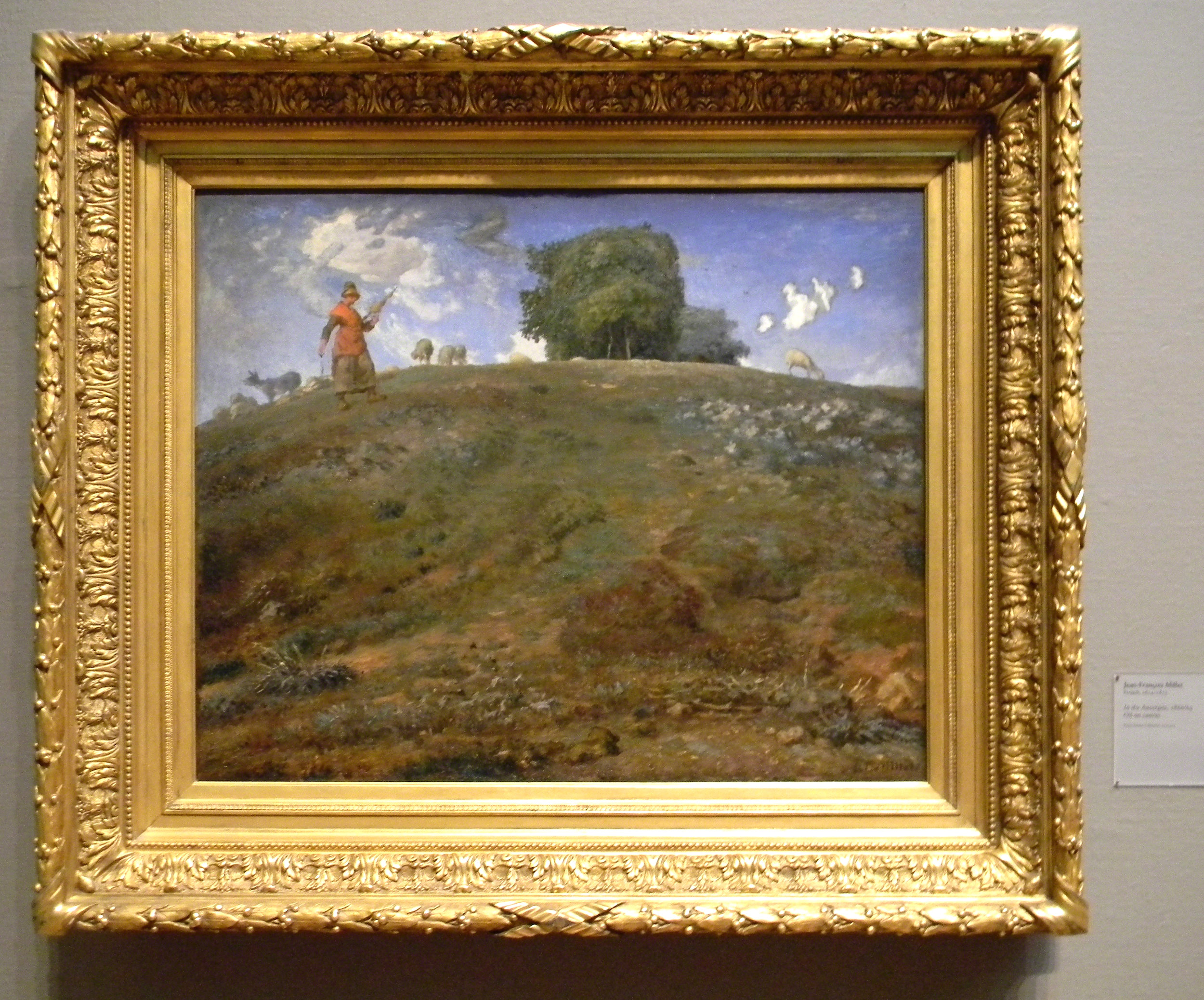
JEAN-FRANCOIS MILLET (1814–1875)
In the Auvergne, 1866/69, oil on canvas, 32-1/6 x 39-1/4 inches; French Barbizon painting frame, gilded cast ornament on wood, molding width 7-3/4". Potter Palmer Collection.
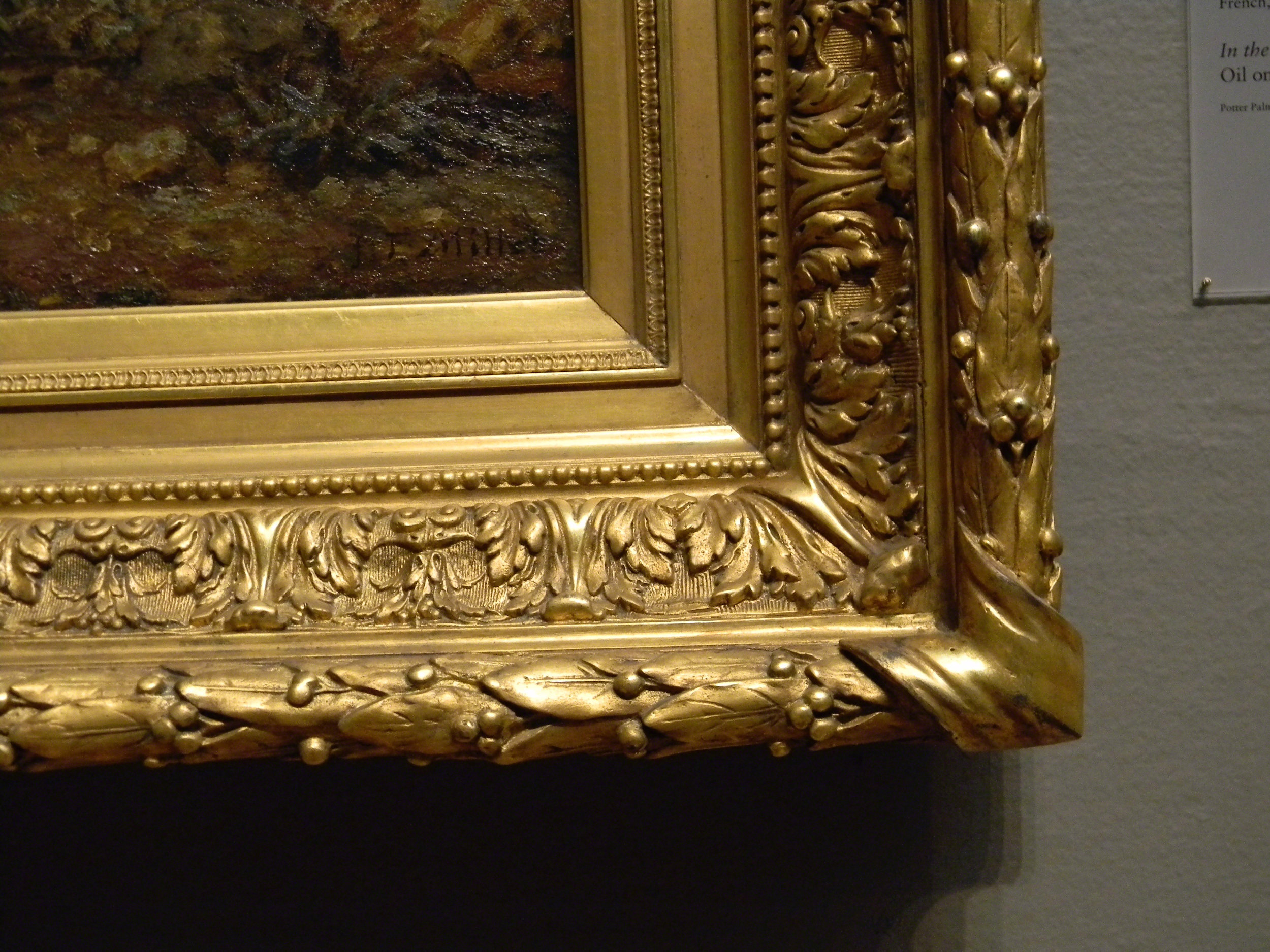
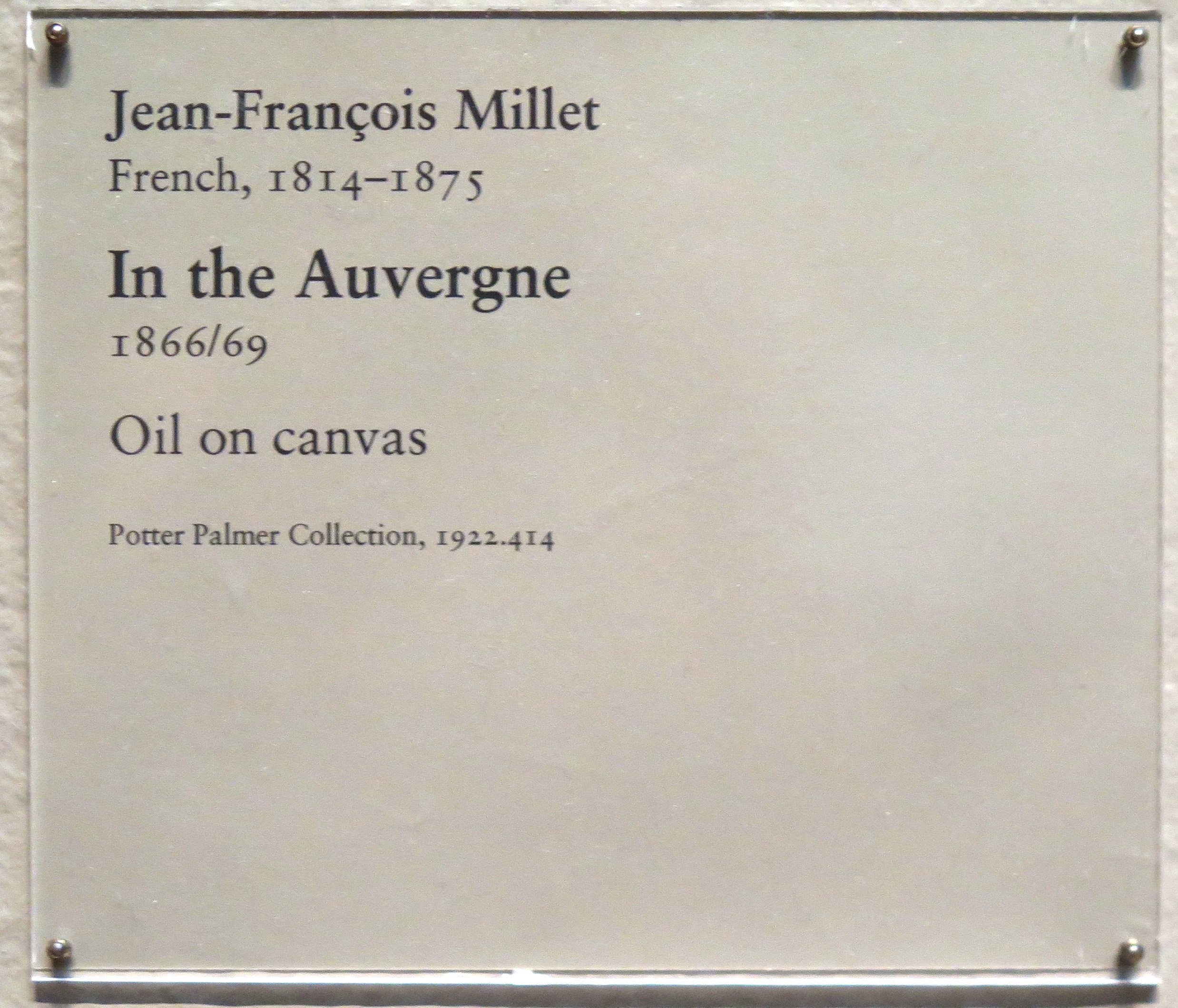
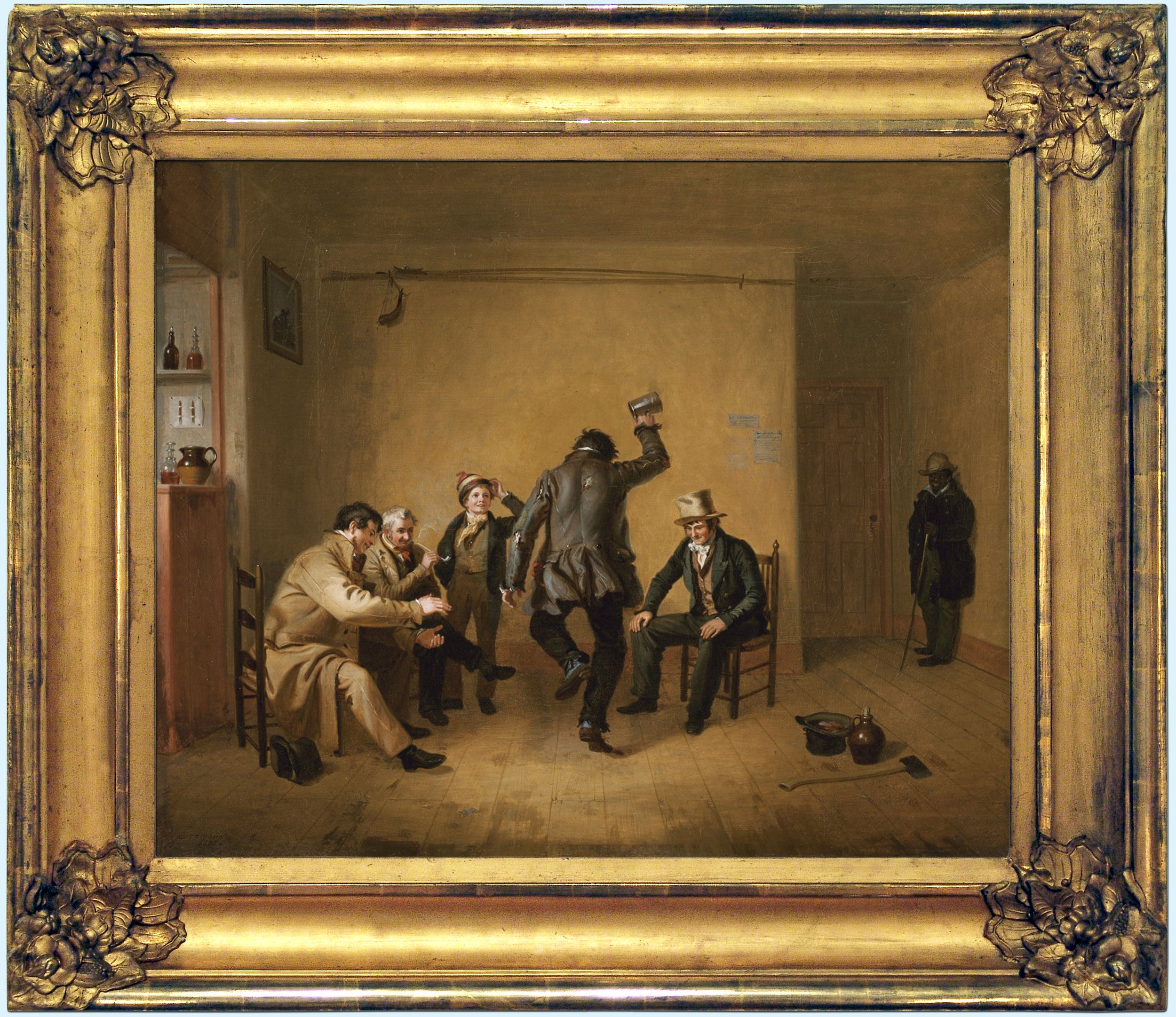
WILLIAM SIDNEY MOUNT (1807–1868)
“Bar-Room Scene”, 1835, oil on canvas, 22” x 27” c. 1840s American painting frame; gilded applied ornament on wood; molding width 4-3/4” "William Sidney Mount’s scenes of everyday life provide insight into the complex social and racial divisions of antebellum America. The central figure in this tavern is a homeless wanderer who literally dances along a line in the floorboards and, as a result, walks a symbolic line between class and race. The color of his skin unites him with the more prosperous men who urge on his drunken revelry, but his poverty makes him an outcast like the African American man in the shadows, who smiles and looks on but is not an integral part of the group." — Permanent collection label
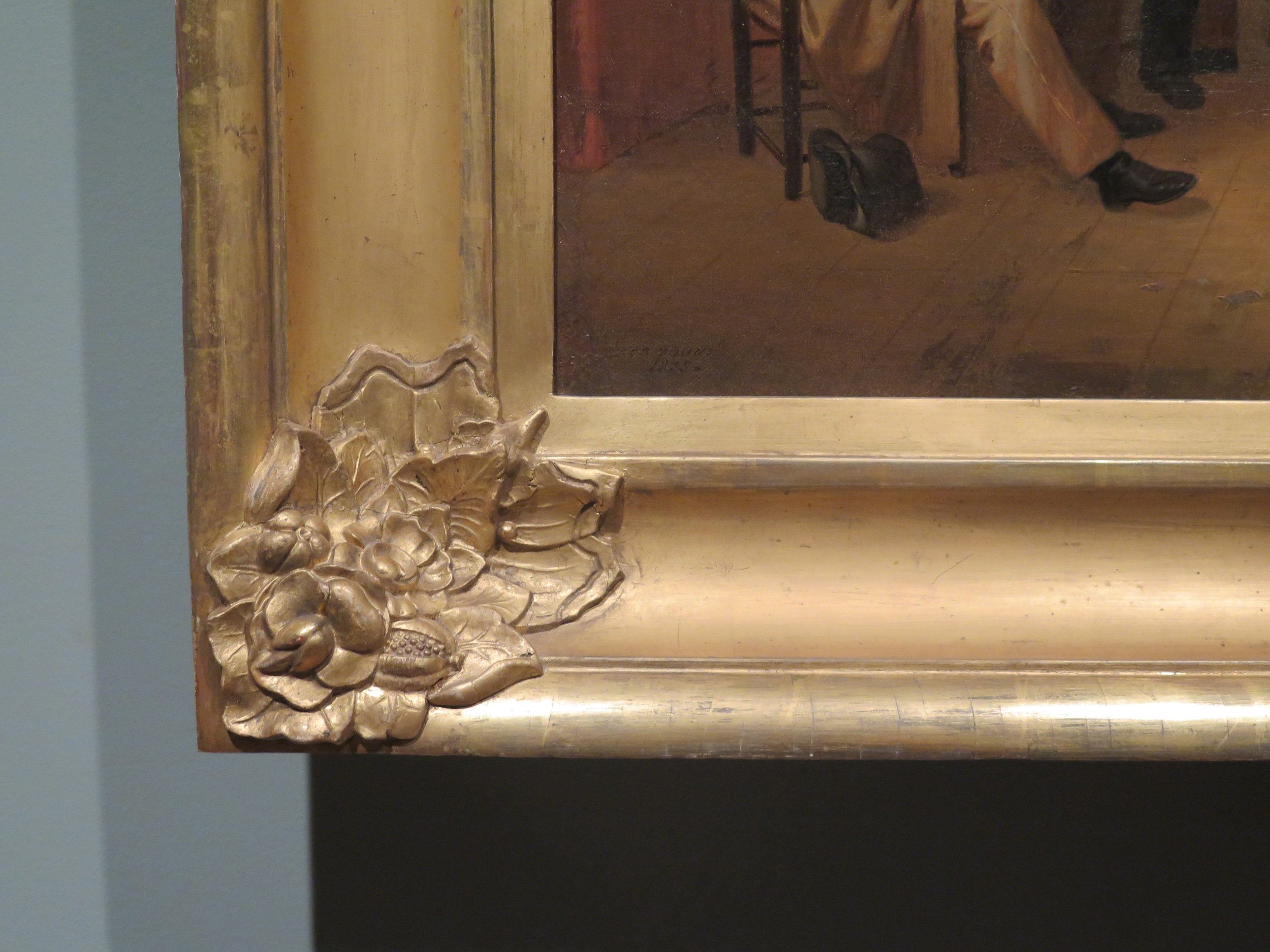
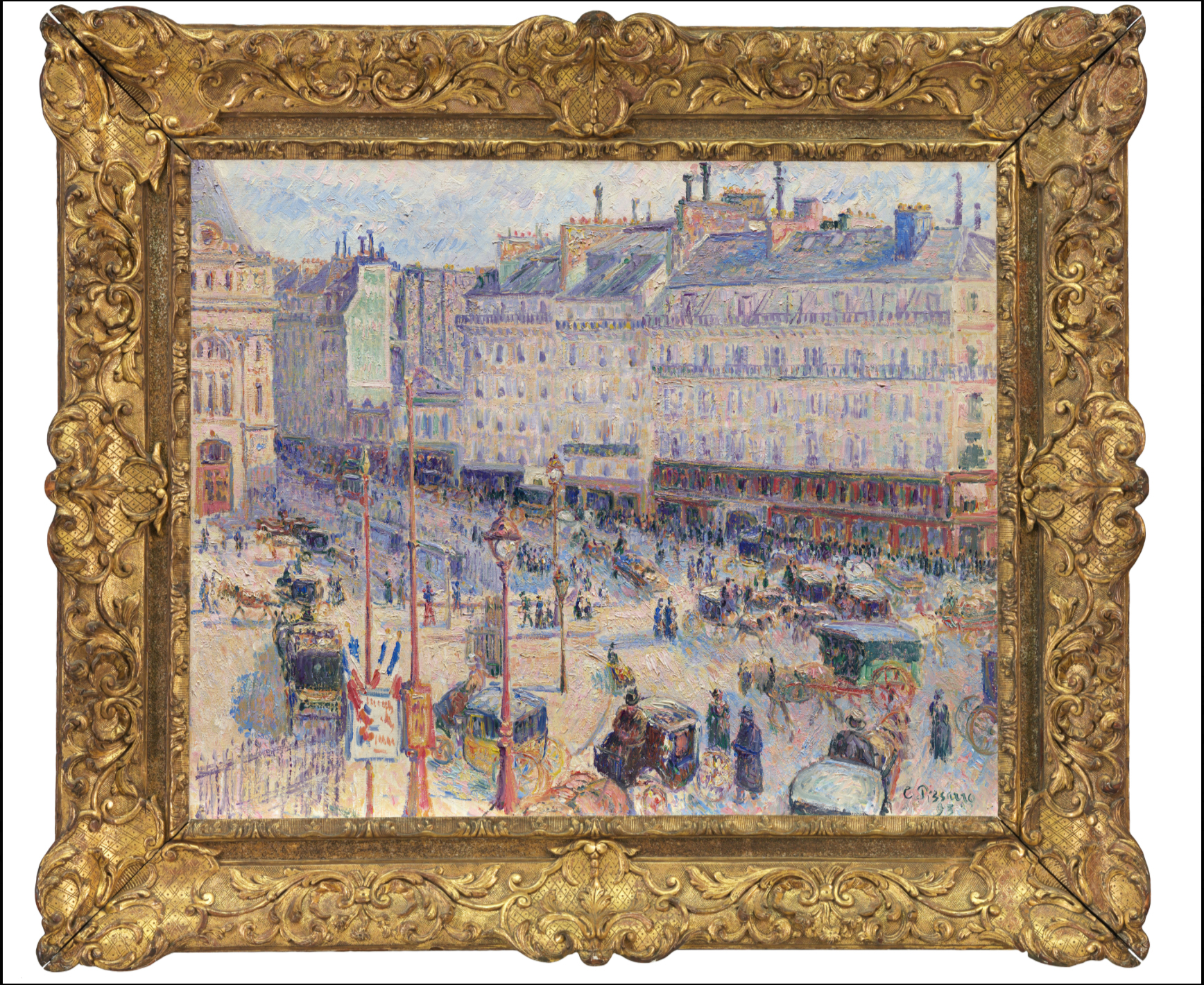
CAMILLE PISSARRO (1830–1903)
The Place du Havre, Paris, 1893, oil on canvas, 23-1/2 x 28-3/4 inches. 18th-century French Louis XIV frame, gilded hand-carved wood, molding width 4-7/8" The museum has published extensively on this painting and frame, Pissarro Paintings and Works on Paper at the Art Institute of Chicago, with painting technical report and detailed frame description, Cat. 13.
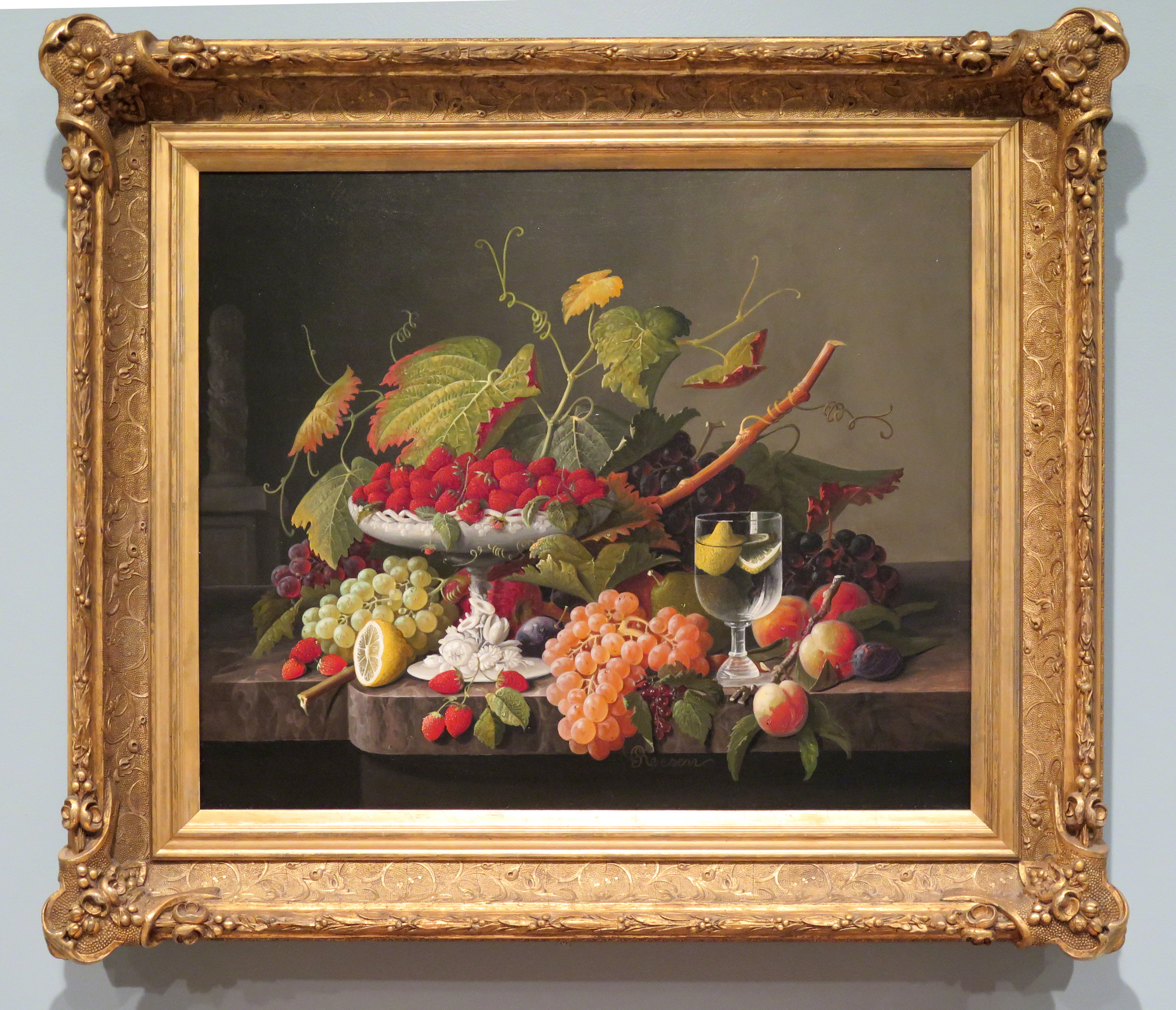
SEVERIN ROESEN (c.1816 – c.1872)
“An Abundance of Fruit”, 1860, oil on canvas, 25 x 30 inches. Period c. 1850s American painting frame; gilded applied composition ornament on wood; molding width: 5 inches. AIC Americana Fund, 2004.2

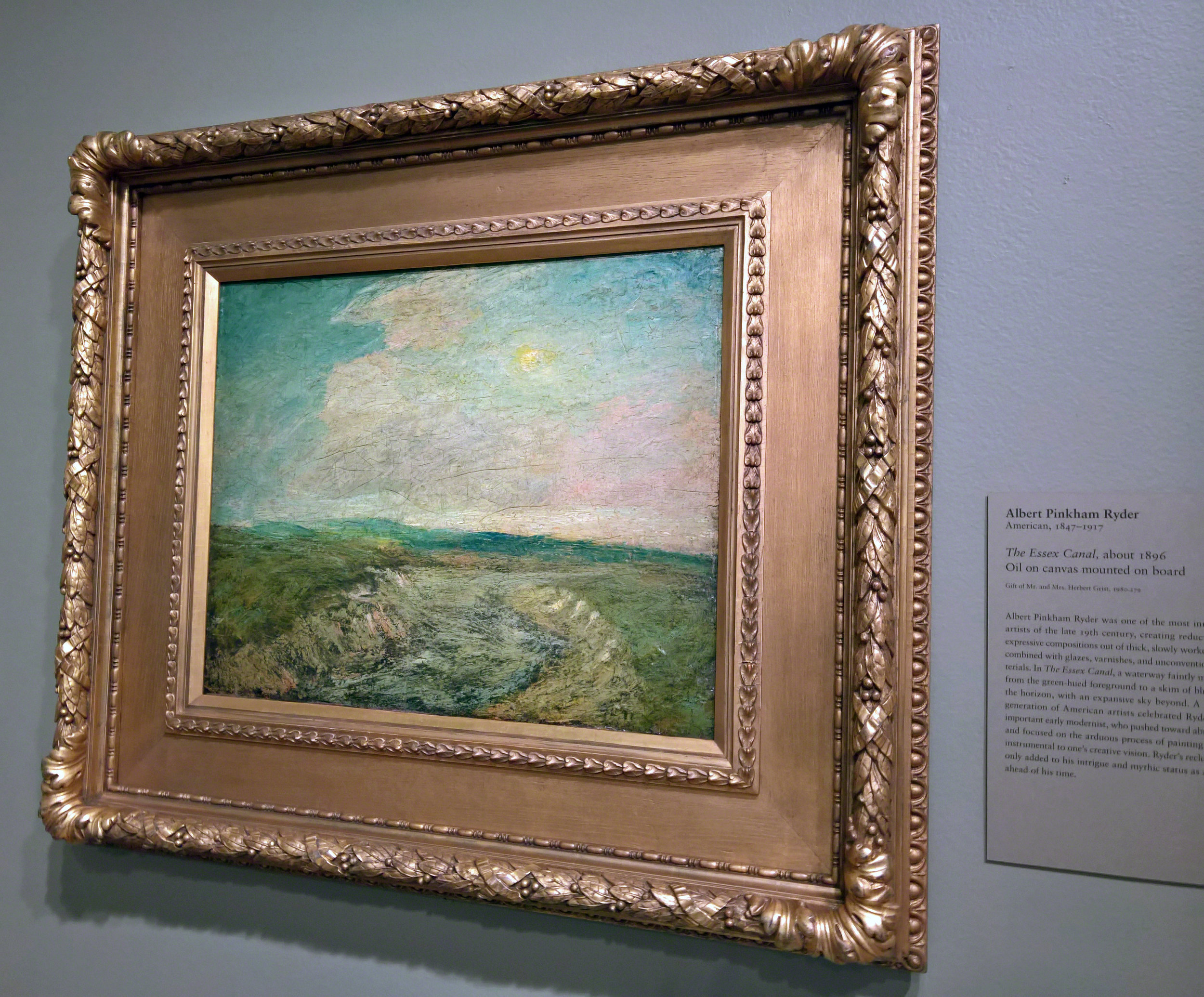
ALBERT PINKHAM RYDER (1847–1917)
The Essex Canal, c. 1896, oil on canvas mounted on board, 16-5/16 x 20-1/4 in. Period c. 1880s-90s American painting frame, gilded applied composition ornament on wood, wide gilded oak frieze, molding width 6-3/8 in. "Albert Pinkham Ryder was one of the most innovative artists of the late 19th century, creating reductive, yet expressive compositions out of thick, slowly worked paint, combined with glazes, varnishes, and unconventional materials. In The Essex Canal, a waterway faintly meanders from the green-hued foreground to a skim of blue along the horizon, with an expansive sky beyond. A younger generation of American artists celebrated Ryder as an important early modernist, who pushed toward abstraction and focused on the arduous process of painting itself as instrumental to one’s creative vision. Ryder’s reclusiveness only added to his intrigue and mythic status as an artist ahead of his time.” — AIC permanent collection label. Painting Gift of Mr. and Mrs. Herbert Geist, 1980.279
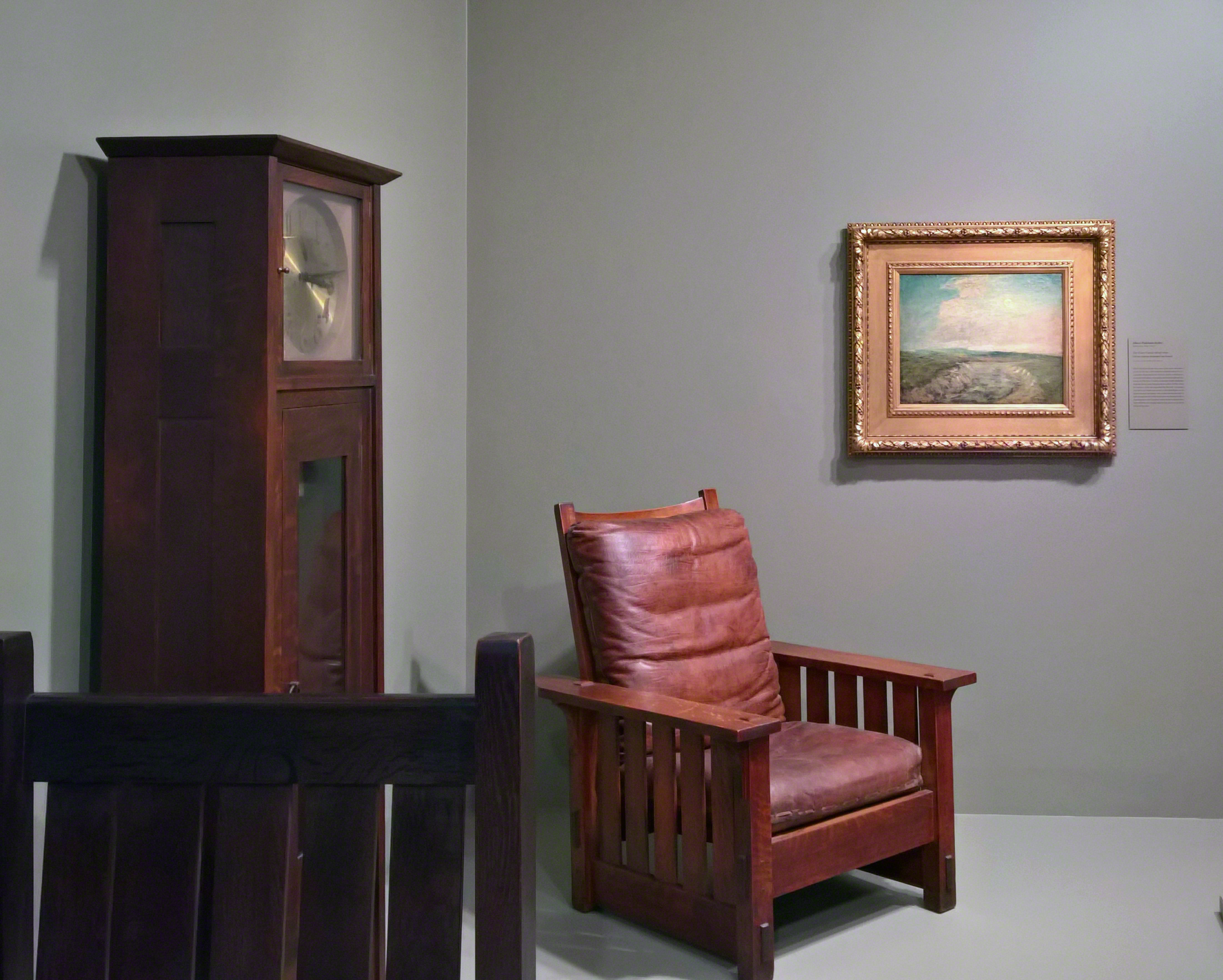
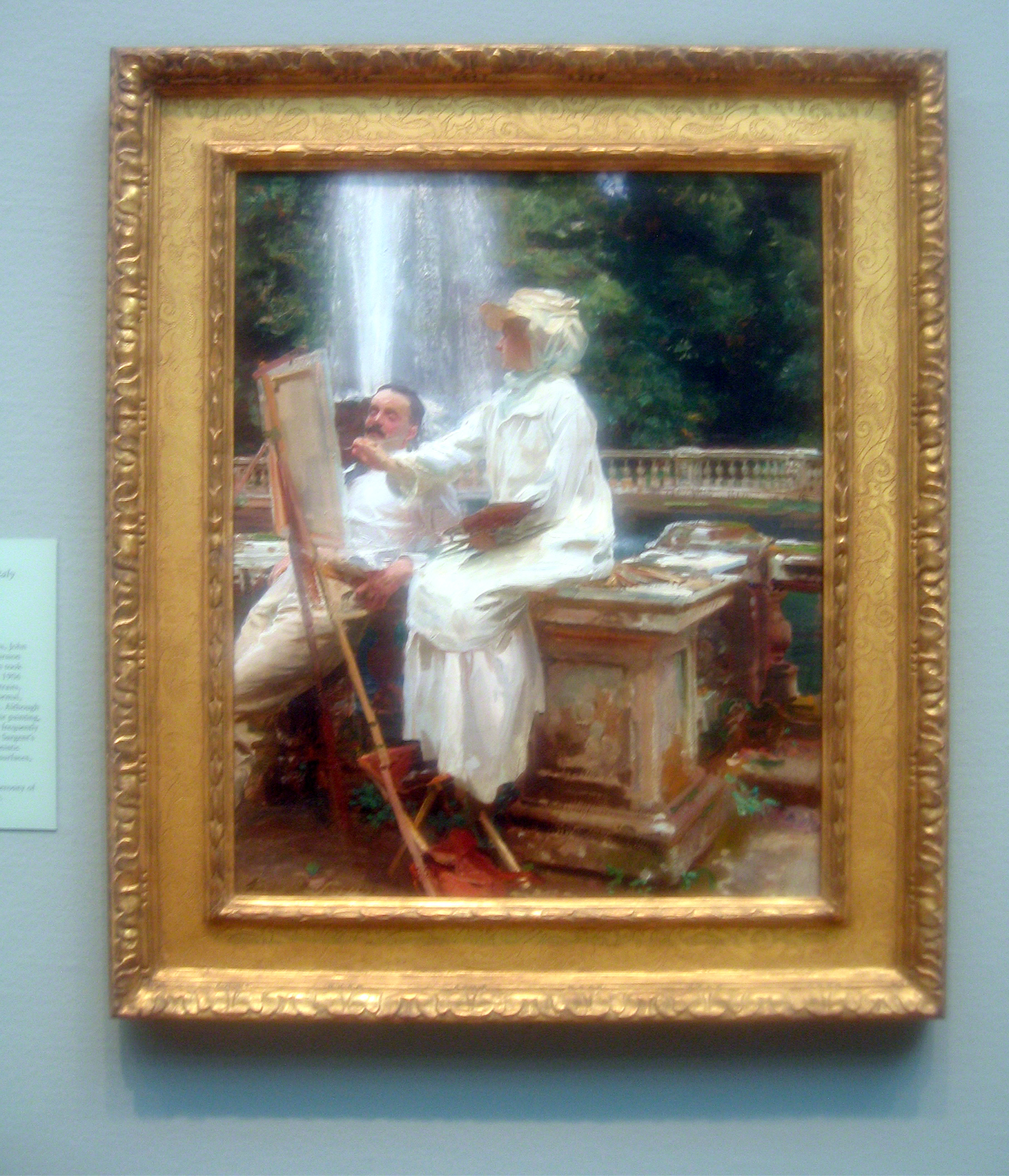
JOHN SINGER SARGENT (1856 – 1925)
The Fountain, Villa Torlonia, Frascati, Italy, 1907, oil on canvas, 28-1/8" x 22-1/4", custom-made replica, 17th-century Italianate frame, gilded hand-carved wood with punchwork frieze. "As one of the most sought-after and prolific portraitists of international high society, American expatriate John Singer Sargent painted the cosmopolitan world to which he belonged with elegance and a bravura touch. Born to American parents residing in Italy, Sargent spent his early adult life in Paris, moving to London in the mid-1880s. The artist traveled frequently, and it was during these trips that he experimented most extensively with painting en plein air, or outdoors. Set in a sunlit garden in the central Italian town of Frascati, this charming double portrait depicts Sargent’s friends and fellow artists Wilfrid and Jane Emmet de Glehn. The painting is filled with light, displaying Sargent’s characteristically dazzling surface articulated with thick impasto and virtuoso brushwork. Jane described the work as a “most amusing and killingly funny picture” in a letter to her sister Lydia. She continued: “I am all in white with a white painting blouse and a pale blue veil around my hat. I look rather like a pierrot, but have a rather worried expression as every painter should who isn’t a perfect fool, says Sargent. Wilfrid is in short sleeves, very idle and good for nothing, and our heads come against the great ‘panache’ of the fountain.'” — Art Institute of Chicago, Essential Guide, 2013, p. 47.
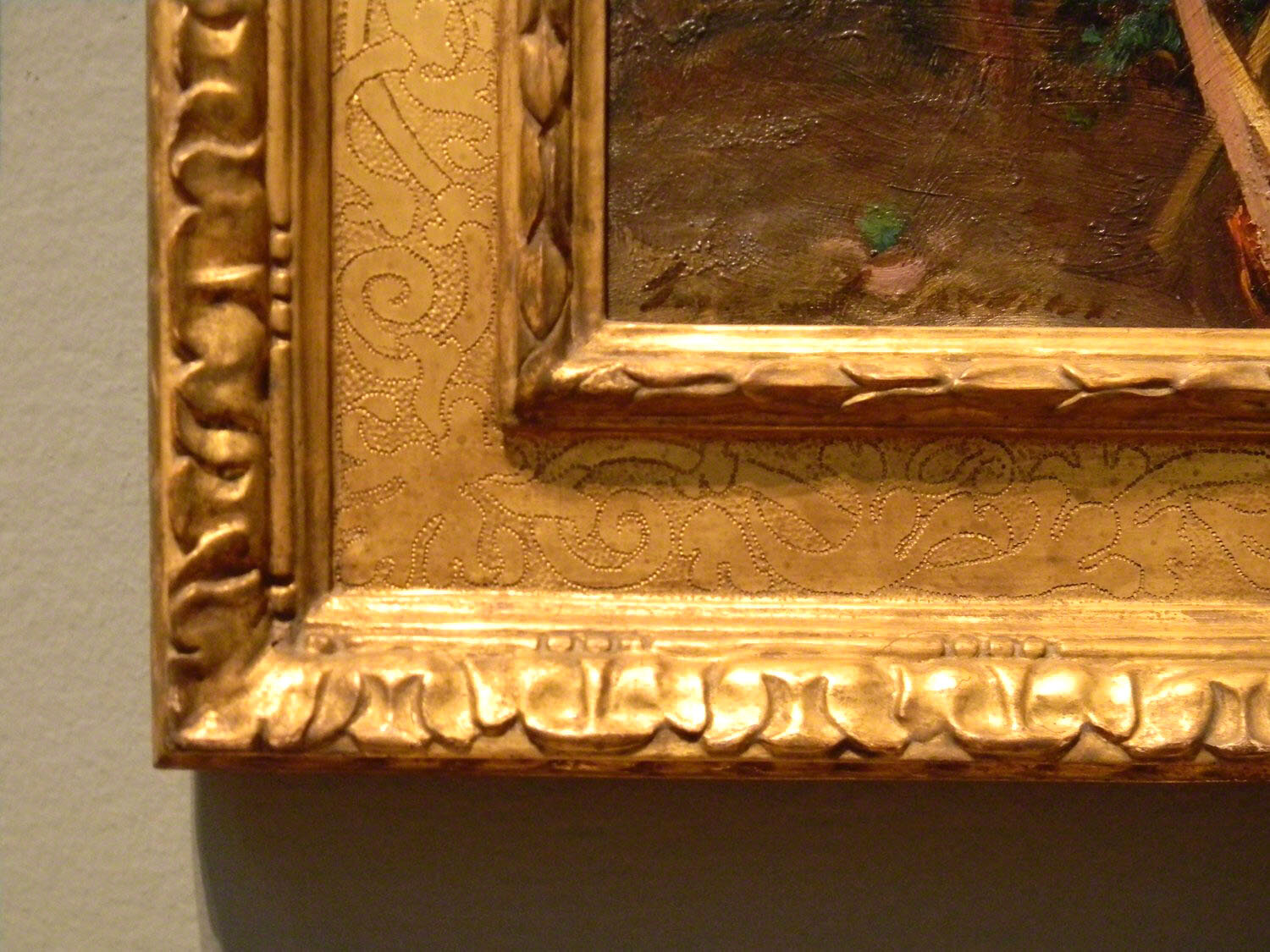
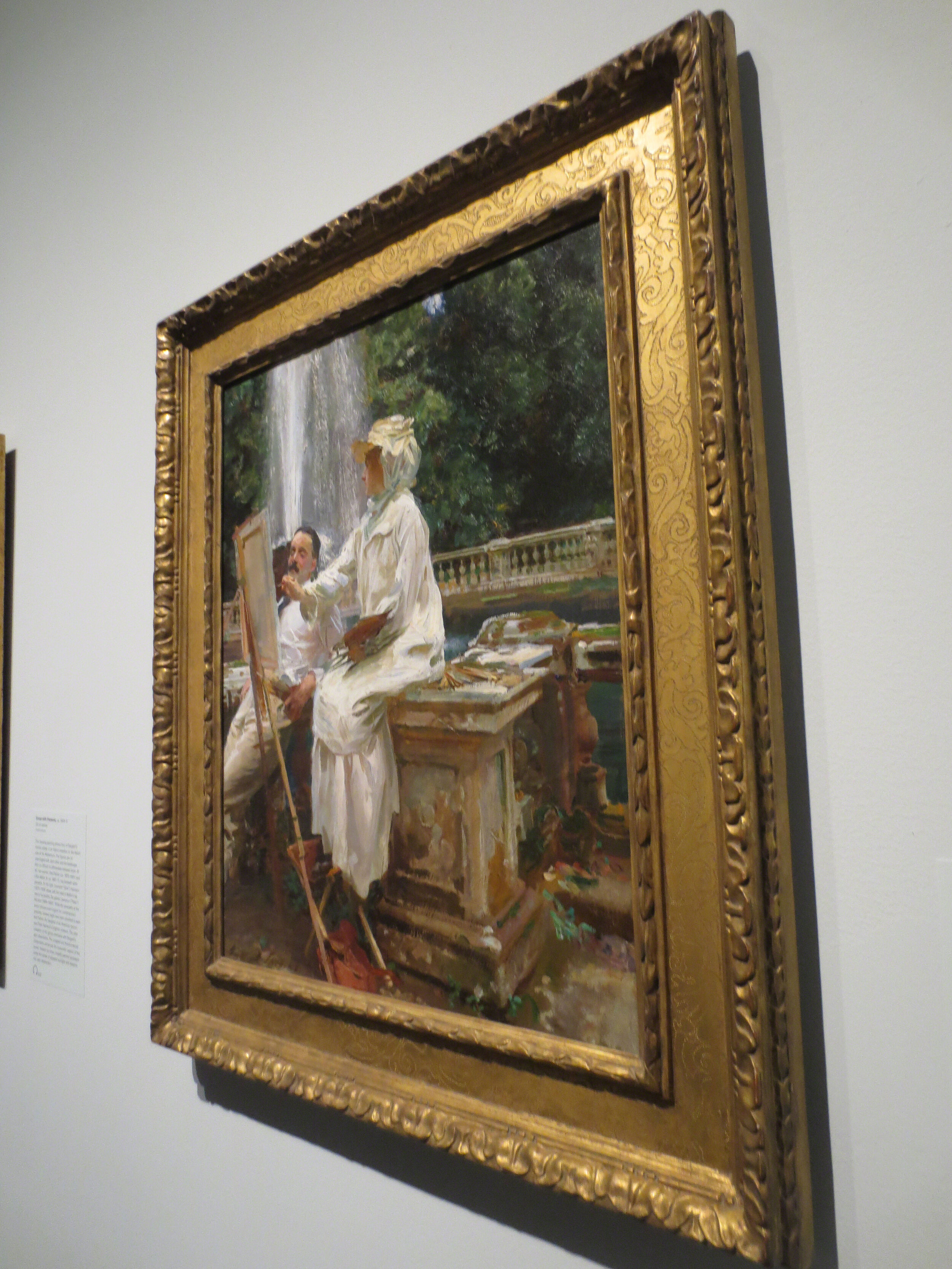

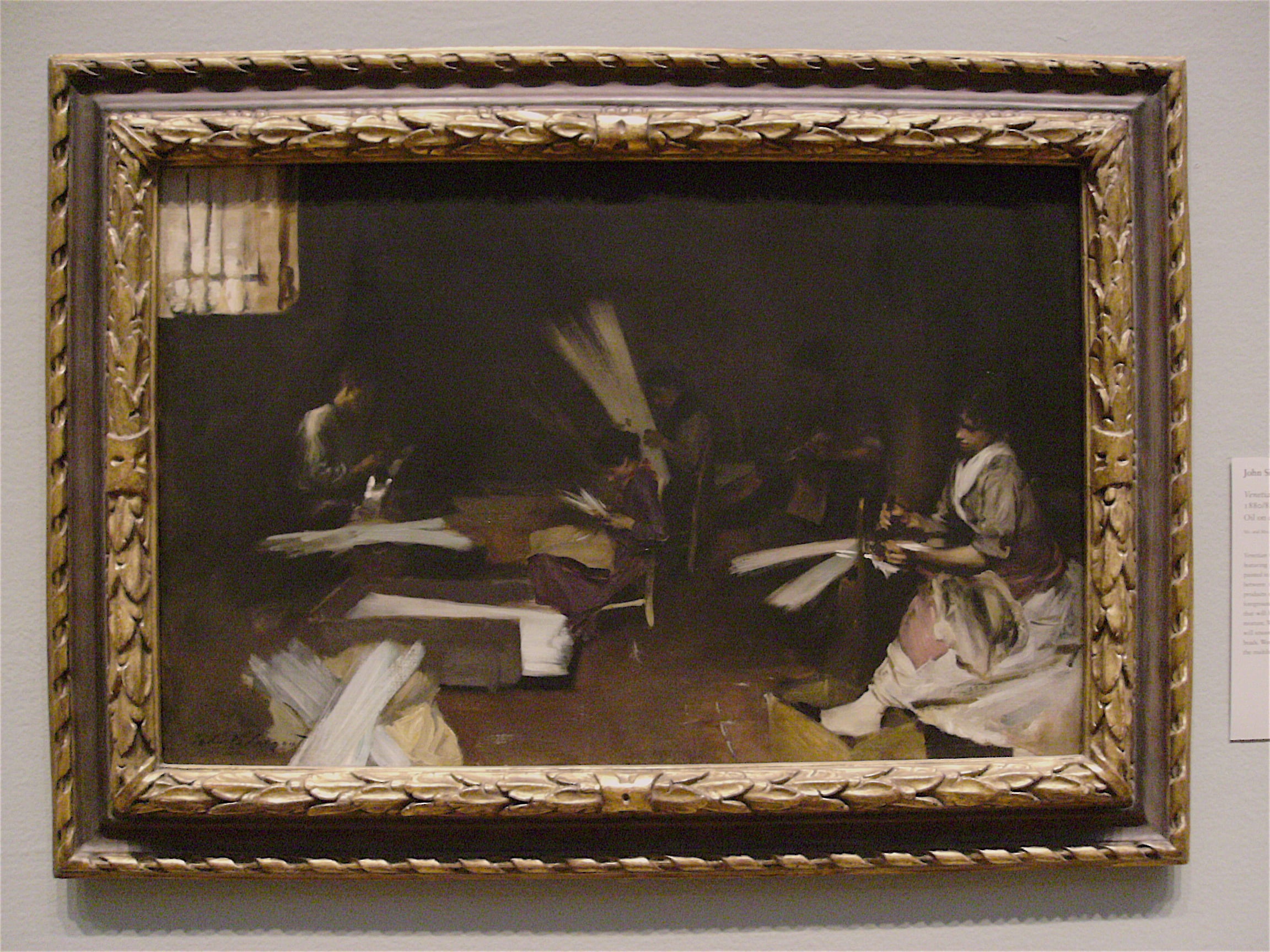
JOHN SINGER SARGENT (1856 – 1925)
Venetian Glass Workers, 1880/82, oil on canvas, 22-1/4" x 33-1/4"; custom-made replica of a 17th-century Northern Italian painting frame; gilded and polychrome hand-carved wood; molding width 4-3/8” "Illuminated with swathes of light against a dark background, bundles of thin glass rods are sorted by laborers in John Singer Sargent's Venetian Glass Workers. The woman in the right foreground is using a zocco, or cutting tool, to slice glass tubes into uniform lengths that will be placed in a metal drum with a mixture of lime, carbonate, sand, carbon, and water. When the drum is heated and turned, the mixture smoothes the edges of the cut glass and forms rounded beads. In the 1880s, Sargent painted many genre scenes featuring workers. Yet this image is noteworthy for its unusual composition, in which the lightest forms are grouped along the edges, and its dramatic brushwork. The latter shows the influence of Baroque painters such as the Spaniard Diego Vélazquez and the Dutchman Franz Hals. The glass rods have become nearly abstract dashes of color, suggesting the effect of Venice's intense light as it penetrates the space. During frequent visits to Venice, Sargent completed over 100 paintings and watercolors of the city. Devoted to music and a fine pianist, Sargent traded this and another Venetian work to a piano-maker in exchange for a piano in 1886." —museum label. Mr. and Mrs. Martin A. Ryerson Collection. 1933.1917
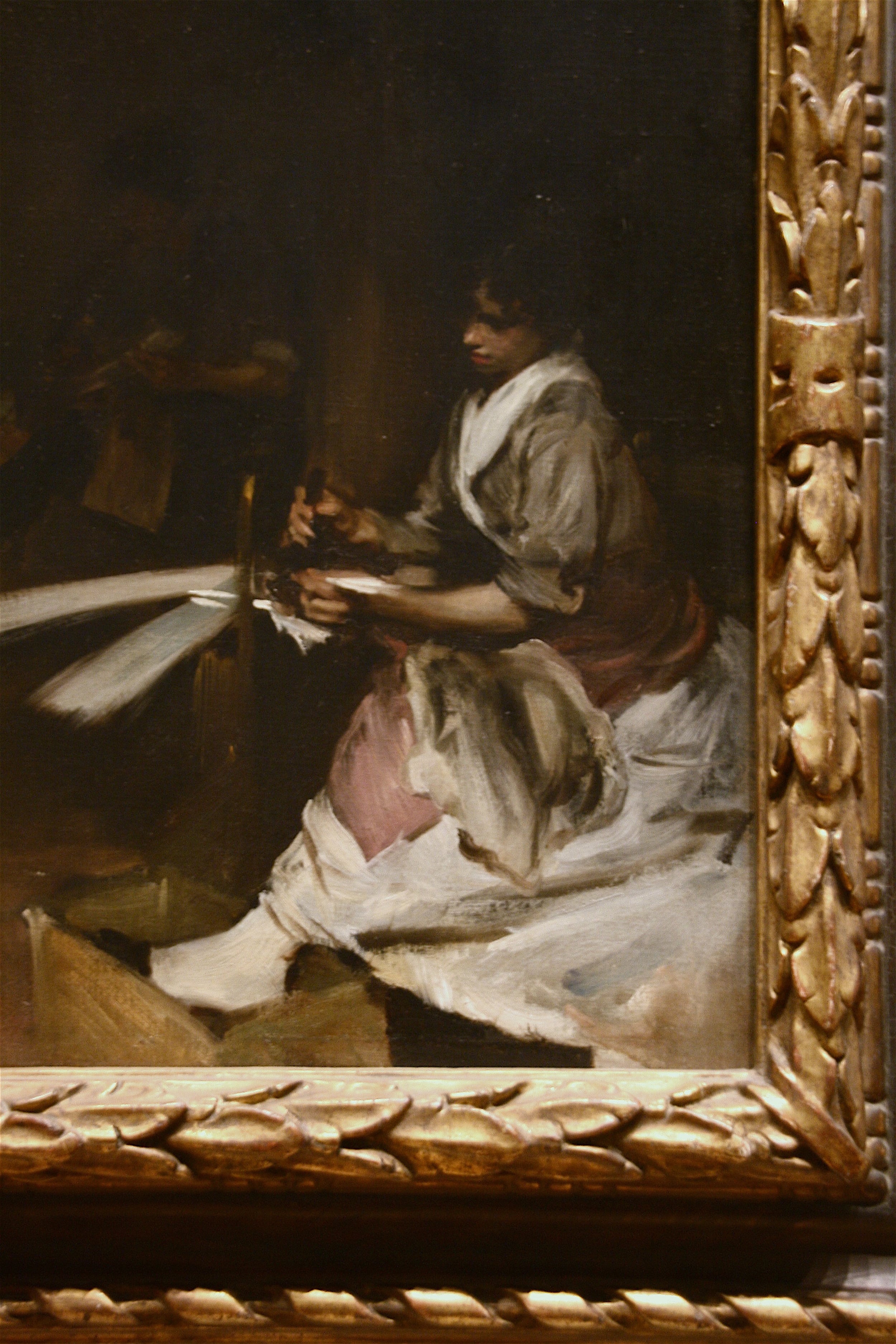
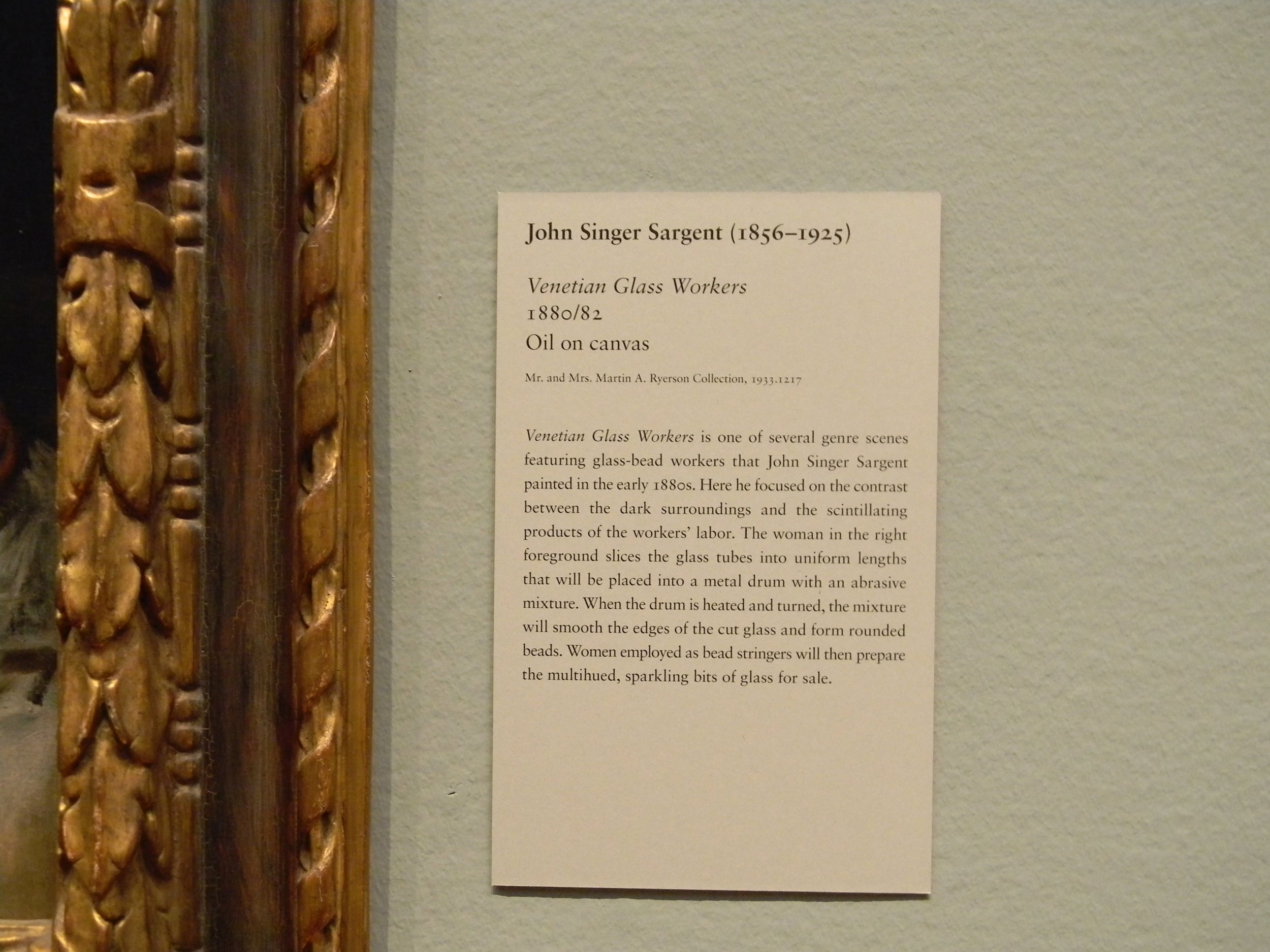
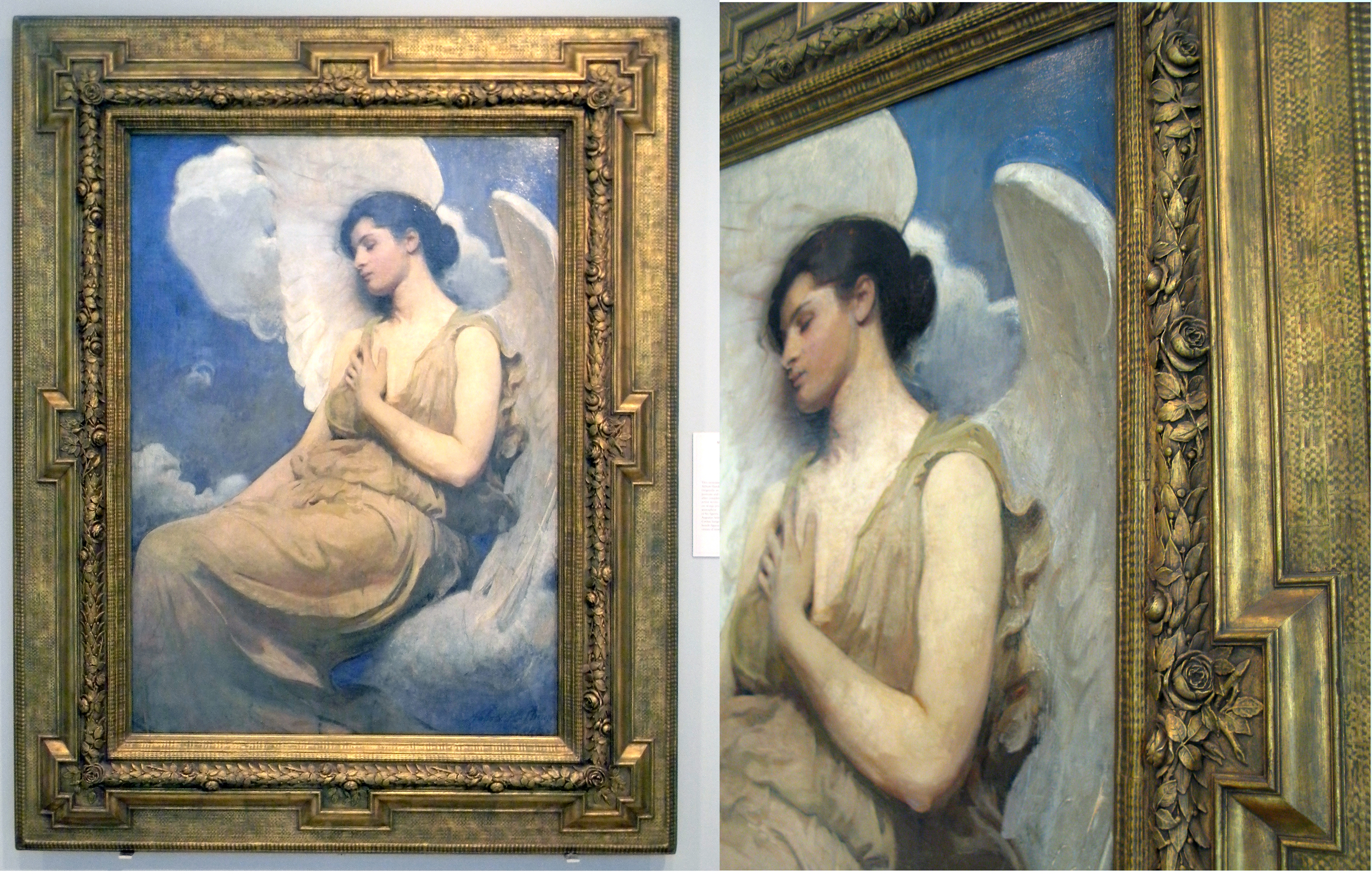
ABBOTT HANDERSON THAYER (1849 – 1921)
Winged Figure, 1889, oil on canvas, 51-1/2" x 37-3/4"; original period frame, designed by Stanford White. Frame extensively cleaned and restored by Gill & Lagodich in our New York City restoration studios.
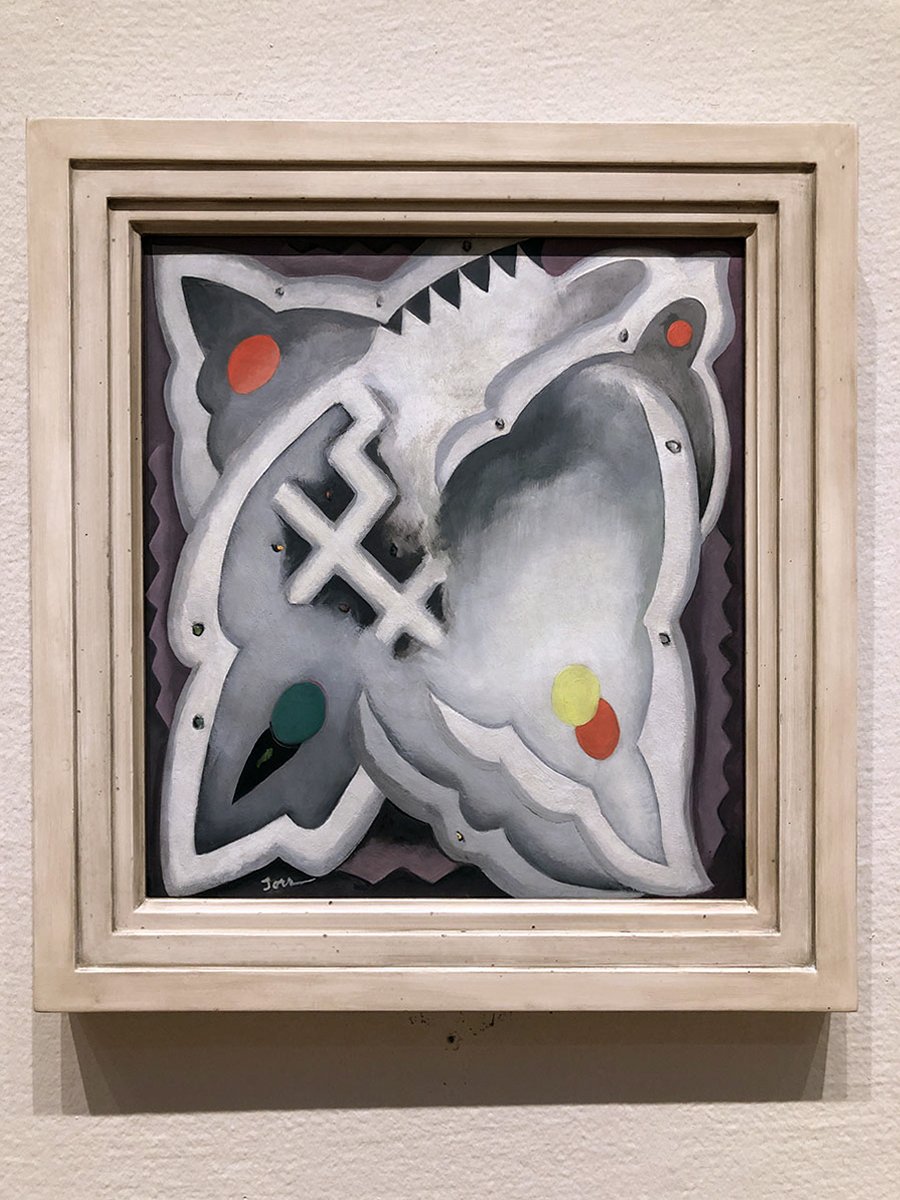
HELEN TORR (1886–1967)
Extemporaneous, 1927, oil on metal, mounted on board, 16 x 14-1/2 in. Custom-made replica c. 1910 American molding frame, patinated gesso over milled wood; molding width: 2-5/8” “Helen Torr and her husband, the painter Arthur Dove, enjoyed a richly artistic and supportive marriage as they both experimented with modernist art-making techniques. Extemporaneous is one of the most unusual works of Torr’s career, and it is striking for its irregular play of narrow bands of silvery gray, which exuberantly thrust into the corners of the composition. When Torr made Extemporaneous,she and her husband lived aboard a sailboat, and some part of its structure might well have informed this work. Certain elements recall shaped metal fittings, complete with small round circles that are reminiscent of rivets or nails. But the artist deliberately abstracted any recognizable motifs, leaving an eloquent exploration of pure form and color.” —museum label.
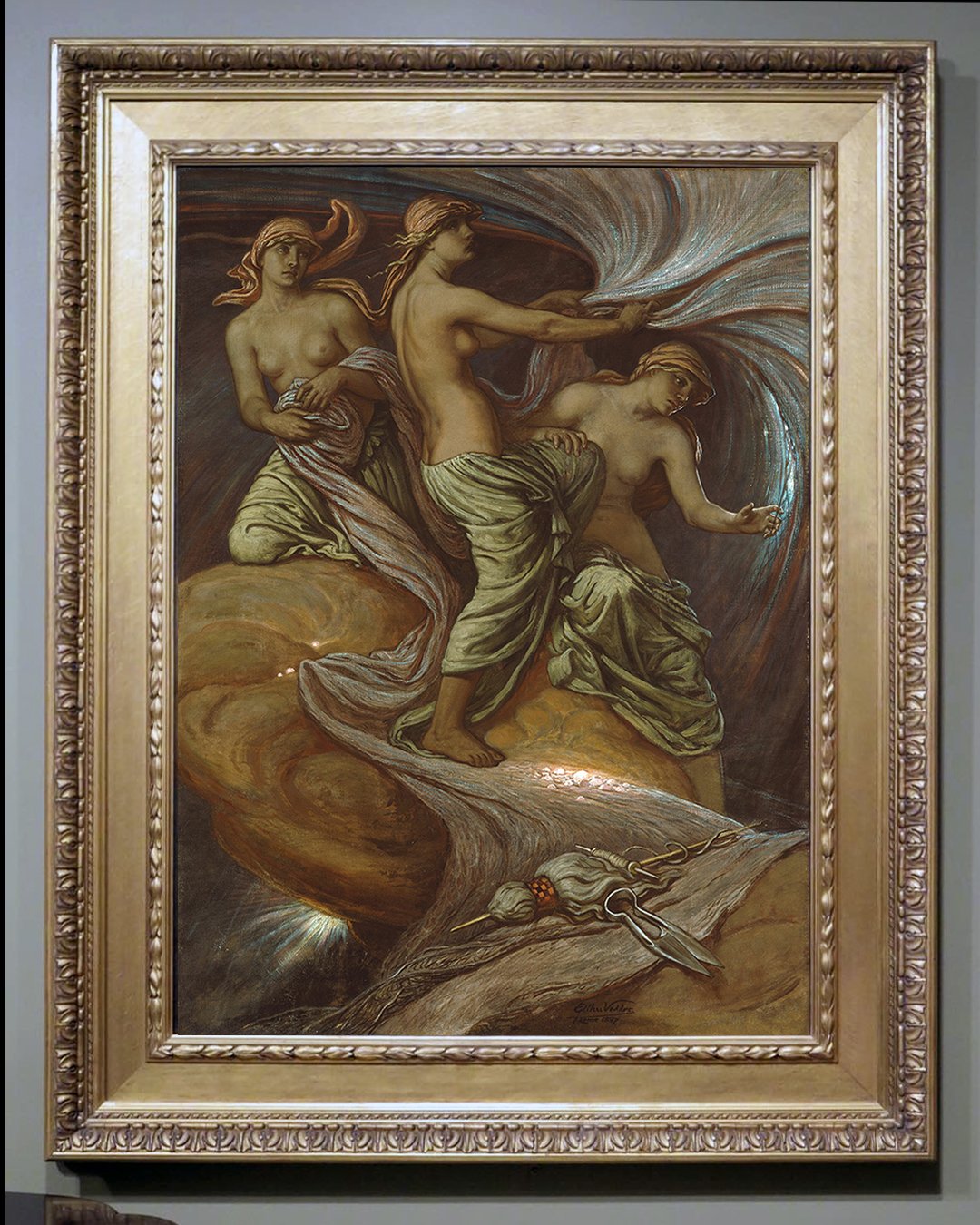
ELIHU VEDDER (1836–1923)
The Fates Gathering in the Stars, 1887, oil on canvas, 44-1/2” x 32-1/2”. Period c. 1880s-90s English Watts-style painting frame; gilded applied ornament top and sight edges, flat gilded oak frieze, molding width 6-3/4 inches; torn paper label verso: CHAS. A. JACKSON / Fine Art Dealer, / Carver and Gilder, / Picture Frame Manufacturer. ... "Elihu Vedder adapted this painting from an illustration he designed for an 1884 edition of Edward FitzGerald’s translation of The Rubaiyat of Omar Khayyam. An expatriate artist who lived in Rome for most of his life, Vedder was attracted to mysterious, visionary subject matter. The artist used the Rubaiyat to express his own philosophical beliefs regarding such metaphysical and spiritual questions as death and the existence of an afterlife, subjects that are at the core of Khayyam’s poetry. This image depicts the three Fates of Greek mythology—Clotho, Lachesis, and Atropos—working the thread of life. Clotho spins the thread, Lachesis fixes its length, and Atropos cuts it at the appointed time of death. The Fates are symbolized by the spindle, distaff, and shears in the foreground and represent the poet’s belief that mankind has no control over destiny.” —museum label Painting: Friends of American Art Collection
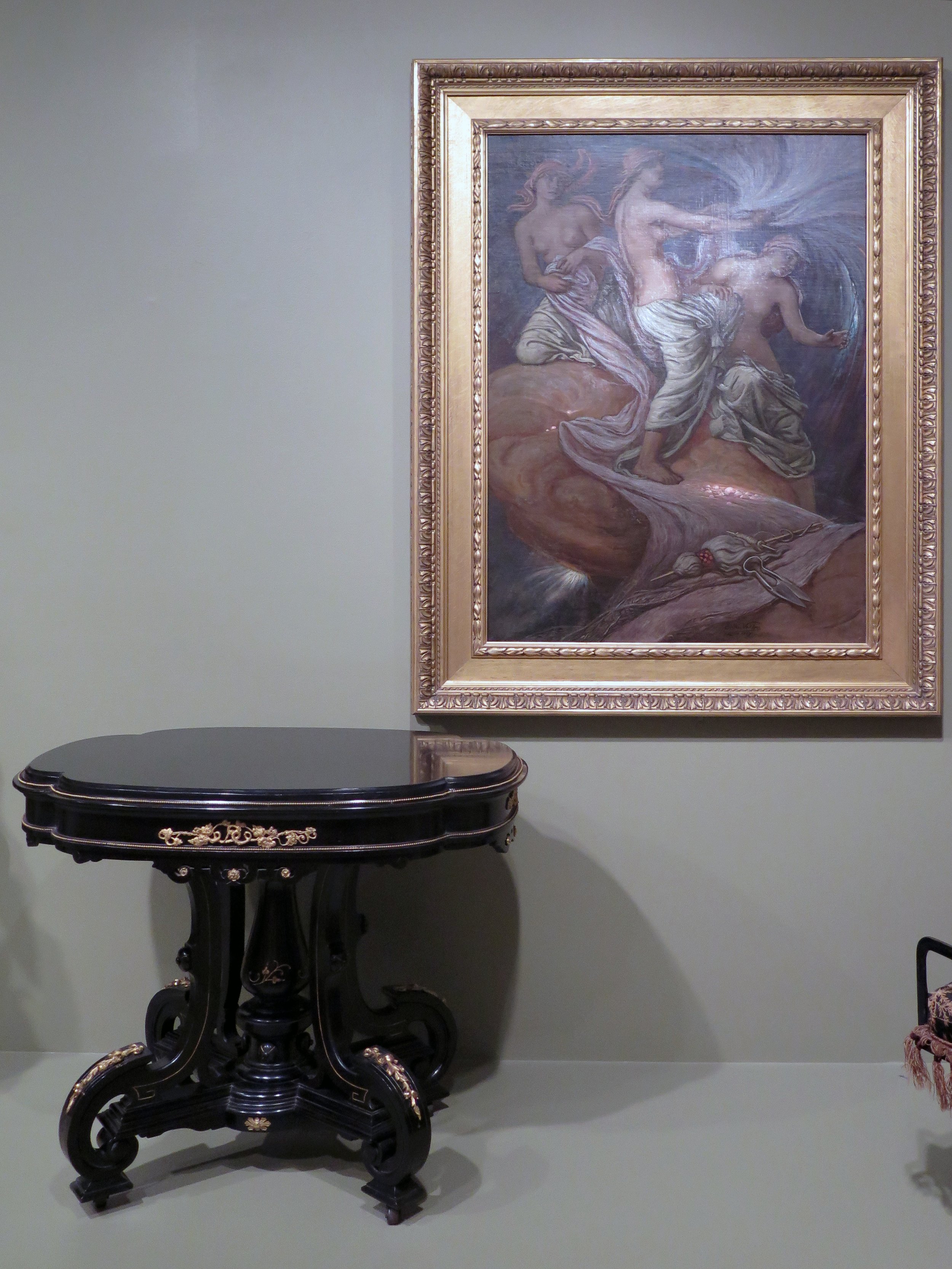
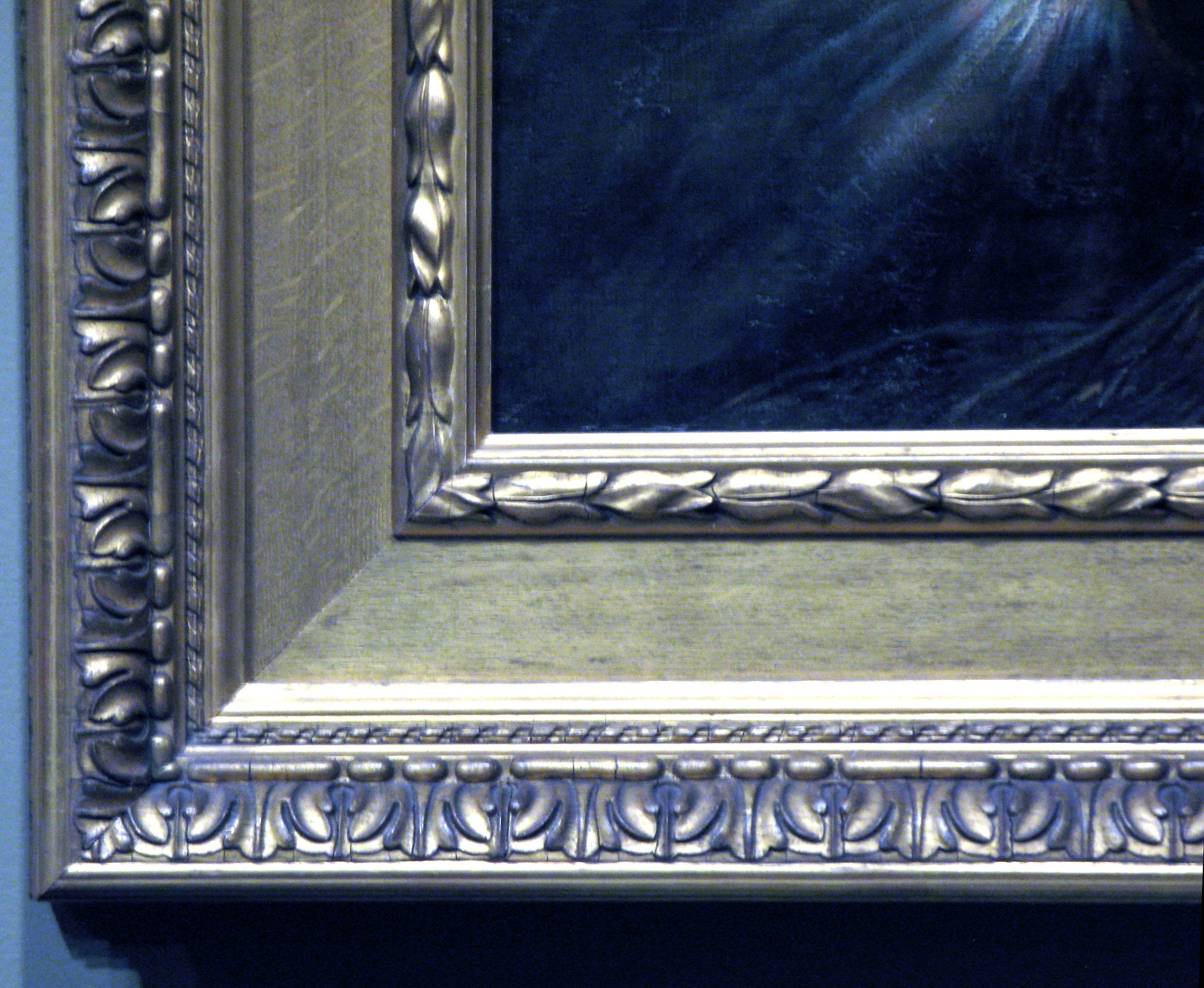
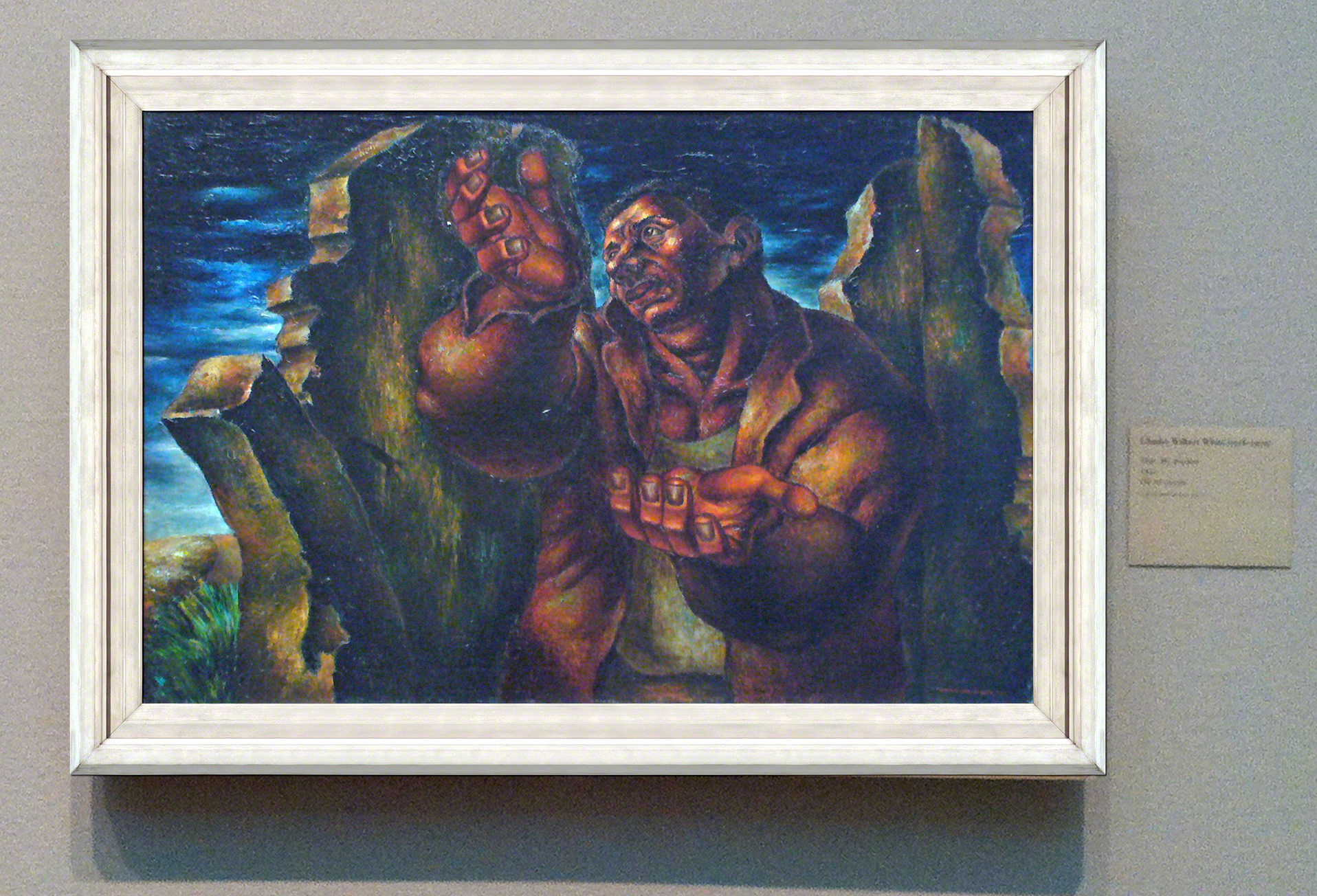
CHARLES WILBERT WHITE (1918 – 1979)
This, My Brother, 1942, oil on canvas, 24" x 36", c. 1930s American Modernist molding, patinated gesso finish on wood, molding width: 2-7/8”, custom-made replica frame fabricated by Gill & Lagodich. "Like many artists of his generation, Chicagoan Charles White believed that art could be an influential force in the struggle to promote racial equality for African Americans, stating, “Paint is the only weapon I have with which to fight what I resent.” He addressed the quest for dignity and freedom in This, My Brother, which takes its title from a poem by John Rood about a rural miner who experiences a political awakening. In the painting, the man appears to break free from a mountain of rubble, alluding to White’s hope that social change could be realized." — Art Institute of Chicago, permanent collection label.
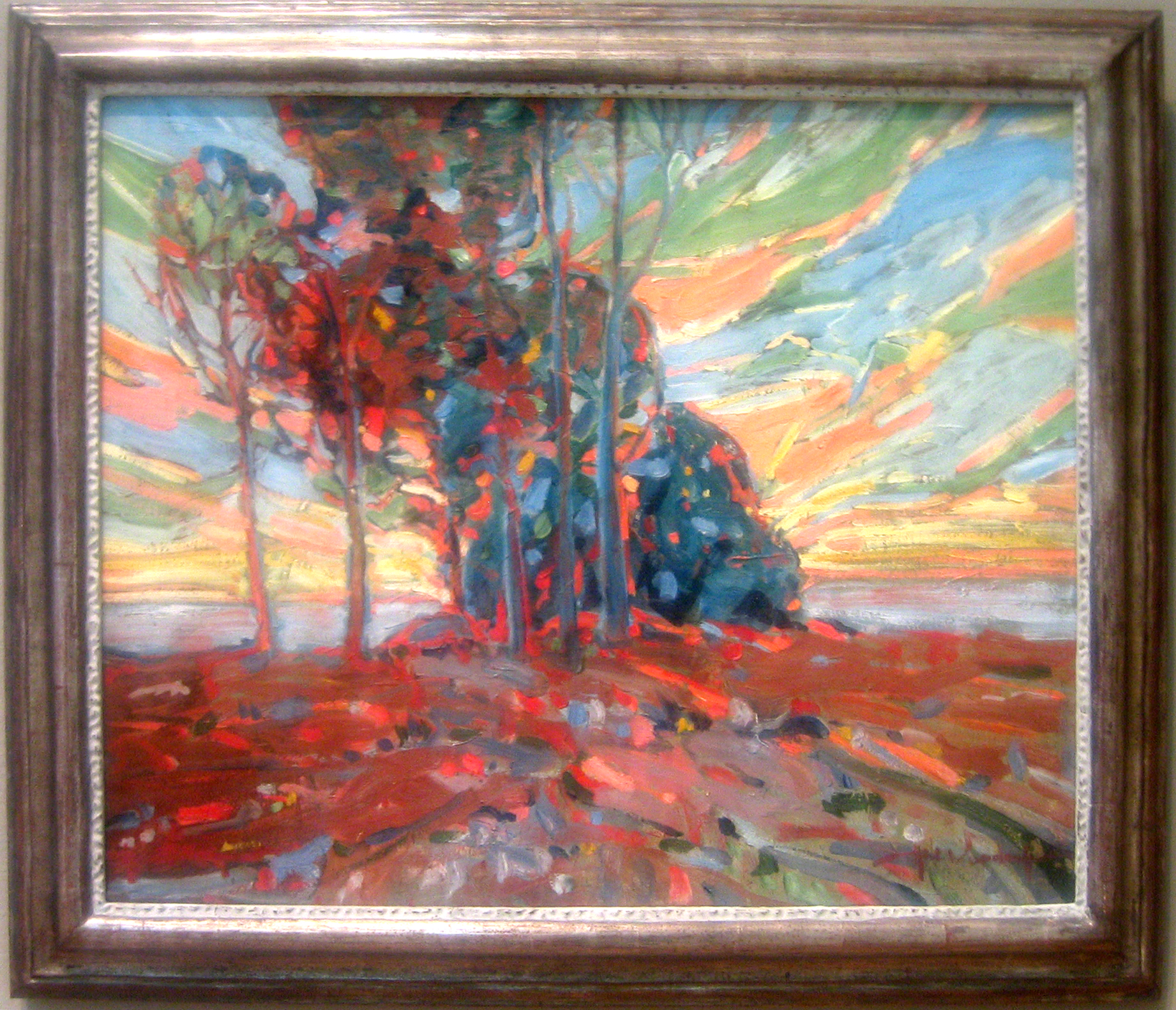
HALE ASPACIO WOODRUFF (1900 – 1980)
Twilight, c. 1926, oil on pressed paperboard, 28 x 32 inches, period frame, early 20th century American painting frame, Max Kuehne, attr. maker, reverse bolection profile, patinated silver-leafed carved wood with gessoed ripple sight edge. Molding width: 3-1/2 inches. "Hale Woodruff was a highly influential muralist and teacher, dedicated to promoting the works of African American artists. Trained at the John Herron Art Institute in Indianapolis and the School of the Art Institute of Chicago in the early 1920s, he chafed at his limited exposure to the latest painting trends. Twilight, one of his early paintings, is an extraordinarily vivid landscape that suggests his desire to define himself as a modernist. A scene of a small grove of trees backlit by an intense sunset, the painting exuberantly evokes the brilliant color of the Fauves. The artist employed assured, fluid brushstrokes to apply bold streaks of pigment, drawing attention to the paint’s tactile qualities. Works such as Twilight inspired the noted Harlem Renaissance author Alain Locke to praise the young artist: “Mr. Woodruff paints landscapes of originality,” wrote Locke, with a “warm beauty” of color." —Art Institute of Chicago, Through prior bequest of Marguerita S. Ritman, 1993.125

MARGUERITE THOMPSON ZORACH (1887–1968)
Landscape (recto), 1911/12, oil on canvas, 23-1/4 x 19-1/4 in. Early 20th-century Modernist frame, gilded and painted beveled profile, molding width 3-1/4 in. "Marguerite Thompson Zorach was one of the first Americans to embrace abstract art, and she displayed her vividly colored canvases at some of the most important early exhibitions of modern art, including the 1913 Armory Show. Thompson spent three years (1908–11) studying in Paris, where she began painting in a Fauvist idiom and met her future husband, artist William Zorach. Although the location in this painting is unknown, Thompson might have made the brilliantly hued canvas while traveling back to the United States from Paris; her adventurous seven-month trip took her through Egypt, Palestine, India, Burma, Malaysia, Indonesia, China, Korea, and Japan. The wedges of color in the painting suggest the contours of a hill, yet their interlocking forms illustrate Thompson’s desire to create compositions that were 'perfectly flat, no planes, distance, perspective, or anything.' "—AIC permanent collection label. Credit: Roger and J. Peter McCormick Endowment
